SUMMER 2025

DRIVEN BY PURPOSE






Quite simply, purpose is at the heart of everything we do at Branson. Not only is it one of our deeply held core values—courage, kindness, honor, and purpose— it is also one of the cornerstones of our mission statement: To develop students who make a positive impact in the world by leading lives of integrity, purpose, learning, and joy.
Purpose is the fire that leads us to do what we do and to be who we are. It’s the what, the why—and the “why not?” Purpose is the engine that drives us to take on challenges, explore new things, push ourselves outside of our comfort zones, ask the tough questions, and ultimately engage in that deep search for meaning that nearly all of us wrestle with at some point in our lives.
There is no one-size-fits-all to what purpose looks like. It can show up in the desire to create big sweeping change in the world, or in the quest to understand one microscopic thing that gives context and meaning to a greater whole.
In this issue, we highlight just a few of the myriad ways that purpose is expressed in the Branson community. We explore in words and images what it means to be an “ethical leader,” leading with empathy and integrity and inclusivity. We visit the Katharine Branson School sixty years ago when female students found themselves at the crossroads between a traditional education and a world in upheaval right outside their doors. We profile individuals who found their spark of purpose in unexpected places—even student field trips to the beach! We meet educators and artists, entrepreneurs and environmentalists. And once again, we feature rich and evocative storytelling by talented writers, illustrators, and photographers who are also Branson alumni and parents.
I hope that after reading this issue you will come away with a little bit of inspiration and, perhaps, a few questions to consider: What is my purpose? What unique gifts do I have deep inside of me to contribute to the world? How can I be the ethical leader? The changemaker? How can I uplift and give meaning to others?
Chris Mazzola, Head of School
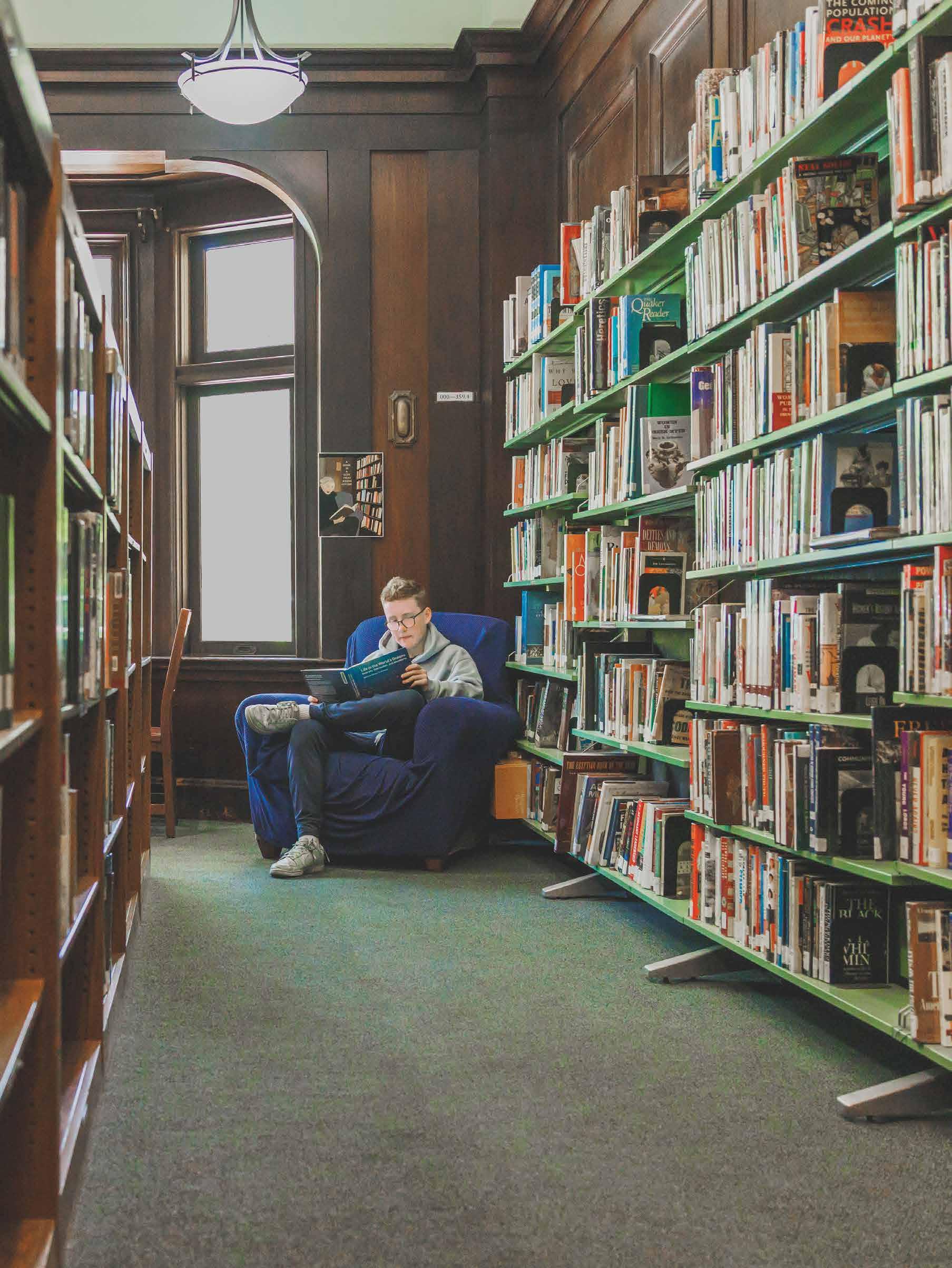
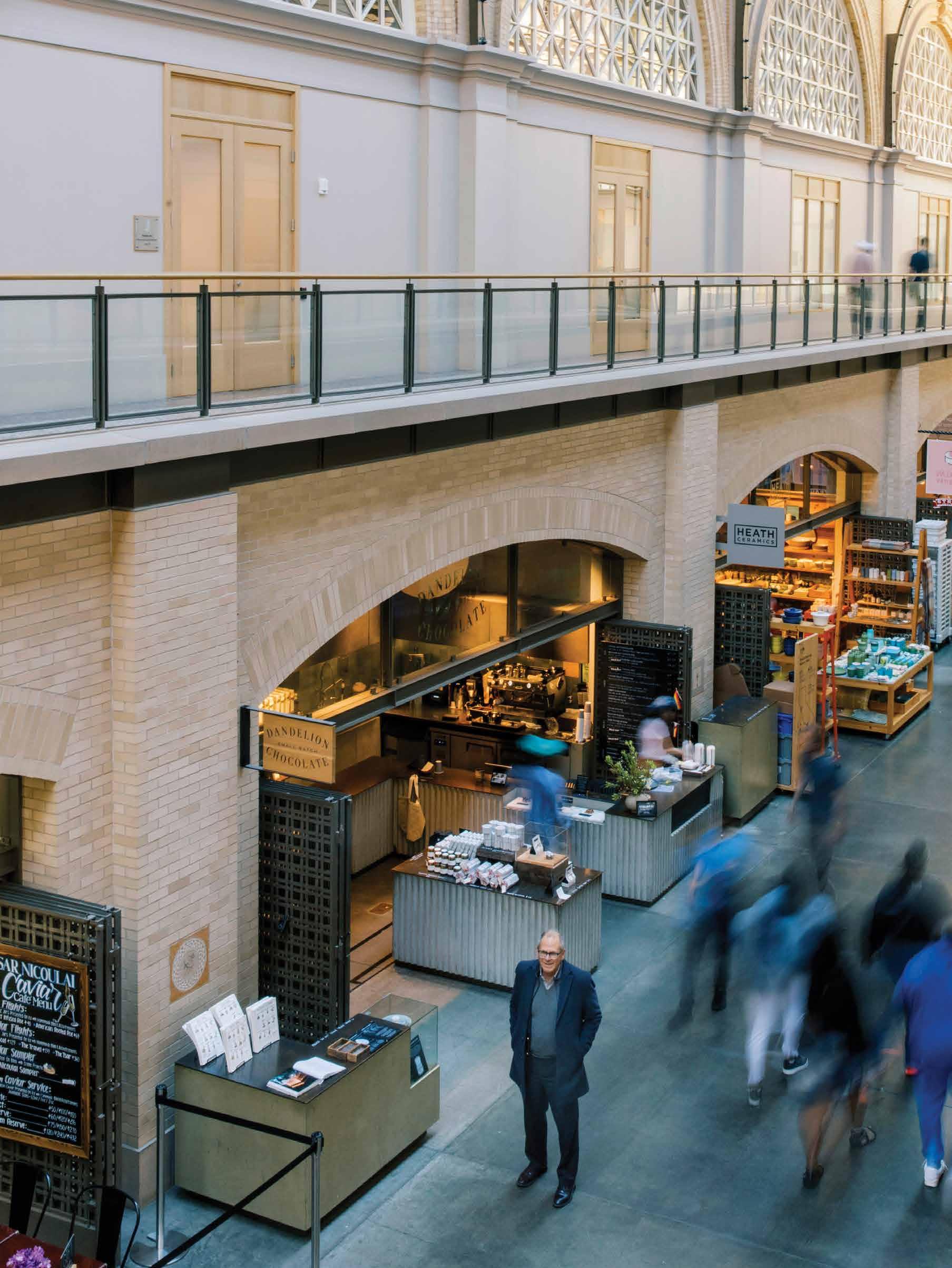
Hans Baldauf ‘77

By Julia Flynn Siler ‘78
On a crisp fall afternoon, Hans Rainer Baldauf ’77 parked his orange electric Fiat 500 on University Avenue in Berkeley, climbed out of the driver’s seat, and walked towards the $300-million Helen Diller Anchor House, funded by the largest gift in UC Berkeley’s history.
The 24-story dormitory has been lauded as a masterpiece that melds aesthetics with an understanding of how to elevate the lives of university students. One of its most spectacular spaces is a grand dining room designed by Hans and his San Francisco-based architectural and interior design firm, Baldauf Catton von Eckartsberg, now known as BCV.
The walls and ceilings of the room are covered with planks cut from a single 250-foot-tall giant sequoia tree that toppled in a storm at Sequoia & Kings Canyon National Parks. The deeply colored wood gives the space warmth. It also embodies a piece of California history.
“That’s one of the reasons I love using old materials in projects,” Hans told me as we toured the complex together. Visiting this project with Hans late last year was a revelation. I’d known him since we were both teens at Branson, but only during that tour—decades later—did I begin to appreciate how much my former schoolmate had contributed to the building landscape of the Bay Area. He explained his decision to use the salvaged sequoia like this: “Because, in a way, you’re not only saving the physical thing, but you’re also harvesting memories.”
Hans’s use of natural materials and focus on the Bay Area’s architectural legacy has helped make him one of the nation’s leading architects. He’s helped design many of the most memorable gathering spaces in Northern California and elsewhere. He’s also played a long and passionate role in shaping the sustainable food movement.
Visitors who come to Northern California to immerse themselves in food and wine have undoubtedly encountered Hans’s work. His projects include the Palace of Fine Arts and the San Francisco Ferry Building Marketplace, where he and his partners designed its iconic food hall and he helped support its famous three-times-a-week farmer’s market. In Napa Valley, his firm designed Cakebread Cellars
and Joseph Phelps Vineyards, as well as Gott’s Roadside—known for its mouthwatering burgers and shakes—which now has six locations in the Bay Area. He also played an instrumental role in the design and launch of San Francisco’s inaugural Slow Food Nation event—the first in the United States—in 2008.
The Helen Diller Anchor House, one of Hans’s most recent projects, drew on BCV’s expertise in building a community around food. His firm took on the role of designing “the food spaces”: the formal Sequoia Room, which can be used for dining, studying, and hosting large gatherings; two catering areas; and a spacious state-ofthe-art teaching kitchen—as well as a stunning rooftop garden with views across the San Francisco Bay.
Hans’s many professional accomplishments spring from an unlikely source. In 1974, when he was a student at the Mount Tamalpais School (MTS)—the school for boys that eventually merged into Branson—he climbed into a VW bus with a group of students. It was this field trip to the beach that would help determine the course of his life’s work.
Hans was born in San Francisco in 1959 to a well-known German-American family. His father, Rainer F. “Bumps” Baldauf was a noted restauranteur and kitchen designer who was deeply involved in the Bay Area food scene. For more than a dozen years, Bumps was the larger-than-life character who animated Trader Vic’s in the 1960s and early 1970s, helping to set up and manage them. He then went on to design restaurant kitchens, including most famously the first pizza oven at Alice Waters’s Chez Panisse restaurant in Berkeley.
He and Hans’s mother, Bea, kept two beehives and lived with their three children, Hans, Lisa, and Karl ’81. It was a full life between family sailing trips to Grindstone Joe’s in the Delta, skiing at Boreal Ridge in the Sierra, and, in later years, spending weekends at Sea Ranch in a home designed by Hans. Raised in a family that closely identified with its European roots, Hans was the first family member not to speak German (his parents and grandparents did.) Bumps died in 2006, just three years after the plaque for the Ferry Building project was unveiled with the Baldauf name on it.
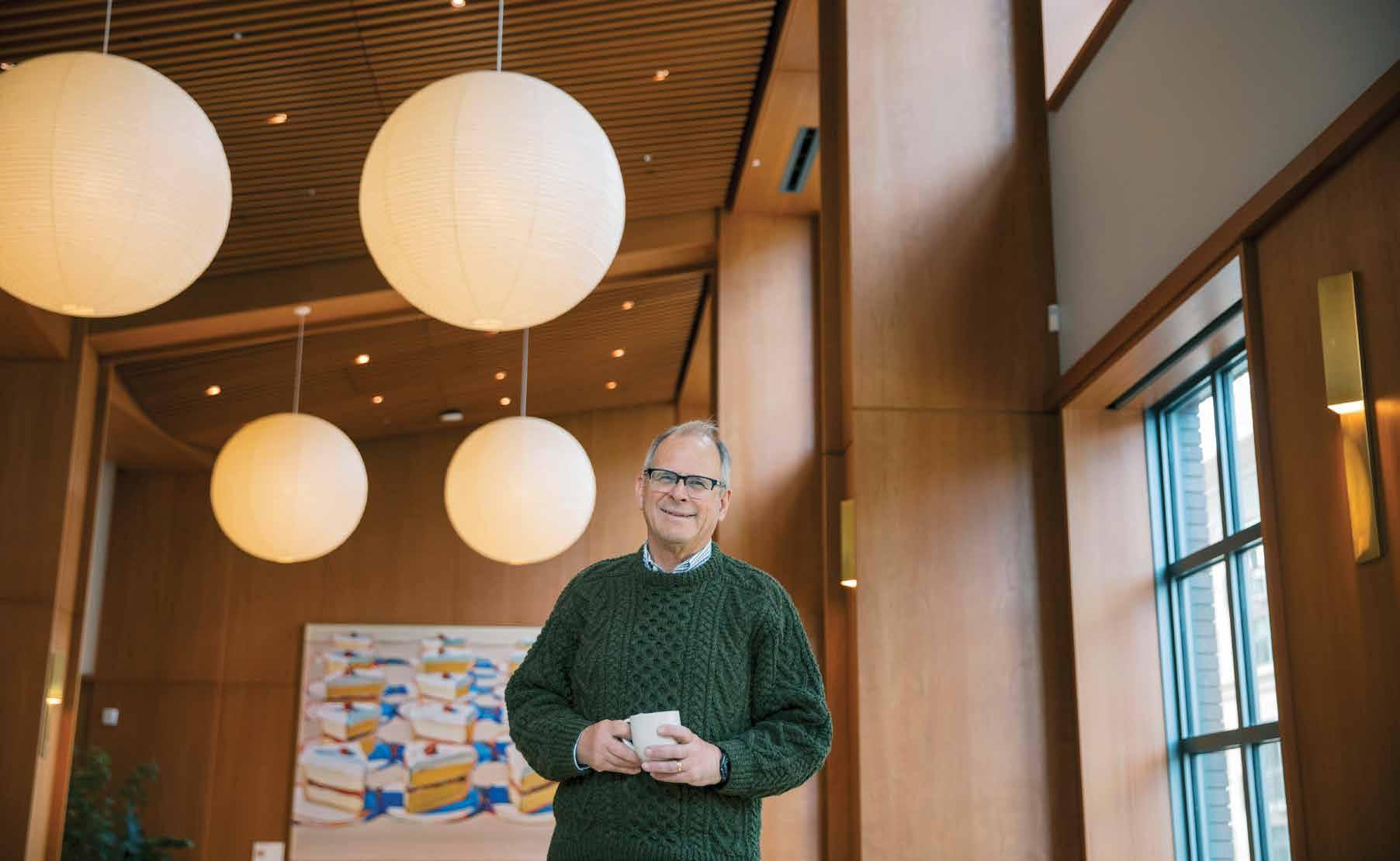
Being the eldest son of a larger-than-life figure who was regularly greeted on San Francisco’s streets by friends and restaurant patrons was complicated for the teenaged Hans, who found it hard to live up to his father’s position as a beloved society figure as well as his achievements as an athlete (Bumps was a champion water polo player at Cal and an avid skier). “One feels these feelings most acutely in high school and [MTS/KBS] gave me a safe place to differentiate [from him],” Hans recalls. The school helped him carve out his own identity: less towards his father’s bonhomie and more toward that of an enthusiastic scholar.
At the Town School for Boys in San Francisco, he quickly bonded with two other boys in his class: Bradley Shavit Artson and Martin Kohout; all three applied and were accepted to the Mount Tamalpais School (MTS) in Ross (the high school for boys that opened in 1972 and that coexisted with what had been the all-girls Katharine Branson School.) Hans, Brad, and Martin joined its second freshman class of boys.
Brad describes the three friends as “a little bit misfits...” who were “a bit zany and didn’t fit the box.” But both Hans and Brad soon found their places on the school’s crew team, rowing five miles a day in a four-person boat on the Corte Madera Creek. “Discovering rowing in high school was huge for Hans,” recalls Martin, who is now president of the Madroño Foundation, a private family foundation that advances social and environmental justice.
Hans excelled academically. He was elected to the Cum Laude Society and was a National Merit Scholar semi-finalist. He also held various school offices during his four years of high school and came to be recognized by other students as a natural leader: they elected him
as one of the two student body presidents his senior year. Hans represented all four grades of MTS while Beth Broomhead represented the four classes of KBS girls.
Hans found his role not only as a student body leader but also as someone who connected on a creative and humorous level with students from all classes. He made a memorable impression at the Fall Festival his senior year with loud, vocal protests as he was carted off to a pretend jail, according to the account in the 1977 yearbook.
His classmate and longtime friend Brad, who is now Dean of the Ziegler School of Rabbinic Studies in Los Angeles, recalls an art project that Hans did which involved him taking plaster impressions of every single student’s face—all four grades—making clay masks from the molds, firing them, and then hanging all of them up outside of the main school building from the branches of a large tree. The clay masks acted like chimes. It was an act of inclusivity.
“No one said no because it was Hans,” recalls Brad. “That was typical Hans, [to] come up with a project that involved everybody and that made everyone visible.”
It was a field trip his sophomore year, though, that helped Hans find his path in life. He took a Creative Architecture elective with a graphic arts teacher named Gerald “Gerry” Stratford. One November morning in 1974, Hans and his classmates piled into Gerry’s VW Bus for a drive north to Goat Beach, near Jenner, at the mouth of the Russian River. The goal: over the course of the day, build a viewing platform to watch the sunset together using driftwood and other found items.
“Gerry had brought all these sledgehammers and gigantic nails,” as well as ropes to lash everything together, Hans recalls. They selected a sand embankment for their site and dragged driftwood up to it. The rather pompous title of their project—“The Structure for the Observation of the Descent of the Sun”— belied the sheer fun the students had that day in erecting a trapezoid-shaped, threestory structure with flooring.
A black and white photograph from the trip, which appeared in the 1975 Nexus yearbook, shows several class members perched on the upper part of the structure. They seem to be lashing together the upright timbers, which were about 25 feet high, to the cross beams, with smaller pieces of driftwood serving as the flooring. This happened around the time Christo and Jeanne-Claude were building their running fence across the hills of Sonoma and Marin (a world-famous art project that would be completed two years later, in 1976.) The Goat Beach school project and the Running Fence took place during a period of heady artistic fermentation in Northern California.
“It was extraordinarily creative,” Hans recalls, “to just go out there and make stuff in one day.” Returning with his eight classmates after sunset, after having eaten a chili dinner that they warmed up over a fire on the floor of their architectural creation, they arrived home happy and wet.
Hans’s most powerful memory of the experience is the unalloyed happiness he felt while building something. His insight that day? “There’s so much joy in the physical making of things.”
He also soon realized he could purchase a whole house in New Haven for less than the cost of a car. So, as a junior, he went ahead and did just that—fixing it up, living in it, and eventually selling it for a profit. While still an undergraduate, he and five other students also organized a conference examining the economic and social challenges facing the city. While still living in that home, he earned a master’s degree in architecture from Yale in 1988.
His crew experience at MTS/KBS led, in a roundabout way, to his first paid job as an architect. After rowing on the Corte Madera Creek in high school, he joined Yale’s storied rowing scene with the lightweight freshman crew. By his sophomore year, Hans stepped up to the position of managing the freshman men’s heavyweight team under coach and Olympian Mike Vespoli and then managed the heavyweight varsity teams.
After graduating, Hans was tapped by Yale’s rowing team for an unusual design project: to renovate the historic Gales Ferry boathouse, built in the early 1900s, that was used three weeks a year for the school’s team to train for its annual boat race against Harvard, the oldest intercollegiate race in the U.S. One of the playful elements Hans added to the design was a frieze, capturing the immortal words of Ratty in The Wind in the Willows: “There is nothing—absolutely nothing—half so much worth doing as simply messing about in boats.” The project was Hans’s first paid job as an architect.
From New Haven, he moved to Chicago to work for a firm headed by a Yale architect,
spending a few years there with a short stint as a visiting professor in the University of Notre Dame’s program in Rome, and then returned to the Bay Area and joined a firm headed by the well-known architects Howard Backen and Bob Arigoni.
Eventually, in 1997, he and two partners formed their own San Francisco-based firm, BCV. Hans returned to his hometown and to the place he loved most—pursuing, what he calls, “the fourth generation of the Bay Tradition,” a regional style of architecture from the Bay Area linked to nature, site location, and naturally sourced materials.
A long-time San Franciscan, Hans and his wife Marian raised their two children on the same street near the University of California at San Francisco where Hans’ grandparents raised his father. They still live on that street today.
Over the decades, Hans has played a key role in his hometown’s transformation. His breakout project was to design a new food and retail section on the ground floor for the revival of the San Francisco Ferry Building, the city’s most beloved landmark.
For much of its early history, the Ferry Building was the busiest passenger terminal in North America. Built more than a century ago, in 1898, its soaring clocktower was the first thing many immigrants, seafarers, and commuters saw as they disembarked from ferries, steamers, and other ships.
To no one’s surprise, Hans was accepted to Yale University and headed to New Haven, Connecticut in the fall of 1977. Yale’s urban location was a source of apprehension for some incoming students and their parents because of the newspaper reports of street crime. But for Hans, New Haven’s grittiness was a draw. After taking a design course in which he and the other students were sent out to try to understand local neighborhoods, he ended up appreciating the city’s richness and complexity. “I’ve always been interested in reading cities.”
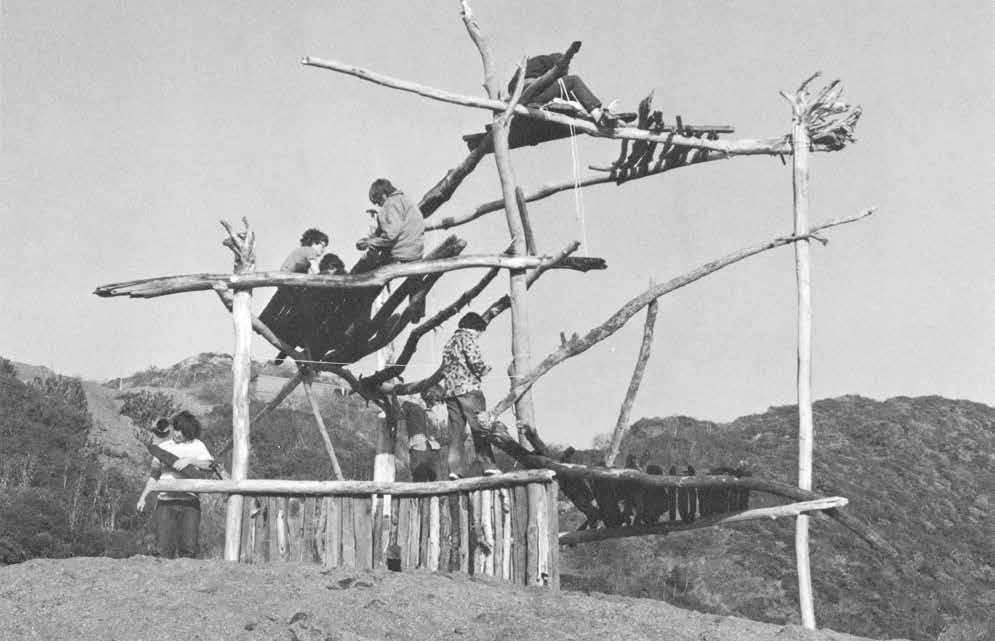
Yet, during the 1970s, the double-deck Embarcadero Freeway hid the elegance of the Ferry Building, blocking much of its light and many of its views of the city and the Bay. The building’s two-story public area, with its soaring interior arches, was chopped up into private office spaces. The lower level— now the food hall—was closed to the public and the area around the Embarcadero was largely devoid of retail and pedestrian traffic, remaining lifeless outside of commute hours. The Ferry Building, it seemed, had become a relic.
The 1989 Loma Prieta earthquake, which toppled huge chunks of the light-blocking freeway that straddled the Ferry Building, created an opportunity to reimagine what it might be. Hans and his partners were part of a team chosen by city officials that did just that over five years. In designing the project’s retail component, Hans and his team took the formal structure of the building—the great nave, or central hall leading out to the ferries—and carried that same design through to the lower level. Echoing the original frieze
of ferry destinations, he recreated that idea but transposed the same idea to friezes of the fames of food-producing towns, or the foodsheds, of the Bay Area. His goal? “Connectivity through the building, which is like connectivity through time and place,” he said.
There were challenges in re-envisioning the 1898 Beaux-Arts building. One that proved particularly aggravating for Hans was the wall tiles chosen to resemble the original 19th century bricks—which, alas, through the firing process, didn’t always line up. Other elements of the design continue to delight him, including the playful mosaic renditions of sea creatures, figs, and other edible plants created by artist Mauricio Arias tucked away throughout the building, like Easter eggs waiting to be found.
Ultimately, his firm’s redesign revitalized the Ferry Building’s retail elements, featuring local and artisan producers, and turning the Ferry Building into one of the country’s preeminent food halls. That project, which concluded in 2003, also helped launch his reputation as one
of the country’s chief architects behind the sustainable food movement.
The autumn day we met, Hans was bespectacled, with a perpetual squint. He wore a professorial grey sweater and button-down shirt. At 65, his age hadn’t diminished his energy or his enthusiasm for his projects. Hans bounded up the stairs of the Ferry Building and then swiveled around halfway up—realizing he’d passed right by the site he’d meant to show me.
We headed back down the steps. Hans gestured with his outstretched hand toward the engraved names of the people and architectural firms that had contributed to its revitalization. Near the top, is “Baldauf Catton von Eckartsberg.” As he pointed to the engraving of his firm’s name on the Ferry Building’s cornerstone, Hans told me a story about Bumps’s reaction to it. “My father always said, “‘Hans, now that you’ve got this carved in here, you don’t need to die anymore. You’ve already got your tombstone!’”
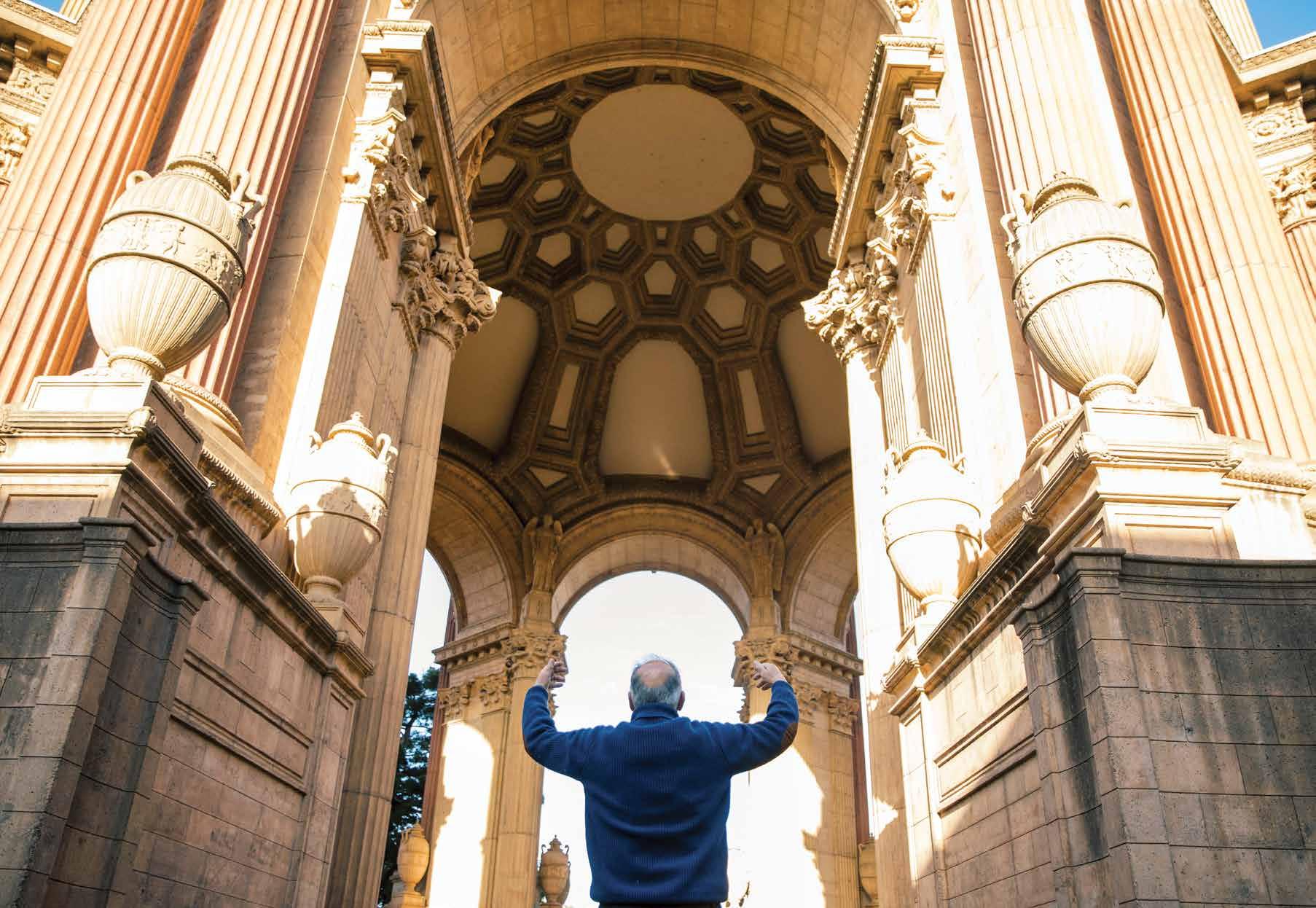
In 2003, as the Ferry Building project was concluding, Hans took on another high profile project—a public-private partnership between the City of San Francisco and the Maybeck Foundation to restore and preserve the Palace of Fine Arts. The Palace was designed by architect Bernard Maybeck for the 1915 Panama-Pacific International World’s Fair and is the only structure from that event that remains. In his volunteer role as Chairman of the Maybeck Foundation, Hans oversaw the $21 million campaign for improvements and also helped to create a master plan to guide future preservation efforts for this iconic landmark. “This space—which Maybeck built on a natural lagoon—is really about the merging of landscape and architecture, and we were trying to restore that,” Hans reflects. “The building was originally built in plaster of Paris, which disintegrated over time, and then was rebuilt in concrete when I was a kid—so our work was, in essence, a restoration of a recreation.”
Hans’s interest in Maybeck stems from his interest in the history of architecture, and history in general, which was nourished at MTS/KBS. One of the elements of the project he’s most proud of was being a part of the effort to have the Palace of Fine Arts registered as a California Historic Landmark. “The process was insanely difficult,” he laughs. “But after growing up in California seeing all those ‘bears’ [CHL plaques bearing the California state flag] on so many buildings, I’m so happy to know that I was responsible for one of them.”
Today, he loves seeing the many people who enjoy the beautiful grounds, as well as the daily stream of weddings and family events celebrated beneath its majestic columns. He points to where the names of donors to the project are etched on the ground. “I think it’s important for children to see their family’s name there. I hope it gives them pride so they too can carry on their family’s legacy as the next generation to support and preserve these historic spaces.”
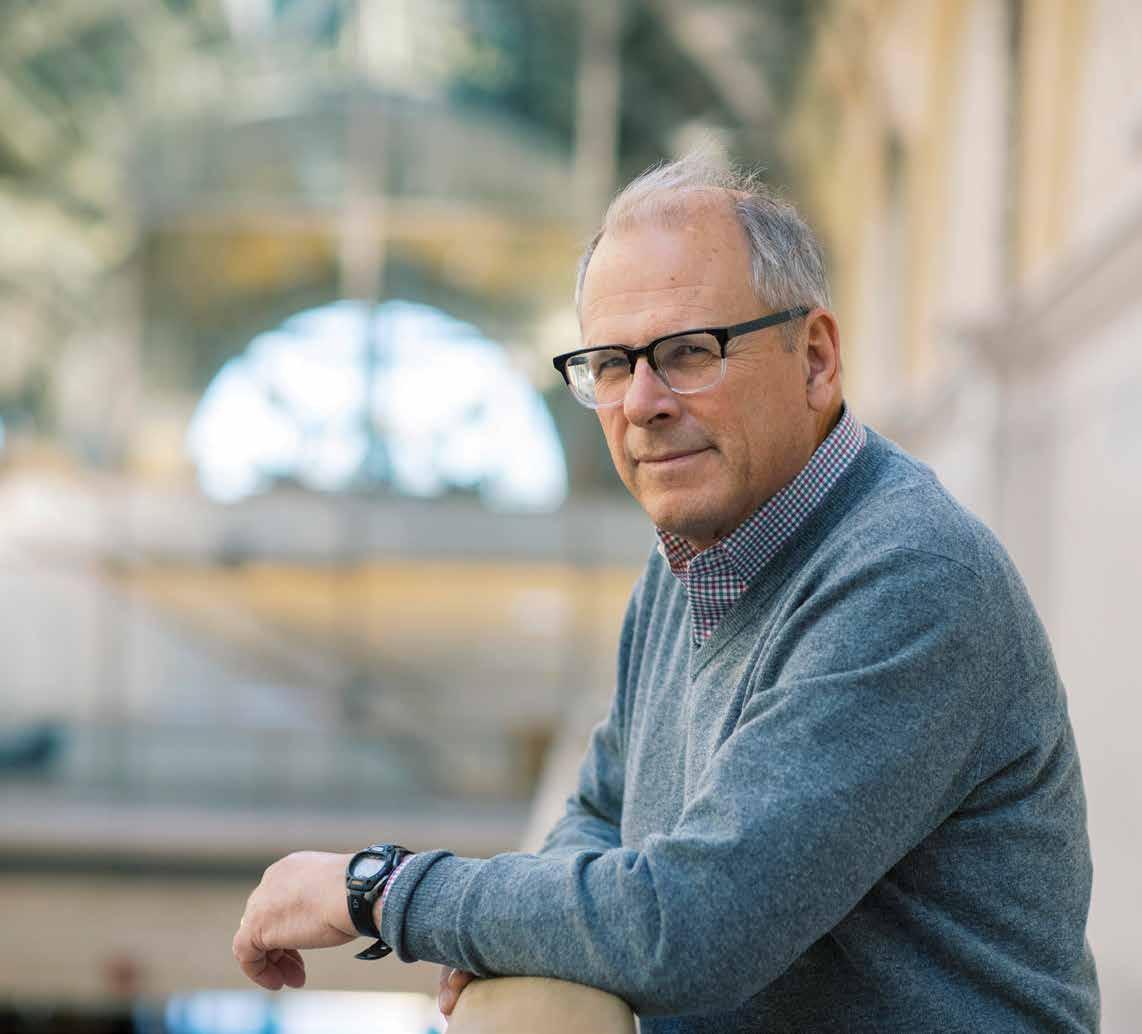
Hans was a visiting scholar at the American Academy of Rome. His project, titled “In the Shadow of Vesuvius—Terroir—Continuity and Discontinuity in Food Culture and Architecture over 2000 Years in Campania” was to explore Italian food culture and the built environment. He wrote extensively about his adventures on Substack—his musings ranging from the people who foraged for pinecones in Rome for the seeds to why guanciale, or cured pig jowl, and pork in general become so integral to Italian cuisine.
Hans’s four years of high school were a formative time, as he began his exploration and study of the Bay Area’s design culture. That life-changing trip to Goat Beach when Hans was only a sophomore helped him find that path that ultimately led him to become one of the people shaping the culture and physical landscape of the Bay Area—and his MTS/KBS friends have supported him along the way.
In recent years, Hans has continued to explore the intersection of food and design. He has often turned to Italy, where his family owns a home, and other European countries, for design inspiration. In the fall of 2023, he and Marian spent ten weeks in Italy where
One example of Hans’s enthusiasm and his ability to synthesize material and make broad artistic leaps is the essay he wrote for Outré West, a book about a group of mid-century architects who did projects in California. Hans’s piece focused on John Marsh Davis, a now-mostly-forgotten, Sausalito-based residential architect with an organic style that emphasized a use of natural materials. As his longtime friend and collaborator, Bonnie Fisher told me, Hans’s immersion in the Bay Tradition is one of the reasons he is “a Californian’s Californian,” with a deep appreciation and understanding of the region’s rich architectural and cultural legacy.
During the pandemic, Hans, Brad, and Martin began Zooming with each other every Wednesday evening to talk about their lives. The three friends were all in their early sixties then and had known each other for more than half a century. Martin called the trio of friends the “Tres Caballeros.” There’s really no substitute for knowing someone that long,” says Martin. “[Their friendship] means the world to me.”
“I draw so much strength” from those friendships forged first at Town and deepened as students at MTS/KBS, said Hans. “I feel so fortunate.”
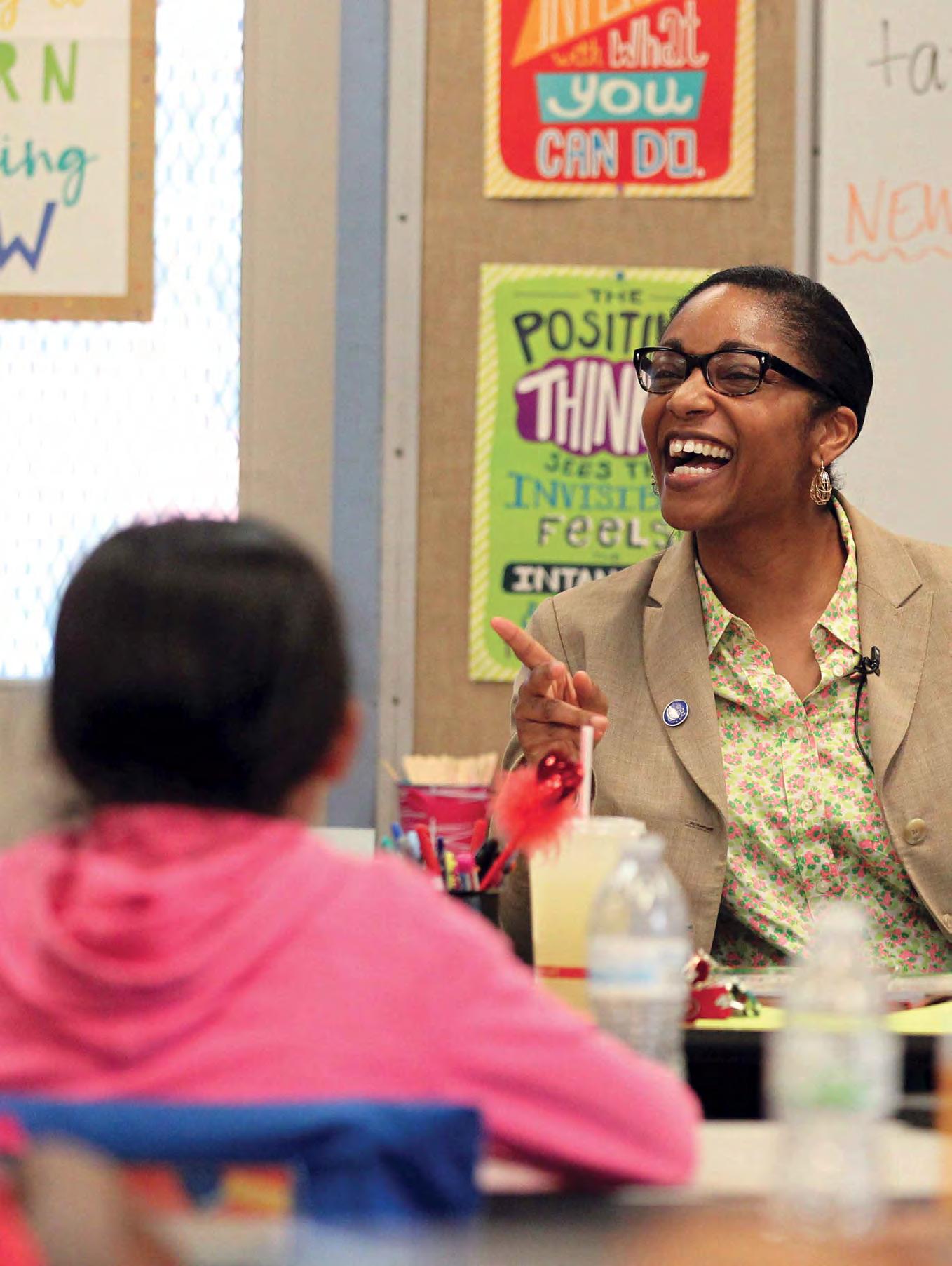
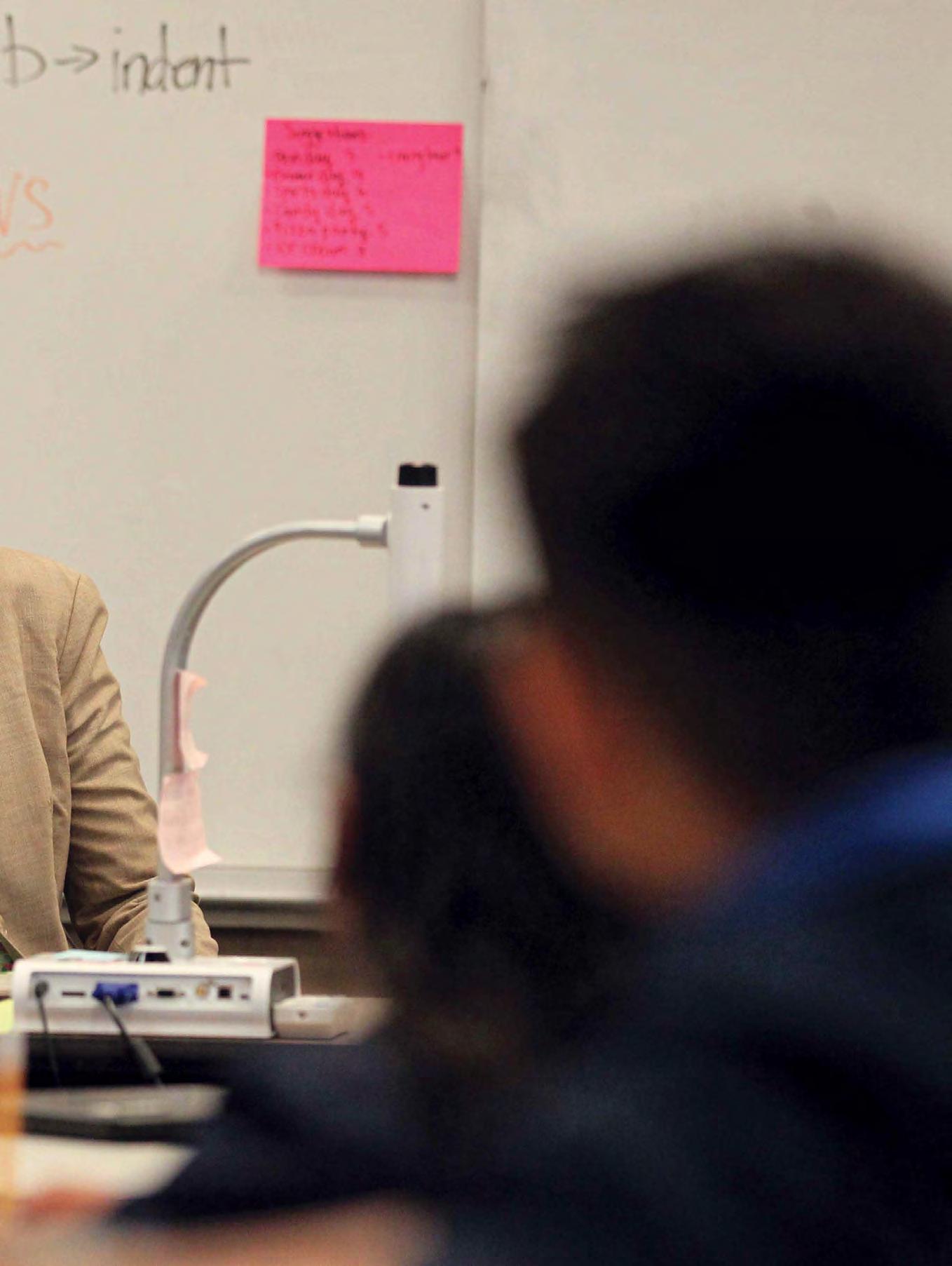
by Jessica Werner Zack ‘87, P’28
As superintendent of the Oakland Unified School District, Dr. Kyla Johnson-Trammell ’94, oversees the education of more than 35,000 students, from kindergarten through high school. With her focus trained on how to best serve so many young people whose lives are bound to unfold in unexpected ways, she says it’s instructive to remember something she learned when still a student herself—that one’s sense of purpose can snap into focus in the unlikeliest setting.
Kyla’s aha moment occurred just a few years after graduating from Branson, during a job interview in the sleek Manhattan offices of a corporate law firm. She was in her senior year at the University of Pennsylvania, with the goal of getting some work experience as a paralegal before applying to top law schools and pursuing the legal career she’d decided on as a teenager. Instead, Kyla’s purported interest in corporate litigation belied a truer, deeper passion for service and community engagement. She just hadn’t yet articulated it to herself.
“At the end of my first interview, the interviewer said to me, ‘You’re more than welcome to have this job, but do you realize you talked the whole time about education and all the things that you do for kids and your community? Have you ever considered being a teacher and going into education? It seems like that’s where your heart lies,’” Kyla recalls.
Kyla, an Oakland native, mulled over the interviewer’s suggestion the whole train ride back to Philadelphia. “Even though I was saying I was on a law track, the words coming out of my mouth were about the things I was truly interested in. I’m forever grateful someone noticed.”
She let her mind scroll back through some of her fondest, most fulfilling experiences at Branson and in college: She remembered cooking meals at a local church in Marin for people suffering from AIDS. “We visited some of them who were dying, or even did die, which gave me a new level of compassion,” she says.
For her senior year project, Kyla, an accomplished pianist and stand-out dancer in Branson’s dance program, taught dance at an Oakland elementary school.
She helped plan one of Branson’s awareness days on tolerance, inviting a former Ku Klux Klan member “who spoke about it being a kind of atonement experience for her. I remember us hugging and it being a very impactful experience for me, and for a lot of people.”
Even as a busy undergraduate in Penn’s Annenberg School for Communication, Kyla got involved with the university’s pioneering University-Assisted Community School (UACS) Program which connects Penn students with the Philadelphia public school system. She tutored incarcerated middle schoolers in the juvenile justice system and helped develop an after-school program for middle school kids on the verge of dropping out. (Kyla now serves on the UACS advisory board.)
She realized, “These were the things that kept me grounded and brought me joy, because they connected me to my larger community.”
With the wisdom of hindsight, she says now that she can see “just how much my purpose had already been planted at Branson. It just took a while for it to sprout up and for me to see the visible blossoms.”
Kyla decided to put law school on hold, at least for a couple of years, and try her hand at teaching.
A third-generation Oaklander whose mother and grandmother were both educators, Kyla moved back to California and got her first teaching job at Parker Elementary in East Oakland, “just two blocks from where I originally grew up. It was such a hard job,” she says, “but I fell in love with it.”
Kyla soon became a principal at Oakland’s Sequoia Elementary, a school with an extremely diverse, economically mixed student body.
“I had caught the leadership bug,” she says.
When Oakland’s superintendent position was turning over, Kyla’s friends and colleagues urged her to apply for the top educational position in the district.
“I thought, ‘No, that job looks crazy.’ And people kept saying, ‘Just apply!’ So I did. And when I got the job, I thought, ‘What did I just do?’” she says with a laugh.
“I didn’t know that superintendent is basically a synonym for CEO!”
Heading OUSD, it turns out, is less about academics and curriculum enhancement, as she’d expected, and “more like running a public-sector company.” Kyla oversees more than 6,000 OUSD employees, 35,000 students (and another 12-13,000 at authorized charters), and a budget of more than $1 billion.
“When I started, I didn’t know how to read financial reports, or how to pass a bond.”
But she’s always been a quick study who relishes a steep learning curve. (“My kids say, ‘You’re such a nerd!’”). “I tackled it the same way I always had in school, all the way back to Branson. I read and read. I taught myself. I sought out mentors. I told myself, ‘I’m going to figure this out.’”
She definitely had her work cut out for her. Kyla became superintendent when OUSD was “in financial despair” and on the verge of insolvency. It had been under state receivership for 14 years. Elementary literacy rates were on the decline, chronic truancy was up, and graduation rates had slipped to 66 percent.
And then the COVID-19 pandemic hit, something for which there were no mentors to guide the way. “There was no playbook, no white paper,” says Kyla.
In March 2020, when California students were sent home for an undetermined period of virtual schooling, only 12 percent of OUSD students had access to technology at home.
Under Kyla’s leadership, OUSD “closed the digital divide. I worked with our mayor (Libby Schaaf) at the time to make sure all of our kids had devices and hotspots. By the time we were done, we were up to 99%.”
Among Kyla’s proudest accomplishments as OUSD Superintendent are the philanthropic and strategic partnerships she’s initiated with Bay Area organizations like Salesforce (expanded computer science classes), Kaiser Permanente (school-based community clinics) and, the one she finds most gratifying, with Stephen and Ayesha Curry’s Eat. Learn. Play. Foundation.
The Golden State Warriors star and his wife have joined Kyla as fierce advocates for the well-being of Oakland’s schoolchildren. They pledged to raise $50 million to upgrade OUSD school playgrounds across the city; have helped with literacy efforts and nutrition services; and have underwritten free, quality youth sports programming for Oakland student-athletes, recognizing the prohibitively expensive cost of travel sports and club teams.
“Ayesha even came out and cooked for some of my nutrition workers, as a way to say thank you to them working so hard during the pandemic,” says Kyla.
Eight years into the job, she says she’s proud knowing that when she leaves her post in July, Oakland Unified will be in better shape than when she came on board. Literacy rates are up. The graduation rate is almost 80%. And the district is set to exit state receivership this summer.
Given where her life and her academic journey began, Kyla says it feels right to have spent her entire professional career giving back to her hometown. She still lives in Oakland with her husband of 20 years and their son and daughter.
She remembers being an eighth grader at Oakland’s Montera Middle School when her parents heard about the program A Better Chance, which helps underrepresented kids of color attend prestigious and rigorous independent schools across the country.
“I looked at Head-Royce, and Hamlin, but when I got to Branson, it just clicked,” Kyla remembers. “Even though it was definitely a sacrifice because we were living near Lake Merritt and my mom had
to drop me off at the BART station at 5:37 a.m., and a van from Branson would pick us up in El Cerrito.”
The days were long, “but I loved the feeling of warmth on campus immediately,” Kyla says.
She especially appreciated the school’s eagerness “to promote inclusivity and make sure all students felt comfortable,” even at a time when the Branson student body wasn’t nearly as diverse as it is today.
“When we had an idea for an organization or initiative, the adults said, ‘Great, let’s help you put this into practice,’” she remembers.
One example is the student group COLORS which Kyla co-founded with Tauheedah Bryant ’95, Africa Williams ’94, and Anndretta “Annie” Lyle ’94. (These four also co-launched the first Gospel Night, which is still going strong today as a beloved Branson tradition.)
“COLORS wasn’t for us few kids of color to isolate, but the opposite—for us to feel more a part of what was so beautiful about Branson, this warm, lovely campus that thrived on excellence,” says Tauheedah, who now lives in Georgia. “Kyla’s the perfect embodiment of that. Her voice is powerful, but she’s warm. She’s the best of us, really.”
Kyla remembers Brenda Brown, Branson’s retired longtime librarian, as a faculty member who “always made me feel seen and welcomed.”
“I have followed Kyla’s career all these years, and it didn’t surprise me at all that she reached one of the pinnacles of her profession,” says Brenda, who was dean when Kyla was a student. “I know she has it in her to go even further. Even as a freshman, Kyla had this extraordinary presence. She seemed very mature, extremely dedicated, and was just an all-around kind, thoughtful, generous person.”
Erin Garvey, ’94, who works in communications for PG&E, recalls becoming “fast friends” with Kyla freshman year. “She had this spark and would light up a room. It can be hard sometimes navigating between two different worlds, but Kyla went between Oakland and Branson so smoothly and with grace.”
Erin shared a story about seeing Kyla again after several years at a big OUSD event in Oakland that she attended with PG&E’s CEO. “There were politicians and luminaries from the community there, but everyone was excited for Kyla to show up. She was sort of the guest of honor. When people were going up to greet her, she looked over and saw me, swoops over, grabs me in her arms, and swings me around. She won’t let go of me, and we’re hugging, and my CEO is standing there going, ‘What is going on?’ It was hilarious, and it was so Kyla. Of course, then she delivered this speech that knocked everyone’s socks off. She’s a superstar. There’s really no other way to describe her.”
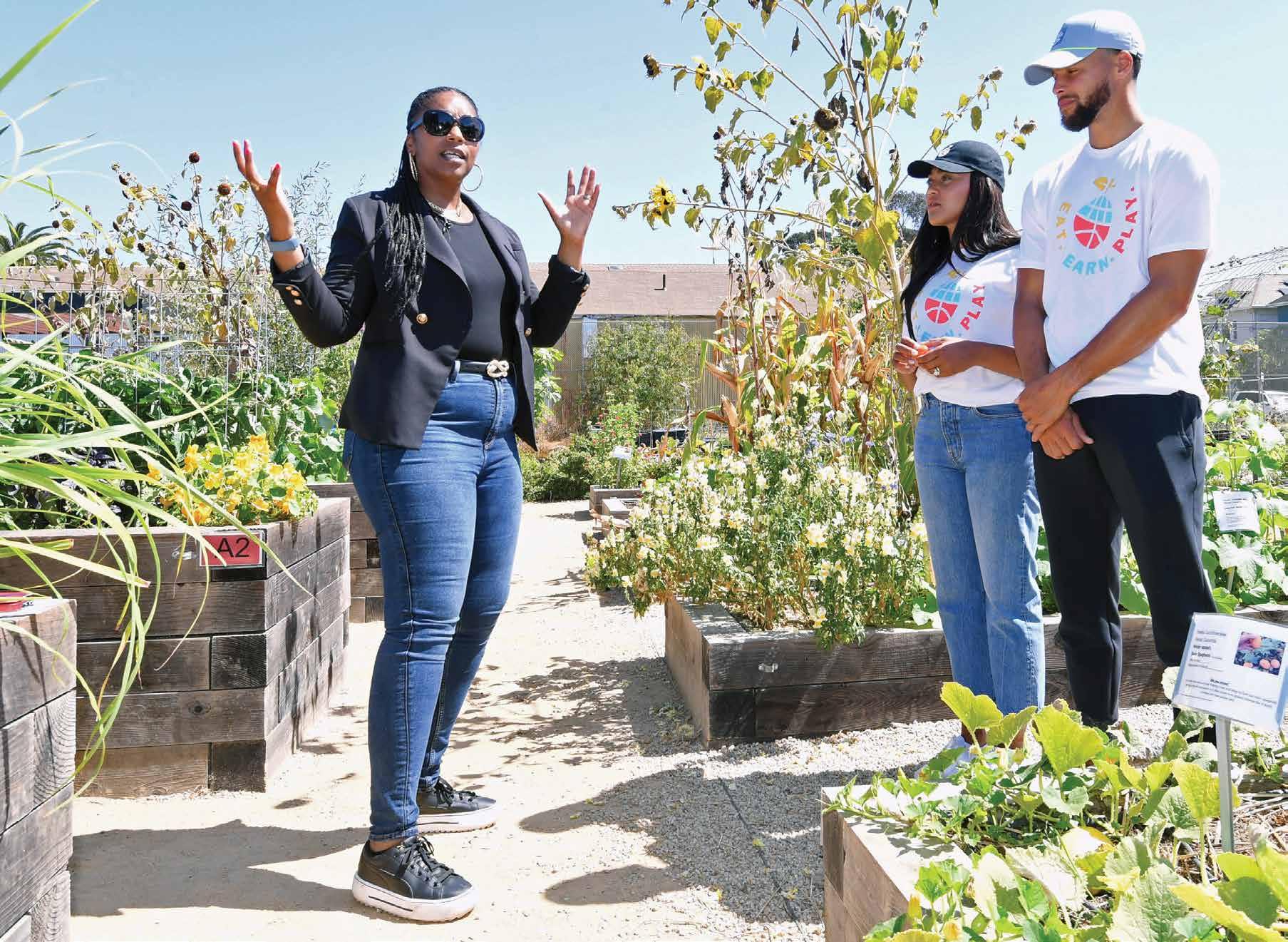
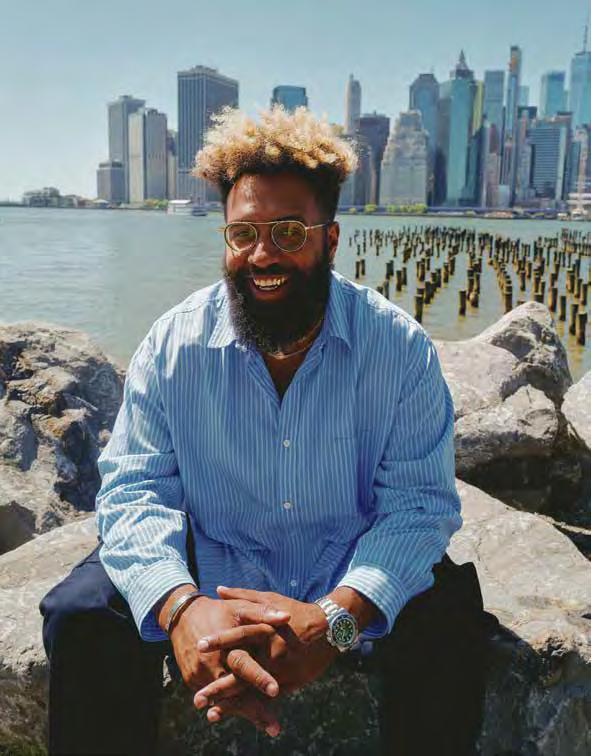
By Andre G. Gray ‘05
So my high school asked me to write about ethical leadership, right…
Somewhere between my general knee-jerk rebelliousness and my academically cultivated “play devil’s advocate” approach to most conversations (that admittedly started at Branson and was greatly accelerated at Amherst College where I was a Black Studies major), my gut is calling bullsh*t. It did when I first got the assignment, when I spoke with Chris Mazzola, the Head of School—all of it.
Ofc1 ethical leadership. I believe in it, try to practice it (quite unpopularly so for the most part), and wish to see it more in the world. So if it’s a yes or no question about ETHICAL LEADERSHIP, my answer is an expletive-filled YES. But when it comes to ETHICAL LEADERSHIP AT BRANSON—the picturesque prep school tucked into the hills of Marin County, my question is a resounding “BUT WHY THO?”
To answer this question, I interviewed Branson leadership and several students, and had conversations with other faculty and alumni. Needless to say, this journey was equally interesting, revelatory, and—dare I say—surprising???
1 Of course
Let’s start at the beginning: What is ethical leadership?
Ofc when I say “ETHICAL LEADERSHIP,” we all kinda get it. As Nyanza Ngongoseke ‘26 put it, “ethical leadership is being a leader, it’s hard to describe, but you just kinda know.” I think we all kinda know. Harvard defines ethical leadership thusly: “Ethical leadership involves leaders and managers making decisions based on the right thing to do for the common good, not just based on what is best for themselves or for the bottom line.” Branson’s website defines the school’s mission as “Branson develops students who make a positive impact in the world by leading lives of integrity, purpose, learning, and joy” and follows in their publicly available Branson Strategic Plan that “Students cannot meet their potential as empathetic, effective, and ethical leaders without meaningful and authentic connections with people from different backgrounds who have different stories and skills to share.”
The idea that leaders should be moral isn’t new—think of philosophers like Plato or religious teachings urging rulers to be just.
In modern times, Robert Greenleaf’s servant leadership first crystallized this concept. He argued that true leaders serve first, asking, “Do those served grow as persons and what is the effect on the least privileged in society? Will they benefit or at least not be further deprived?” Branson even goes so far as to reference Dr. Martin Luther King Jr.’s idea of the “Beloved Community,” where “justice, equal opportunity, and love for all fellow human beings, where all members are important and interconnected,” and states that Branson “seek[s] to model diversity as excellence.” These are big, big lines in the sand, particularly when we look at history, as well as today, and as we see that as a society, we celebrate, elect, and applaud many more unethical leaders than ethical ones.
Personally, I’d define ethical leadership as rallying around those who need the most rallying around.
I can say this pretty squarely as a leader amongst leaders in the corporate world. I am a chief creative officer within the Havas network, one of the four largest communications companies in the world. When I got my role, by my own account and research, I was only the 6th Black chief creative officer in the U.S. in the history of the “Big Five” major holding companies. It’s statistically impossible that that happened naturally, given that Havas was started in 1968 and the first soap brand dropped in 1884 in England. But systemically, that tracks. As far as advertising goes, people trust my track record. I have had my campaigns for brands we all use every day—like JBL, Nissan, Ralph Lauren, Uber and PayPal— validated by winning the creative industry’s top international awards, from Cannes-Lions to the Clios. I was also named to Adweek’s Creative Top 100 alongside Janelle Monáe, Amanda Gorman and Lil Nas X and my folks and advertising peers like Shannon Washington and Derek L. Walker.
Getting here has been a Candyland-like journey that took me from San Francisco, where I moved back when I graduated from Amherst, to Paris, just to find a decent career opportunity, to Amsterdam, where I was a global creative director and lead on Adidas global campaigns. That being said, much of the leadership that it took to just lead myself on this path less traveled—which eventually led to leading others and eventually whole advertising agencies across tens of millions of dollars of business—started in high school at Branson. But I’ll come back to me in high school later.
That same need to create space where I haven’t felt it existed has led to teaching grad students about THE BIG IDEA at St. John’s University in New York. It led to me starting the nonprofit Maison Foundation to help more overlooked and historically excluded people find their homes and feel at home in the creative industries. It led to my starting a conference called Blackweek to create a safe space for a real conversation about how culture can drive business that is built to rally around those who need the rallying first, and not the other way around. I always say this, but very broadly—companies are derivative of government, which is derivative of colonialism. As such, they are violent spaces for non-white, affluent, cis-hetero males. They don’t have to be, but left to their own systemic devices, they will be. **INSERT NEED FOR ETHICAL LEADERSHIP HERE** with a million exclamation points.
Now, just because institutions were born from that, it doesn’t mean they have to stay that way. But they have to at least acknowledge their beginnings. Branson is no different—it is an elite prep school in one of the richest towns in one of the richest counties in the country that provides a very specific and sought-after educational experience and environment for 420 statistically exceptional students every year. With that in mind, the “ethical” in ethical leadership in a place like that is something that would, at best, need to be approached consciously and, at worst, need to be fought for. Branson says it wants “students to feel like you can show up at Branson as your authentic self, express your views openly and with dignity, have your differences celebrated, and feel seen and valued both for your strengths and your areas of growth.” I love these aspirations, but what does that look like in practice?
Naturally, I started at the top, with Chris Mazzola, Branson’s Head of School. Highly lauded for her leadership, vision, transparency, and ability to rally around people to create community, I heard a lot of good things about Chris before I spoke with her. Which, if I am honest, made me more skeptical. But I can’t lie, Chris is the real deal. And our conversation convinced me of her vision. Chris has been leading Branson for almost nine years, with vast school experience prior to that. She was honest, open, and real. So much so, I asked her the question directly: “Why? Why build around ethical leadership not only in a time that feels so far from it, but in a school that is in a place that feels equally far and is so much reserved for the privileged few?” When it comes to rallying around those that need the most rallying around, they aren’t the ones that will naturally find themselves at Branson. Not without effort at least.
“You can’t cut corners when working in value-based communities,” Chris said. To her, Branson is contextualized in the larger society—and yes, it is logistically an experience afforded only to the few. But it is an experience that can benefit the many. Quite impactfully so, in fact. We are in a deplorable moment in U.S. education—while as a society we have unprecedented access to a library of Alexandria-sized information in our pockets every day, the majority of the country is still in a school system built on rote learning and testing. Conversely, Branson sets out to teach you to think, with an educational style rooted in liberal arts: “A Branson education encourages students not only to ask questions, but to have the courage to ask hard and uncomfortable ones.”
Branson teaches you to think— not to know the answer as much as to ask the question. And though I have to admit that, way back when I was in high school, Branson was a very different place than it is today, it still had the same roots educationally.
It is still the place that landed me my first published works: “Hair Scare”—a piece I wrote on a whim (and with a bit of encouragement) that was published on Salon.com.
Nathalio Gray would know about back then. He was there. In fact, Nathalio very much got me through high school. Now Branson’s Assistant Head of School for Mission Advancement, Nathalio started at Branson in 2001, the year before I arrived—he was in the admissions office. And as such, his office became a default “no one really told you to hang out here but you know it’s love anyways” space. It’s funny that, looking back, I had to ask another Black alum if his office was officially a multicultural students’ space. It wasn’t. Though it didn’t have the name at that time, I certainly remember it had the function—a place for us, a closed door behind which we students of color could come together, speak freely, and check in. That’s the thing with historic homogeneity: when you have a disproportionately dominant culture in a space, it has the minorities thinking they are crazy. Like there is so much consensus and head-nodding in the dominant direction that when you feel different, you are like, “What? Am I wrong?” Nathalio provided space for me to check that, to go to the National Student Diversity
Leadership Conference, to attend my first African-American Literature class (that he taught) where I read The Autobiography of Malcolm X and learned about The Signifying Monkey and Toni Morrison. These spaces were foundational in empowering me to “have the courage to ask hard and uncomfortable questions”—very much the grounding of my leadership practice today.
That’s not to say we were always in lockstep when I was a high schooler—16-year-old Andre in a XXL Carmelo Anthony satin Denver Nuggets jersey with matching Carolina blue and yellow Jordan IIs couldn’t always appreciate how much Nathalio, and the people like him on the staff of the school, were doing for me. It’s crazy how simply seeing someone as human first can cut through so hard.
Diversity at Branson has been a priority of the Mazzola era—not only in “diversity as excellence” as they say on the website, but also in consciously admitting students to create a more representative student body. That was of particular interest in speaking with students like Nyanza and Sarah Jones ‘26. Sarah is the co-lead of the Black Student Union (BSU) as well as being the manager of the Branson girls varsity basketball team, and she has participated in multiple global education programs at Branson. She is one of the 25-30% of students who commute to school from outside of central Marin County, often across a bridge, as I did. This is something that Chris mentioned in the push for geographic diversity—bringing more students in from the East Bay (like Sarah, who lives in El Cerrito), San Francisco (like me), and also from the North Bay and Sonoma.
When speaking on her role at the BSU, Sarah said, “We deserve everything else that everyone else is getting,” noting that, though we are far beyond the two or three Black students per class of my time at Branson, there is still room to grow. The student affinity groups play a key role in how ethical leadership is brought to the everyday campus experience—nearly everyone I spoke with sang that tune in unison. Branson has created the space for not only affinity groups, but also other intern and leadership experiences on campus, allowing a relatively small student body to be leaders among their peers and the faculty alike.
They make a concerted effort to spread these opportunities around, putting passion at the core of leadership. “I am an introvert, but that has helped me be a better leader. If you are not a good listener, how are you supposed to lead people?” Sarah said.
With all these efforts, there was a feeling of progress, of marching towards a more community-centered and ethical environment. That being said, high school is high school, and there are headwinds. Sarah spoke about areas where there is room for Branson to grow: “Who I am as a person, not feeling like my voice is heard—as a Black person but also as a woman.”
Nyanza told of his experience with Students Shoulder-to-Shoulder, one of Branson’s partners in the Global Education program. With a mission of teaching and practicing ethical leadership, these programs offer Branson students immersive opportunities to volunteer in communities in Kenya, Panama, Costa Rica, and more. Nyanza spent three weeks in Kenya and found that the boys there were much more open, easily speaking on sensitive topics like masculinity and whether men are supposed to cry or not. He reported: “I am actually a really emotional dude, but [here] I try my best to hide it. Obviously.”
Branson’s outdoor education program is equally interesting, exciting, and applaudable—the brainchild of Chris and Peter Zdrojewski, who came to Branson eight years ago after five years at the Island School in the Bahamas (another Branson Global Education partner). In partnership with Outward Bound California, every sophomore class spends five days backpacking in the High Sierra, stepping outside their comfort zone and learning to lead. Peter believes that education is just as important out of the classroom as in, if not more. As Nyanza said, it’s about “hands-on experience. You can learn all this stuff about it, but it’s a totally different thing to go and experience it, and learn what ethical leadership really feels like.”
To be an ethical leader, at its core, you need to believe that anything is possible. That you can create what you know in your gut needs to exist, especially if you don’t see it around you. To lead, “you need to really put yourself in someone else’s shoes,” as Nyanza said. And to do that at a place like Branson, you have to not only make a very conscious effort to get outside of your normal, but sometimes also to get outside of the classroom and the campus. You have to believe that you can move the mountains of systemic odds to create what must be, but is likely not yet. You must have the vision to rally around the new with all the information you can from what is, while ignoring the unnatural feel of what hasn’t been.
I can truly say from first-hand experience, Branson is a school like no other, an opportunity like
no other. And for that place, in this time, to anchor itself on not only talking the talk, but walking the walk of ethical leadership—not
only for the benefit of the students who are there, but so they can go on and inspire the rest of us—I am here for it. Almost makes me want to do high school again.
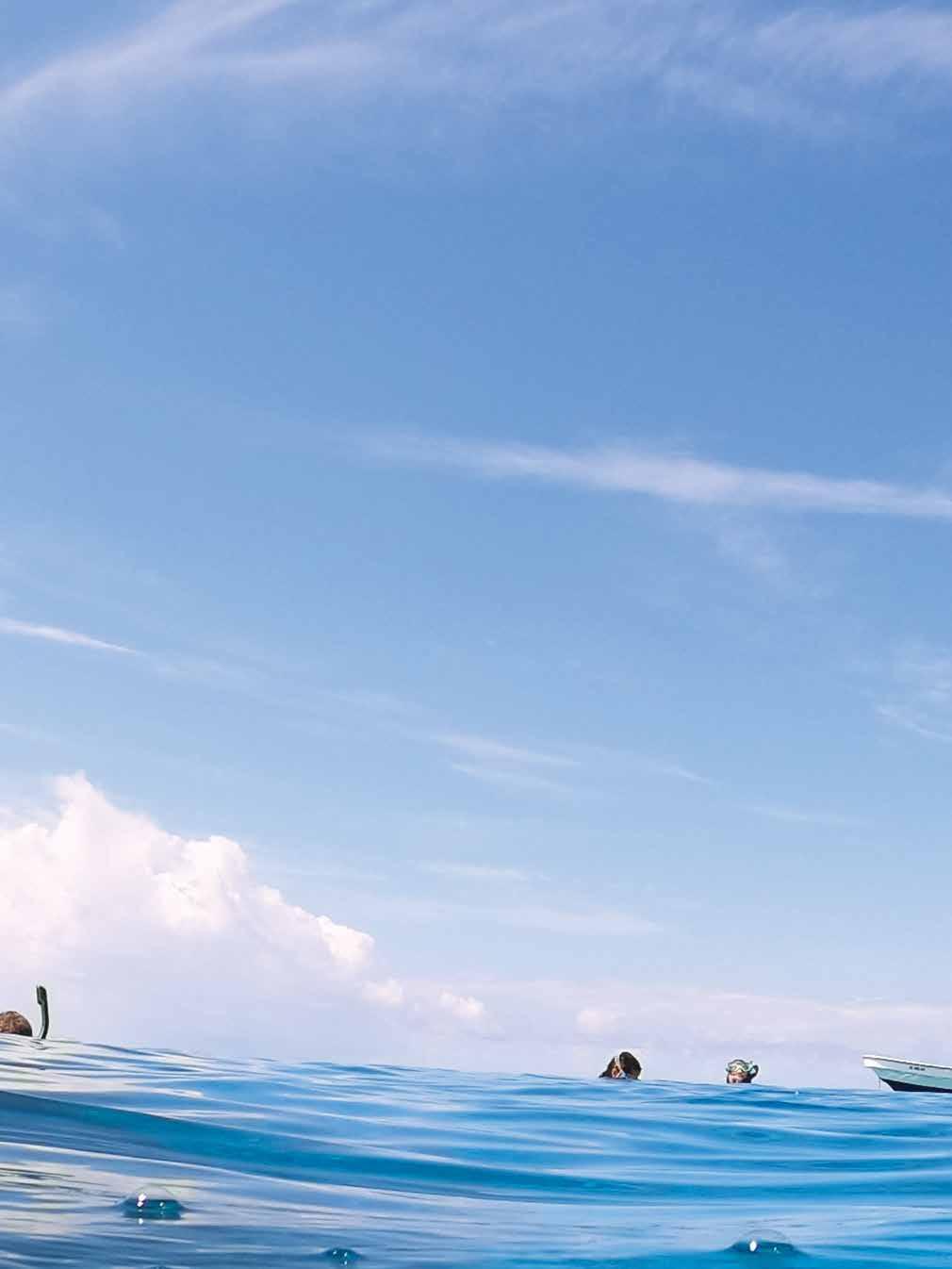
“Our goal is to build skills around leadership, engagement, agency, and passion—and give all Branson students access to these opportunities.”
– Peter Zdrojewski, Director of Global & Outdoor Education
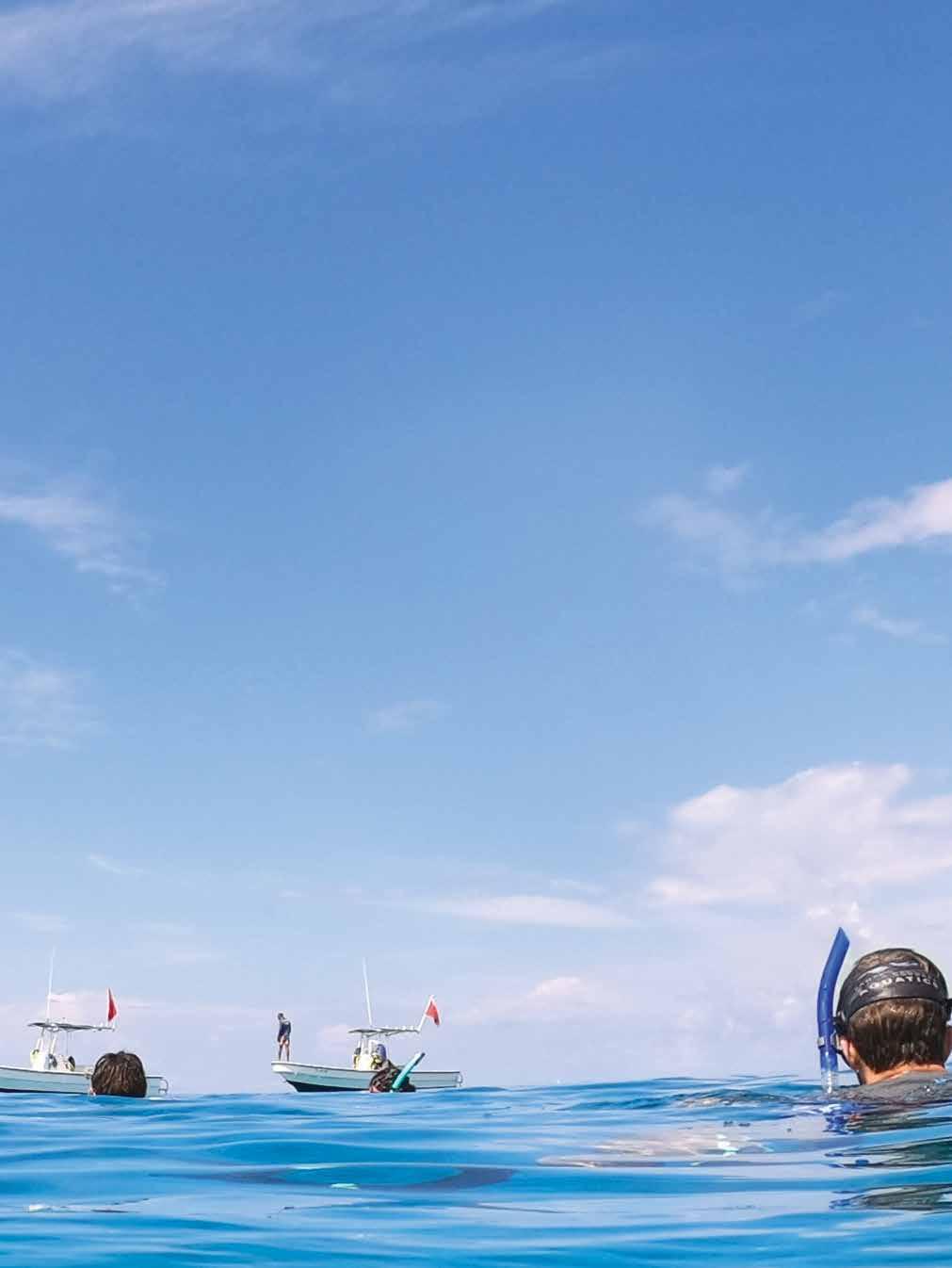
From global education programs that send students out into the world for immersive learning, to outdoor education programs that challenge students to step outside their comfort zone, to internships that stretch leadership muscles on campus, to community engagement programs that connect students with local change-makers—Branson encourages all of our students to become ethical, informed, pragmatic leaders in whatever they are passionate about. Giving students access to break down huge global challenges into smaller pieces demonstrates how localized actions can have a lasting impact and contribute to the larger whole.
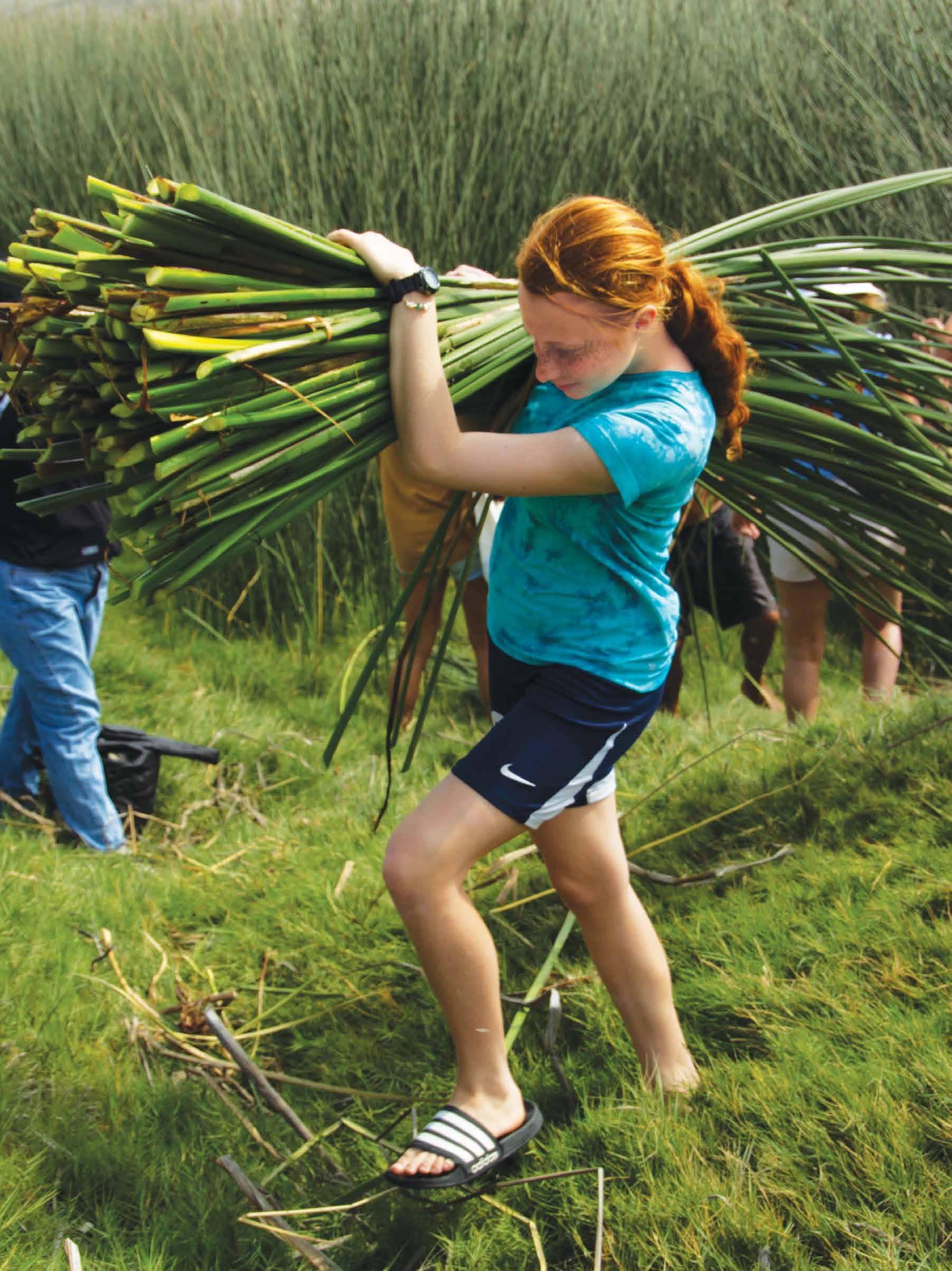
leadership acknowledges the ages-old wisdom of people who have sustainably farmed their land for centuries. Students work side by side with them in communities in Costa Rica, Peru, Panama, and elsewhere harvesting bamboo, sugar cane, and other plants that sustain local communities.
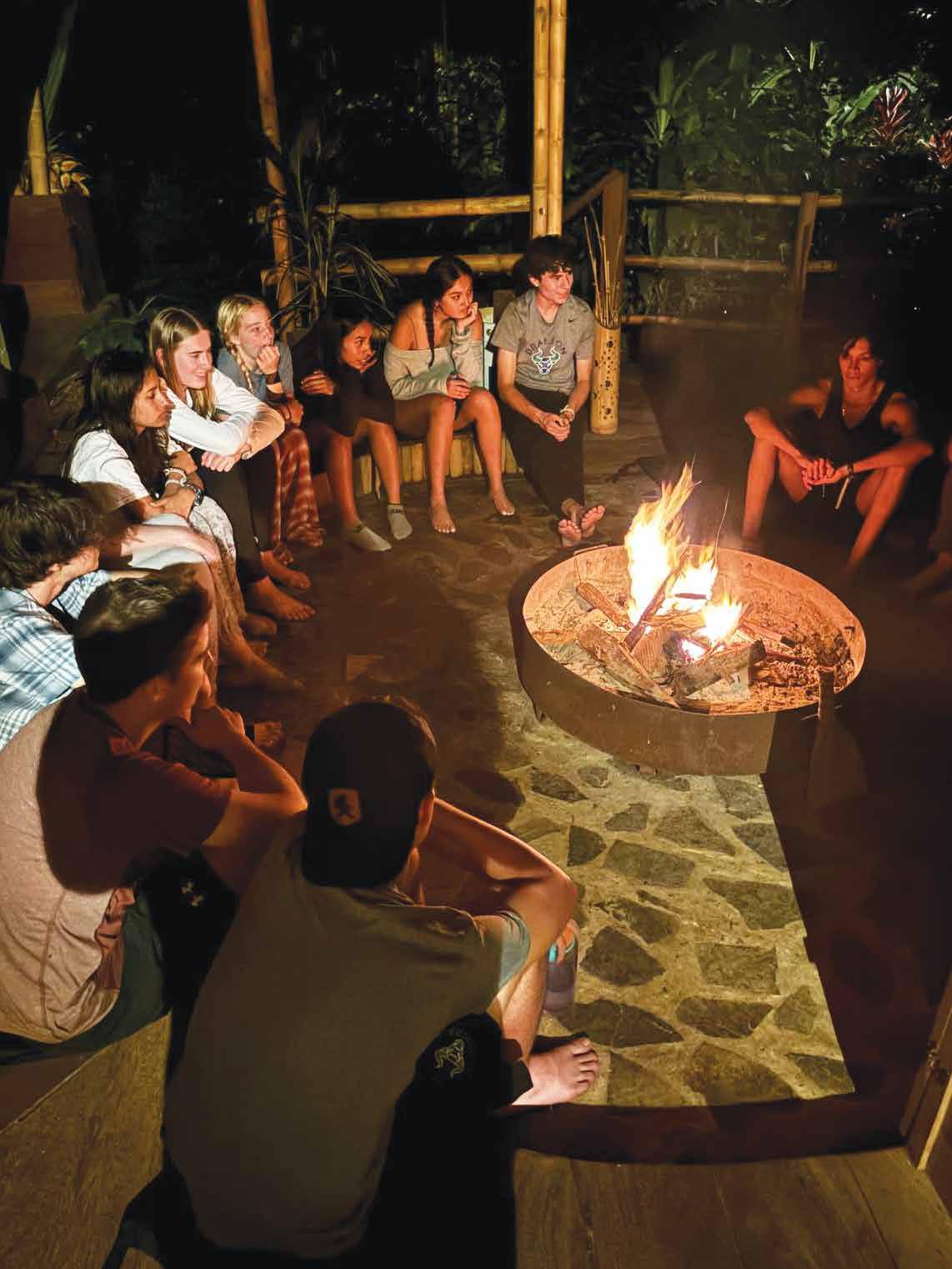
Evening circle time deepens the learning—it’s an opportunity to process the events of the day, contextualize new experiences, share personal reflection, and be in community with each other.
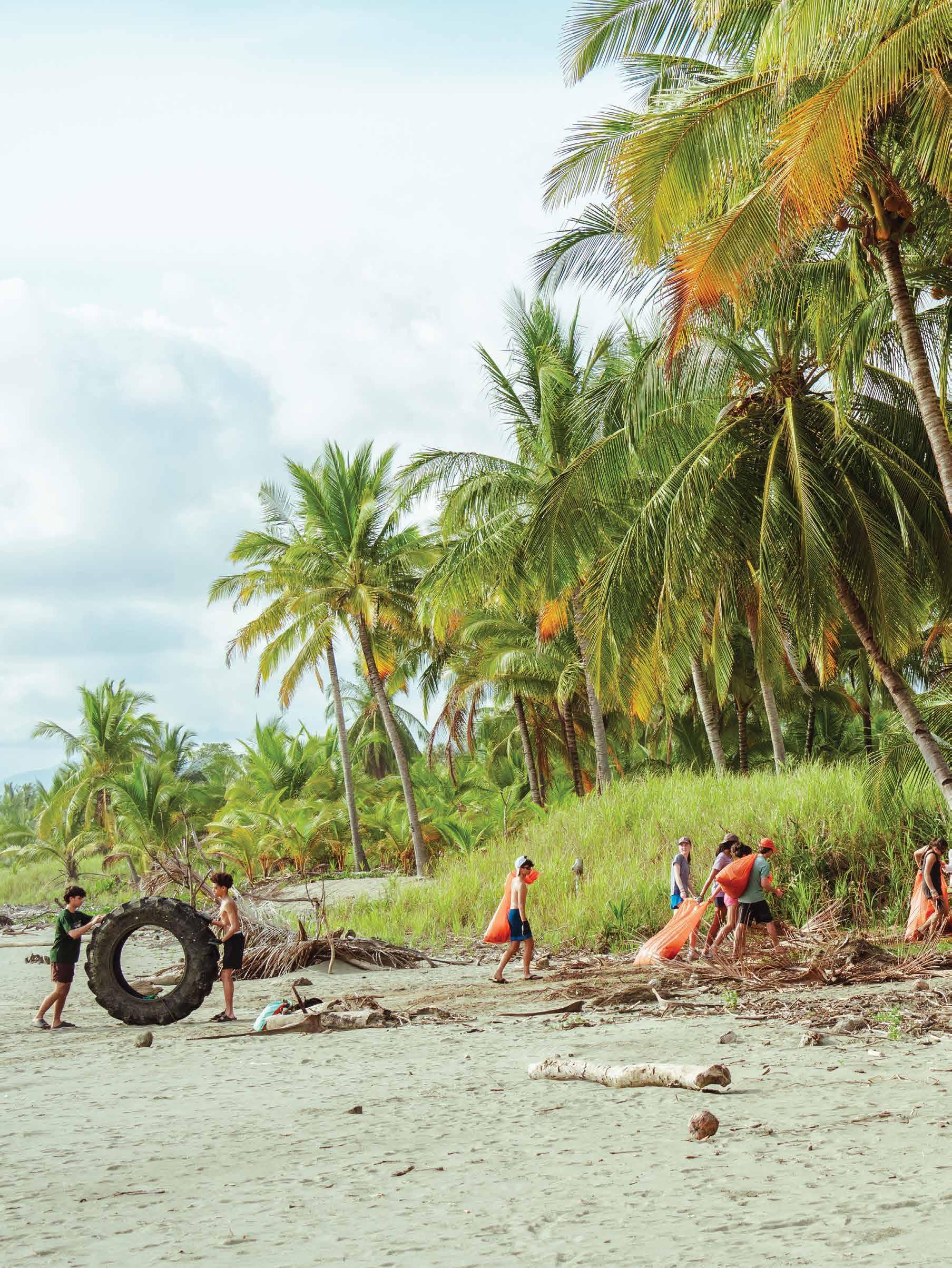
Stewarding the environment is central to each of our programs, whether that means cleaning up trash on Playa Coyote in Costa Rica with Students Shoulder-toShoulder or immersing (literally) to investigate delicate marine ecosystems at The Island School, Branson’s partner in Eleuthera, The Bahamas. (p. 20-21).
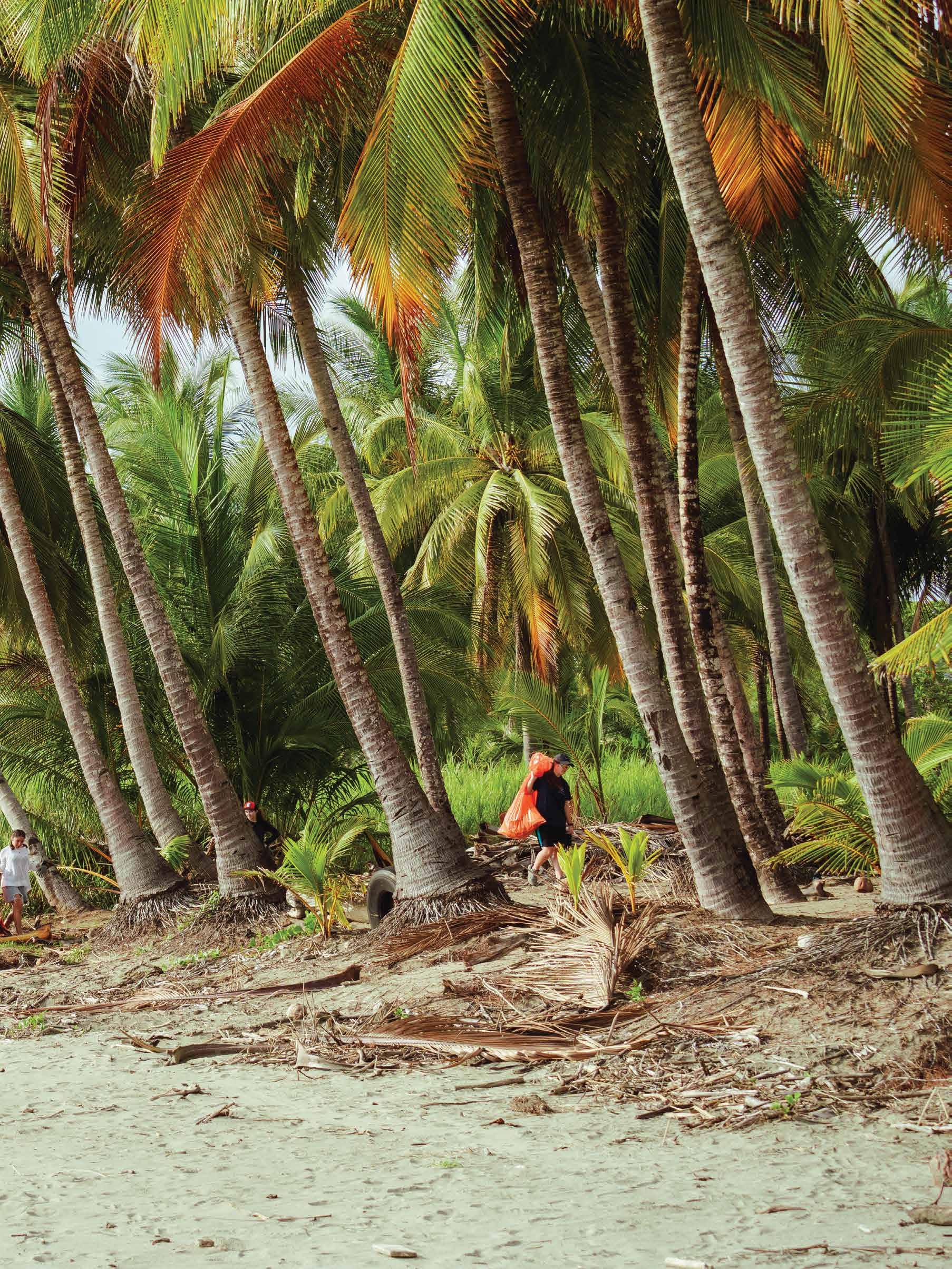
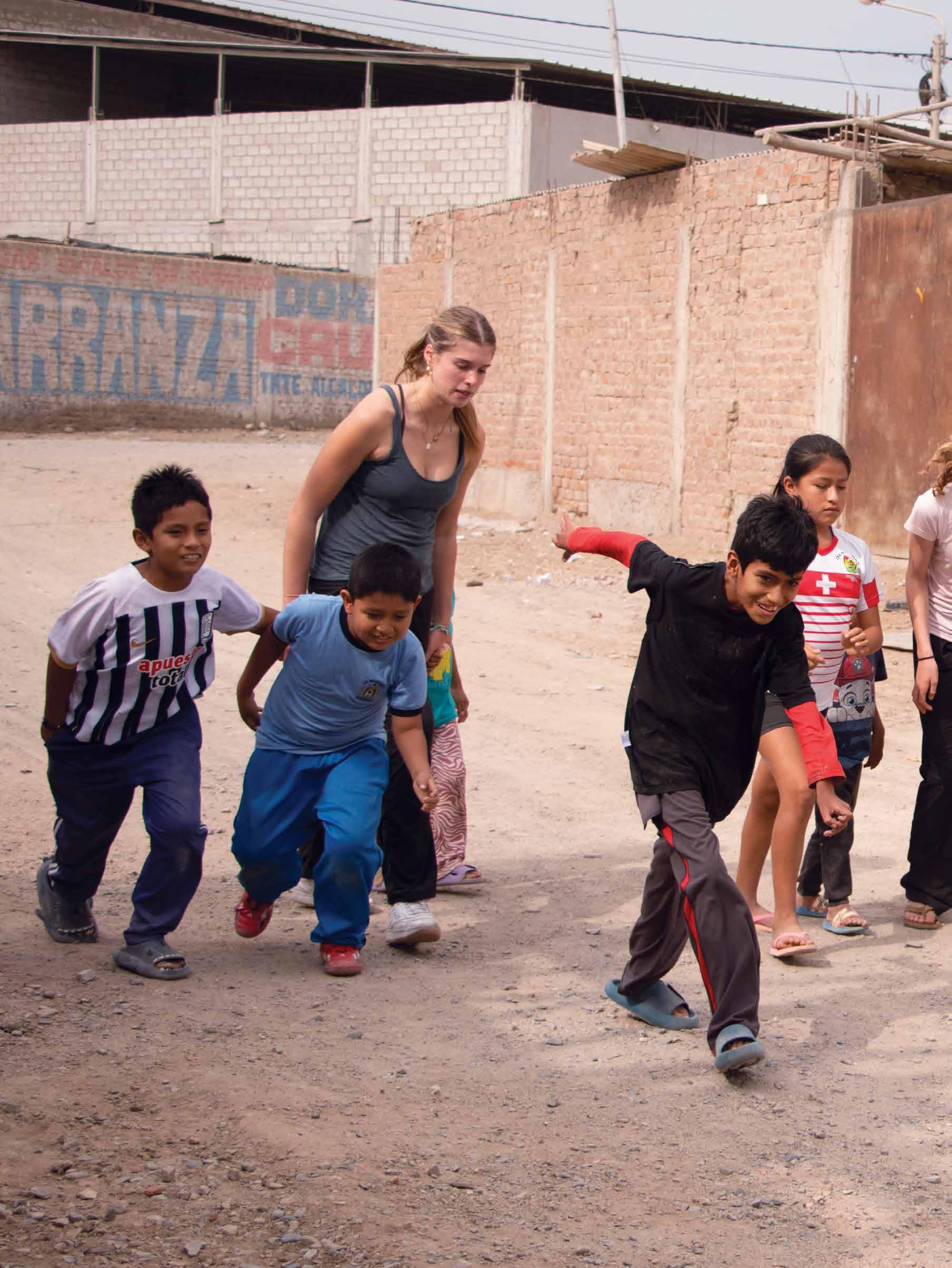
When students from different backgrounds engage— here in Huanchaco, Peru—the learning is a two-way street, and it’s a whole lot of fun!

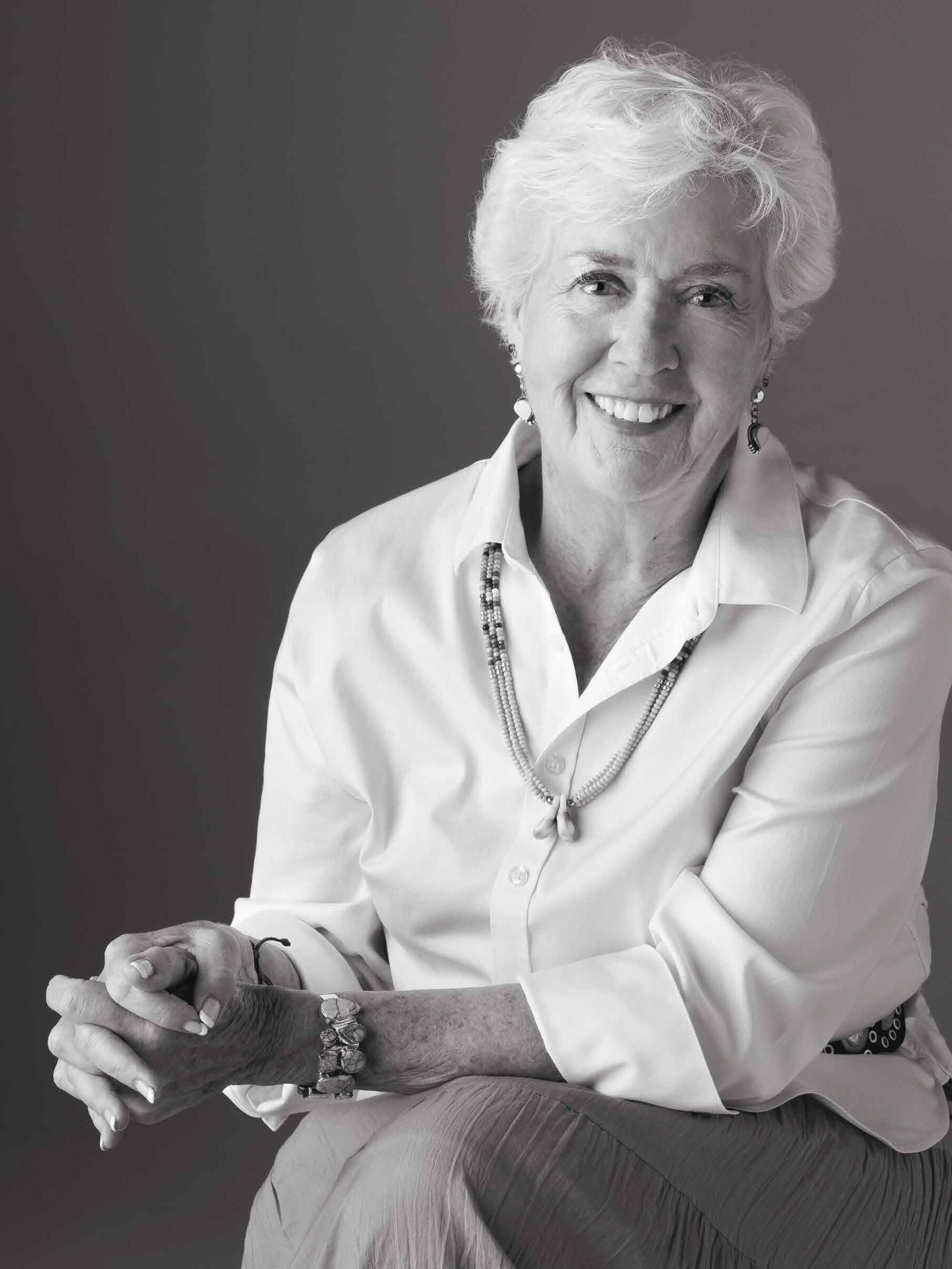
By Susan Ditz ‘68
Dressed in blue and white gingham uniforms and white saddle shoes on the first day at the Katharine Branson School (KBS) in the late 1950s or 1960s, each girl understood that her expected purpose was to succeed in her high school experience: get good grades, follow the rules, get along with the other girls, and have some fun in the process.
But coming of age in that era was far from comfortable or carefree for anyone. Joy Paganucci Bean ’68, who lived across the street from KBS, remembers this as a time of epic changes in societal attitudes and values, as well as nationwide turmoil. “President Kennedy was assassinated on my 13th birthday in 1963 and Bobby (Kennedy) [was killed] the night of our senior sleepover weekend, just a few weeks after Dr. Martin Luther King Jr.,” she recalls.
KBS students remember being deeply inspired by Dr. King’s passion, message, and movement, which called out systemic racism and began reshaping social norms. These teenage girls wore their feelings, literally, on buttons pinned to their navy sweaters and on the textbook covers they carried. His death and the resulting havoc were very troubling, especially since few adults on the KBS campus addressed these current events with students.
During these years, KBS provided a “sheltered” environment for the student body, especially the boarders. In fairness, there may have been parental pressure to keep KBS girls in a protective bubble, so they could maintain their focus on traditional academics and good grades. Especially in the 1950s and early 1960s, many youth were not expected or encouraged to have opinions on the world outside of academics or more “adult” concerns. In hindsight, however, many graduates believe they would have been much better served by more open dialogue about the powerful transformation the country was undergoing and what it might mean for their future.
“The political and social unrest felt really threatening,” Joy remembers. “What was happening was hideous and scary and we hardly discussed it at KBS [in the classroom], which was a terrible mistake because these were issues that mattered to all of us.” She feels like we are at a similar tipping point today.
During those years, the “counterculture” was also evolving with San Francisco at the epicenter. Joy, along with many fellow students,
was moved by the idealistic concepts of peace, love, and freedom, reflected in the growth of alternative styles of music and pop art. Her bedroom walls were filled with iconic, psychedelic concert posters from the Fillmore, Avalon, and Winterland. Garbed in bell bottoms, tie-dye and flowers, KBS girls found ways to leave behind their iconic gingham uniforms and join large gatherings of laid-back, peaceful crowds in Golden Gate Park to hear free concerts by the Grateful Dead, Janis Joplin, Big Brother and the Holding Company, and many others who used music to state their non-violent opposition to the war and “the Establishment.”
By 1965, the US was also fully engaged in Vietnam, which came into living rooms on the nightly television news and sparked widespread protests, especially on college campuses.
Around the same time, the feminist movement was beginning to challenge the traditional roles of women and sought both equality and reproductive and workplace rights. But this did not come not soon enough for author Sally Moser Small ’58 from Walnut Grove, California. After graduating from KBS and Stanford, she recalls, “I wanted to be a writer, but I didn’t think I could make a living at it. In those days, the only career options for women were to teach or be a secretary, so I went to secretarial school,“ she said. “And then I worked as secretary to the Director of the World Affairs Council, for I think, about $127 a month, after this high-priced KBS and Stanford education.” Years later, after her children were in school, Sally went to graduate school at USF. She finally fulfilled her dream and found work as a writer for newspapers and magazines such as The New Yorker, and publishing novels and short stories. Now 85, Sally says she still has more to write!
Class members from 1968 recollect one surprising (and in hindsight, amusing) example of the impact societal changes had during their time at KBS. For their final exam as seniors, English teacher John Hall, who had taught them how to critically analyze literary classics, asked them to fully explicate the Beatles song “Lucy in the Sky with Diamonds,” written by John Lennon from the 1967 album Sgt. Pepper’s Lonely Hearts Club Band. It was a rare meeting point between KBS academics and the current influences of pop culture in the world.
Unrest continued into another decade when colleges across the country were virtually
shut down by student strikes in May 1970 after Nixon announced the invasion of Cambodia, followed by the Kent State killings. By then, realizing she needed more of an intellectual challenge, Joy transferred from the University of Colorado to UC Berkeley, graduating with highest honors. While raising three children, she went on to build a career as an art curator, interior designer, advertising executive, and residential real estate specialist.
After graduating from KBS, Rachel Hooper ‘69 was part of the first class of women at Yale. In spring 1970, there was a planned demonstration that would bring thousands of students and activists from all over the country to Yale to protest the trial of Black Panther leader Bobby Seale. Yale cancelled classes and shut down many operations of the university. Rachel remembers that some parents insisted their kids leave college out of fear for what was happening on campuses. She was grateful not to be one of them.
Since its founding in 1920, KBS had maintained a reputation for “educating extraordinary women” who were expected to excel academically, attend prestigious colleges, and go on to make a difference in their communities. Even through the upheavals and societal pressures of the 1950s-1970s, the school continued to offer a solid academic footing to its graduates, preparing them well for future education. However, for some the experience felt more one-dimensional and limiting—especially when confronted by the realities of a world that still expected women to put family first and career second.
Most KBS alumnae agree with the Rev. Canon Sally Grover Bingham ‘59 that they received solid academic instruction and were well equipped to excel in college—in her case, even with a delay of several decades. “KBS gave me a really grounding education; I was very prepared when I finally went to USF at age 45,” she says. Sally got married a few years post-KBS and devoted her next few decades to homemaking. After raising a family, she felt drawn to get out of her comfort zone and take action. When asked to be a national trustee of the Environmental Defense Fund, she said, “Yes!” It was the beginning of a profound awakening that led her on a spiritual and intellectual journey, culminating with her becoming ordained as an Episcopal priest. Eventually, she was named by the Bishop of California as the first Canon for the Environment.
Her determined efforts have made climate change a moral issue for the faithful being addressed from pulpits across the U.S. She reflects, “When I was at KBS, I would never have dreamed that the idea of linking ecology with religion would have taken me where it has.”
•
Ruth Huyler Glass ‘66 was determined to do anything other than an educational career when she graduated from KBS. However, after attending Wells College, then also taking a break for family, and finally graduating from the University of Arizona, she finally realized the full value of her two years at KBS—and education was her path. “At KBS we were expected to work hard, take good notes, show up, and participate,” she says; these were concepts she saw many other college students had not been taught. “Most of our teachers at KBS were great and the classroom was a safe place to exchange ideas and where your opinion mattered. We also learned how to write well, how to prepare an oral presentation on something you were passionate about (for me it was people watching), and how to think for yourself.”
Looking back through the lens of a 46-year career as an independent school educator and administrator, Ruth also suggests that—as was the independent school focus at the time— KBS may not have served the more average student as well as it did high achievers. The pressure was especially hard on those who waged a daily battle to keep up, particularly if underlying issues were the result of learning style differences, like ADHD, that were not yet on the educational radar. “Research shows that SATs don’t measure life skills and are not indicative of how you will do in life,” she observes. “If you are going to accept someone to your school, you will know their strengths and weaknesses coming in and you must provide the assistance they need to succeed.”
Though her experience was at times difficult, painful, and occasionally confusing due to the administration’s perceived indifference to her personal challenges, Bonny Harbinger ‘68 praises KBS for serving her well during her careers in the Israeli military and as a clinical psychologist, lawyer, and now as Senior Advisor for Innovation at the National Institutes
of Health. Super smart, she arrived at KBS at just 13 from Solvang, California, having skipped a grade. “I was surprised by how hard it was, but I learned to write, which is a lost art,” she says. “Now, I have to rewrite everything for the people whose work I oversee. I learned the lost art of studying too, which was a huge plus.” And KBS taught her to be independent and resilient when she found herself on her own at 16 after the unexpected passing of her mother.
There’s no question that for some girls, the “one size fits all” academic approach at KBS was a struggle. Despite the school’s small size, there was still a significant divide between teacher and pupil in the classroom, and studentcentered learning still took a back seat to more traditional teaching methods of the time. Later on, beginning in the 1970s and 1980s as the school went co-ed, teaching methods did begin to evolve, both at KBS and in schools like it. Today, Branson is very different, offering a more collaborative, inclusive, student-centered learning environment that is one of the hallmarks of students’ experience.
•
The educational experience at KBS in those years went far beyond the classroom, deeply rooted in discovering the significance of building relationships, non-academic talents, and community. And this was also a crucial time for exploring beliefs by “finding your tribe,” as Joy calls it.
The good-natured rivalry between the Blue and Tam teams fostered healthy competition, helped develop new athletic skills, and encouraged the pleasure of letting off steam on the basketball court. Teamwork was also evident during endless glee club rehearsals of a complicated new piece of music by a famous local composer, or while prepping a play for performance.
A few years ago, Rev. Sally told a Branson student assembly, ”I was unaware of what I was learning when I was here, but over the years I have come to realize that the team sports; the friendship of other students; the influence of exceptional, dedicated teachers; and the overarching sense of love and community that KBS provided gave me the confidence to believe in myself.”
Ruth felt welcomed with kindness by her peers. “The KBS girls were pretty exceptional; we were loyal, we didn’t judge anybody, and none were ever mean,” she observes. Learning to live together, being supportive, respecting space and boundaries—especially for those coming from diverse backgrounds—were invaluable tools for college and beyond. “And our honor code, which we all took seriously, was an essential part of KBS: ‘Strive for excellence in conduct, character, and knowledge.’”
Sharing secrets, sorrows, service, and silliness bonded KBS girls together, day students and boarders alike—many for a lifetime. An alumna shared memories of pooling coins so a housemate could afford to call her dad serving in Vietnam on his birthday; providing all the comfort needed for a roommate whose parent died tragically; putting on goofy costumed skits to break the gloom of endless rainy weekends; commiserating over boyfriend breakups; finding the stapler for emergency skirt hemming so a desk-mate could pass uniform inspection.
Then there were little rituals that also fostered community connection, often handed down year-to-year, sometimes devious, and “frequently ridiculous, great ideas often with a little dash of collective intrigue,” one student from the ‘60s recollects. A TGIF cheer on Fridays; prank planning; late night flashlight “John Parties” sharing stashes of candy and confections; creating elaborate graffiti in New House for the next generation to find; and “the sweetly sentimental, in-joke-filled, slightly naughty, irreverent annual ‘wills’ passed to juniors from every senior (always including considerable mention of boys), mimeographed clandestinely with elaborate illustrations.”
Numerous alumnae report that friendships forged by all these little moments in high school continue to flourish today, decades later. They have often used technology to stay in touch and even gratefully find each other again on social media after the passage of many years.
Before cultural diversity and exchange programs were a concept, KBS drew young women from many different backgrounds in big cities and small towns: from Marin and
Sharing secrets, sorrows, service, and silliness bonded KBS girls together, day students and boarders alike—many for a lifetime.
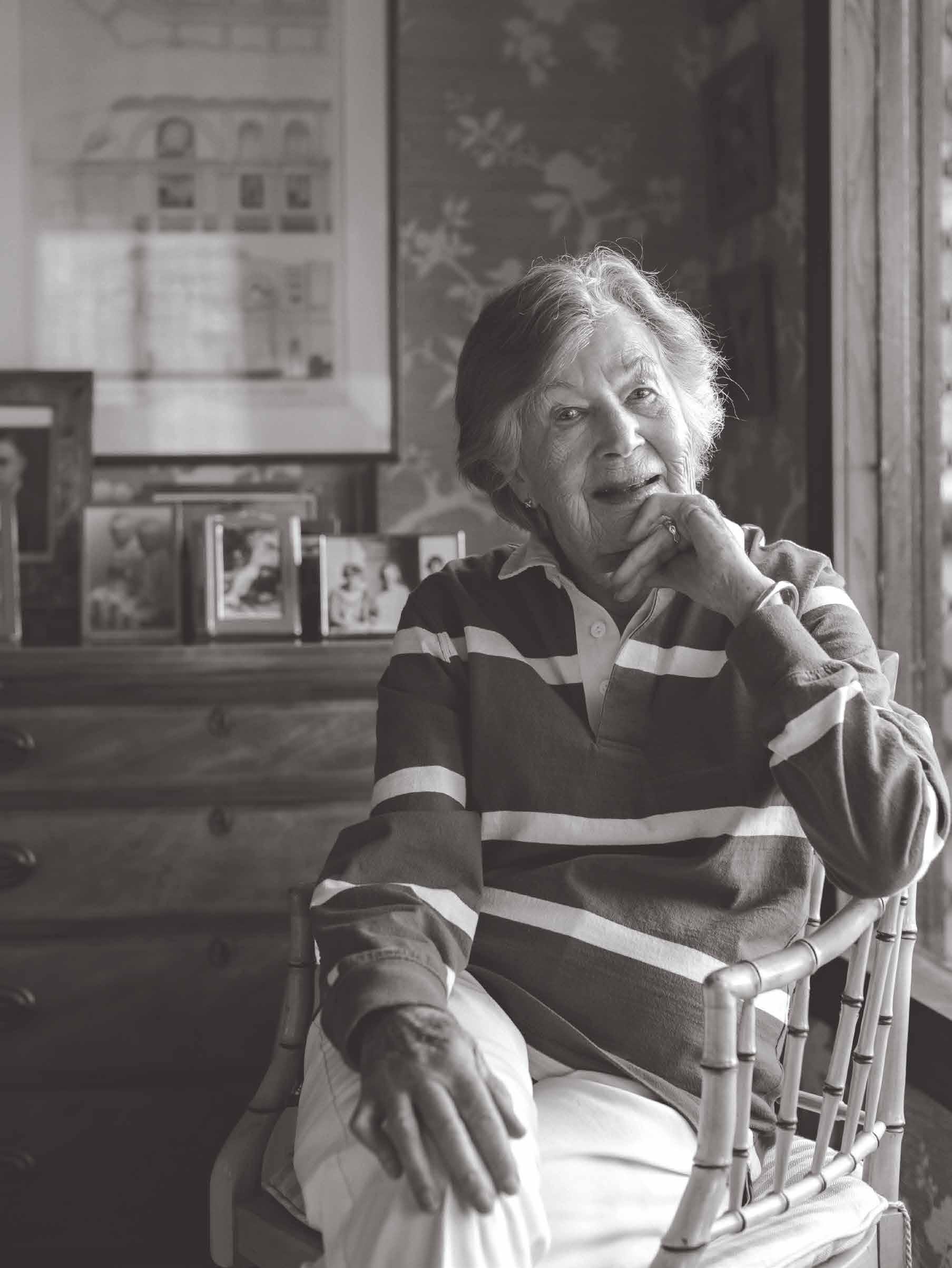
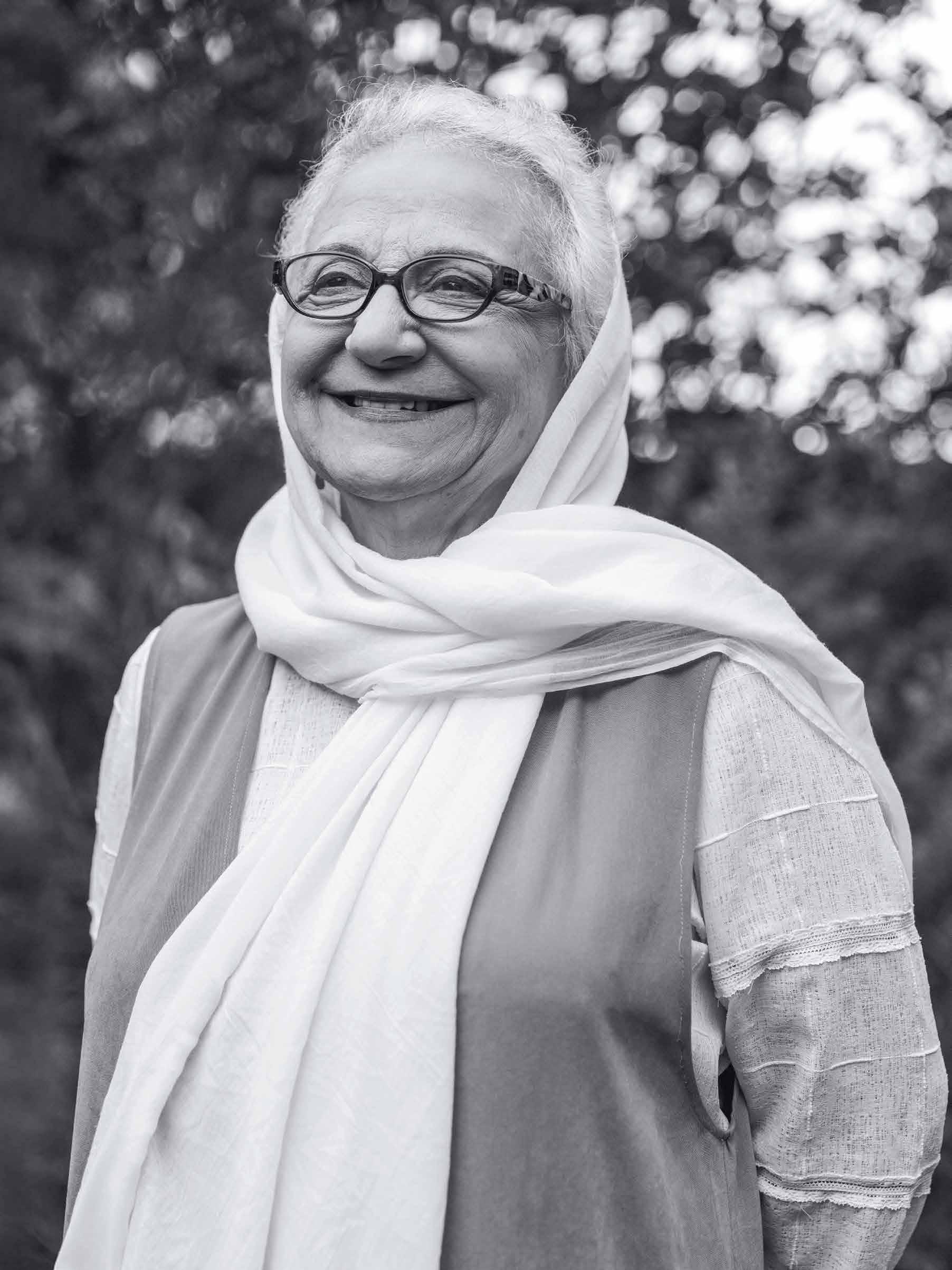
KBS taught us to “do what you believe in and make a difference in the world.” The message we heard was, “we were privileged to have this great education, and we needed to lend a hand to others.”
all over California, as well from other western states such as Montana, Idaho, Hawaii, Oregon, Washington, Colorado, and Texas. Girls traveled internationally to live and study at KBS too— from Hong Kong to Saudi Arabia, from Guam to Norway, and various countries in South America. Together, the girls were expected to find common ground and assimilate as “KBS girls” despite any cultural differences they might have had.
A reputation for excellence is what convinced the parents of Soheila Shahshahani ‘66 to send their only daughter over 7,000 miles away from her home in Iran to KBS. “My brothers were already at UC Berkeley, and they searched and found the boarding school which was classified as the best in the area,” she said in an email. Coming in as a junior, with English as her second language, was brave and hard. She remembers that no extra effort was made to help her integrate into the community beyond matching her with a roommate whose dad was a physicist. There was another student that year from Norway who Soheila reports had an easier transition.
In hindsight, their classmate Ruth shared, the students could have made more of an effort to make the girls from other countries feel more comfortable if they’d understood the challenges. “It was OK, as I needed to adapt to the new way of life, living not with my family, speaking another language,” reflects Soheila. “At KBS, I learned good English, and being purposeful and achievement-oriented has been with me since. But I think I was so serious then, that even if efforts were made to become friendly and have some fun, I would not have understood that!” After Berkeley she earned a PhD in Anthropology and returned to Iran where she is currently Associate Professor of Anthropology at Shahid Beheshti University, and Editor in Chief of Anthropology of the Middle East.
to KBS seniors. Being with boarders as a 22-year-old gave her a new perspective about how different her life had been at KBS from the resident students. Rachel realized the freedom to change into sweats rather than stay in a required uniform, stay up late to finish an assignment rather than try to get it all done in a two-hour study hall, and go out with friends at will on the weekends, as opposed to being restricted to a few hours of free time. It was an eye-opener.
Today she is a highly successful public interest litigator specializing in environmental law, thrives on winning big “David vs. Goliath” cases, and feels like KBS taught her to “do what you believe in and make a difference in the world.” The message she heard was, “we were privileged to have this great education, and we needed to lend a hand to others.” Volunteering and her parents’ modeling gave Rachel the determination to turn her back on a more lucrative corporate law career and follow her heart to the more fulfilling work she’s done since graduating from UC Berkeley’s School of Law.
When Rachel returned to KBS as a teacher in 1973, much had changed, including the first male students coming on campus. It was the beginning of a welcome new chapter for Rachel, ultimately inspiring her desire to become a lawyer. It was also the start of a big transformation for KBS.
During the next ten years, the Katharine Branson School would continue to progress with changing times in education and societal values. Partnering with the Mount Tamalpais School, while slowly bringing the boarding program to an end, the school became a more inclusive, co-educational setting where students would continue to thrive and achieve excellence in many areas including academics. As the school became more responsive to a rapidly evolving world, the sense of values and purpose for which it has always been known has continued. Graduates continue to leave their mark in their communities and on the global stage. And the legacy of its well-educated, purposedriven, female graduates still continues to make a lasting impact today.
Rachel wasn’t as clear about her future as Soheila or many of her 1969 classmates were. When she returned home to Ross after leaving Yale, she was at a loss for what to do next. Rachel went to campus often and eventually was offered a position as a resident assistant and the opportunity to teach an English class
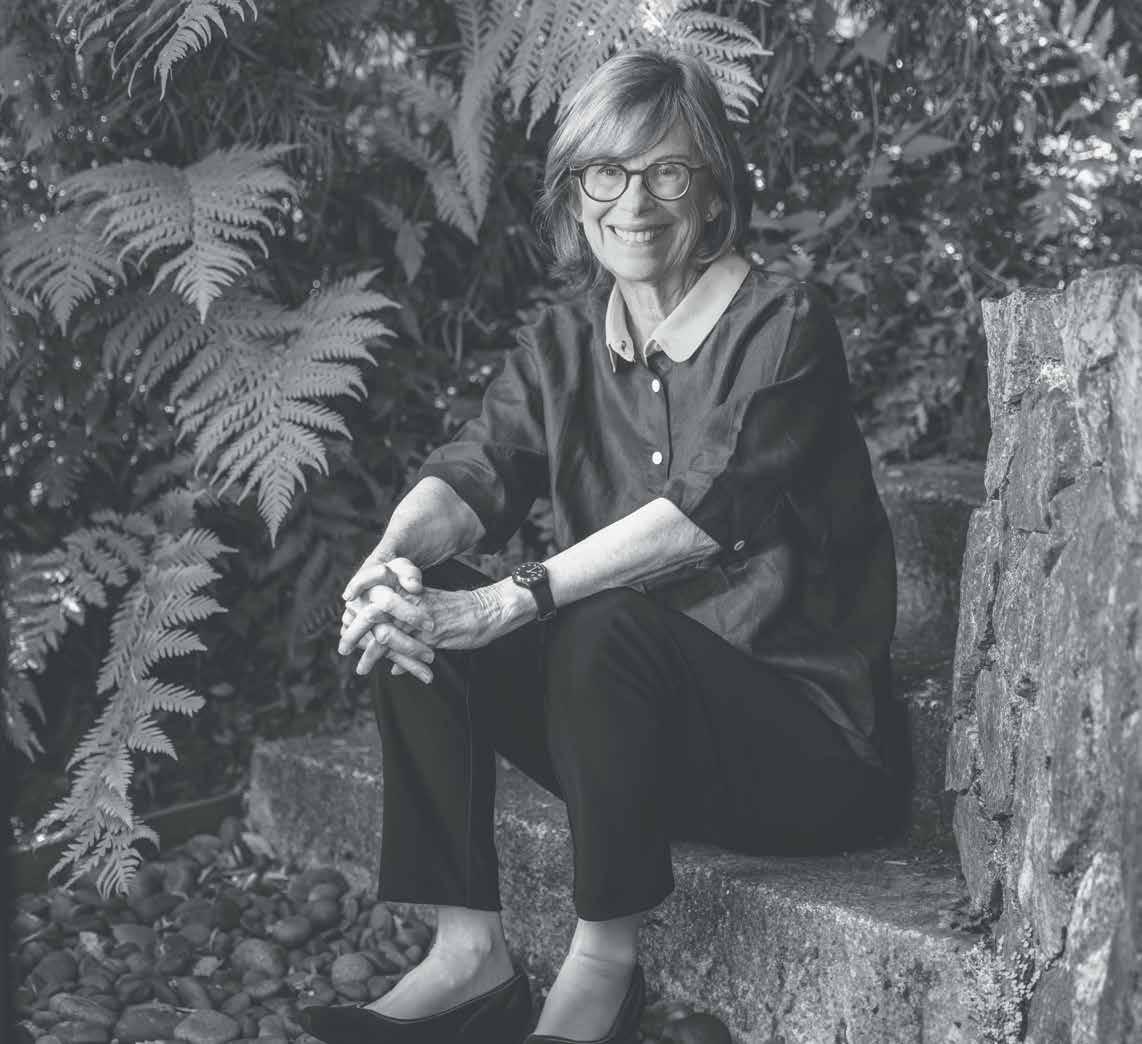
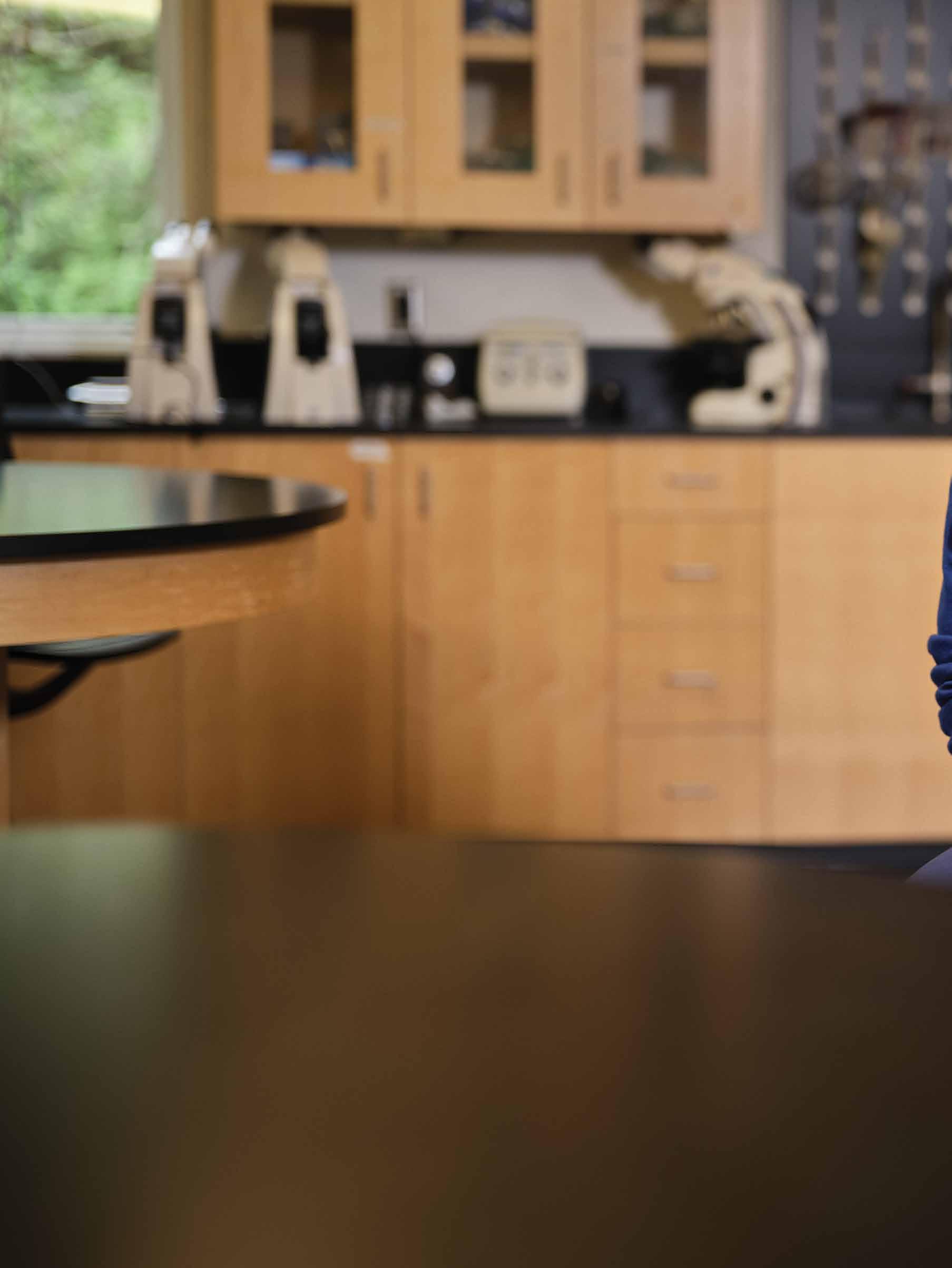
By Guy Raz P 27, 29
Guy Raz sat down with Percival BarrettoKo, Branson biology and entrepreneurship teacher, to hear about his life journey, his passion for teaching and learning, and his search for home.
Q: Tell me about your childhood?
A: I was born and raised in the Philippines, in a family that certainly was not well-to-do. I was raised by a single mother who had four children; I’m the youngest and the only boy.
Q: And your mother was an immigrant herself, right?
A: Yes, she fled South Korea in the middle of the Korean War. She raised us on her own, and I was lucky enough to get a scholarship at a Filipino Catholic school. I was essentially raised by the Jesuits. The thought of even going to the U.S. was a million miles away because it was so alien. No one in my family ever thought of leaving the country.
Q: You were born and raised overseas and came to the U.S. as a teenager but you don’t have a single trace of an accent. Were you speaking English at a young age?
A: I was obsessed with watching The Muppet Show and Sesame Street. Those shows really shaped me—seeing different characters, colors, and personalities interact was both alien and familiar in many ways. That’s where I really started to get to know English. Of course, we studied English in school, but it was a Filipino school. From the get-go, I knew that if I wanted to really fit in at college, I needed to speak a certain way. And that’s where it started.
Q: The Philippines has a strong Catholic culture and you went to a Jesuit school. Did that have an influence on your faith growing up?
A: From the time I was young, I thought I had the calling to be a priest. After high school, I spent two weeks in a seminary at Jesuit
Novitiate where they train priests. After those two weeks, I knew that I did not have the calling. But religion shaped me in many ways; it was a central theme in my life. My mother and sisters were devout Catholics. Growing up in that environment, you really can’t escape it.
Q: So, instead, you ended up coming to the United States to study at Cornell. How did that happen?
A: It was quite a fluke. I went to a party and was chatting with the birthday celebrant, Xandra. It was a Friday night, and I asked her what she was doing on Saturday. And she said, “I’m taking the SATs.” And I said, “What are the SATs?” She explained that they were for entrance to colleges in the U.S., and I thought they sounded interesting. She told me it was just $25 and you could walk in and take the test. I had not thought about the U.S. at that point. The only person that I knew who had actually gone to a school in the U.S. was my dentist. So the next day, I took the SATs. It was a baffling test to me, but I was lucky enough to do well, and I started to get the brochures from colleges. At the time, very few students from the Philippines applied to American colleges. I was intrigued because I had heard so much about New York, so I chose Cornell. What I didn’t realize is that New York City and upstate New York are completely different from each other.
Q: For sure! Was this your first time leaving the Philippines?
A: 100%—other than a week-long trip to Hong Kong for a science competition. It was both exciting and depressing at the same time. As a 17-year-old it was very scary flying alone to JFK, landing in JFK, taking the bus to Port Authority on 42nd Street, figuring it out.
Q: I can’t even begin to imagine how you started to adjust to the culture. Notwithstanding, you’re coming from a tropical climate to one of the coldest possible places in the United States in the winter.
A: I had no clue. It was tough—as much as I’d wanted to go, I was missing family, I was missing friends. And I was always asking myself, “Did I do the right thing to leave the Philippines and go to an alien place like Ithaca, New York?”
To be fair, Ithaca is absolutely gorgeous, especially during the fall. Stunning. And I still remember it started to snow on October 31—it was the first time I’d ever seen snow and my friends from California and I were outside just celebrating and enjoying it. And after seven days, I was sick of it.
As much as I loved Cornell, I have not been back since I graduated. But it was a glorious time for me, and I really enjoyed it.
Q: When did it become clear to you that you were going to build your life in the United States?
A: I don’t think I ever really decided that I was going to stay in the U.S. because I wanted to. It was more that I couldn’t possibly go back to the Philippines because that choice would be seen as a failure. So it was less a matter of wanting to stay here and more that I didn’t want to go back. My life then became a series of acquiring visas to permit me to remain in the U.S.
Q: You studied pre-med as an undergraduate and then began your career as a teacher at a private high school outside of Boston. How did that come about?
A: My three older sisters went to medical school and are physicians. The pressure for the only son of a highly driven Korean mother to follow in my sisters’ path was pretty intense. I was admitted to medical school but thought that I needed to decompress and take a gap year. During Cornell’s homecoming, I remember touring around an alum who was the headmaster of St. Mark’s School, a boarding school in Massachusetts. He asked about my gap year plans and I said I didn’t know. He asked if I had thought about teaching. I was planning to visit friends in Boston, and so I said I would stop by the school. At the time, I was so enamored by the movie Dead Poets Society, and the whole idea of being in a boarding school fascinated me, as it was so different from my own upbringing.
I got a work visa for one year. It turned out I loved teaching. So I taught chemistry and biology, coached soccer, and was the housemaster for the senior boys. I decided I’d like to stay for another year. Two years became five. I fell in love with teaching, much to the disappointment of my mother.
Q: So then, what prompted you to leave this profession that you loved so much? Was it a feeling that maybe your purpose was changing?
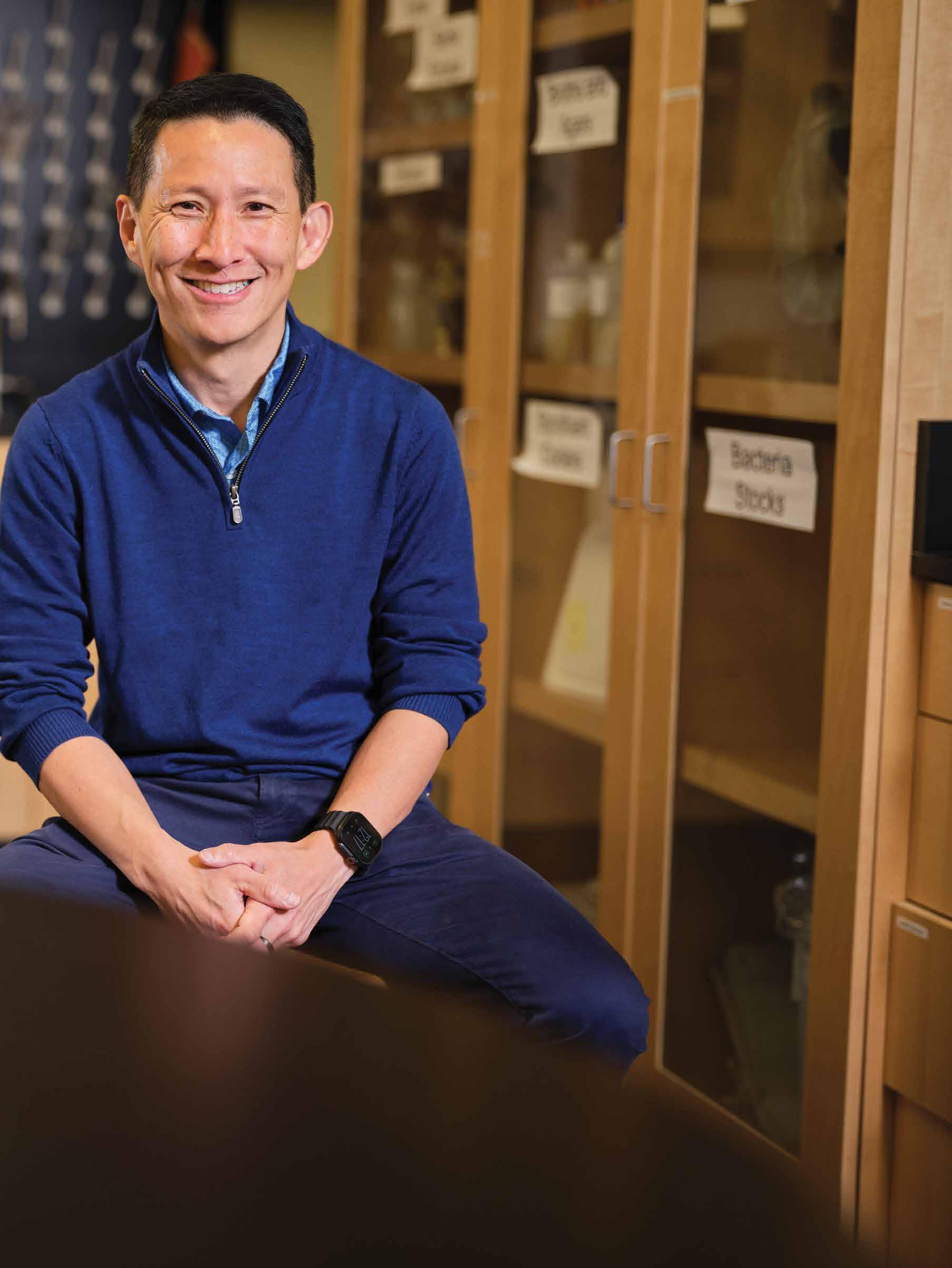
A: I had many friends who had gone on different paths after college, and many of them were investment bankers or consultants, and their work intrigued me. I began to wonder if I really wanted to be teaching, so I made quite a drastic move and decided to go to business school and chose Yale.
Q: What was business school like for you?
A: I had the most non-traditional background of anyone in my class. Everyone was either a
McKinsey consultant or had worked at Goldman Sachs or Procter & Gamble. Yet here I was, a teacher with no clue about basic finance. But it was new and different. And I thought at that point that maybe my purpose was to pursue something that my friends were also enjoying.
Q: After business school, you ended up in the biopharmaceutical industry, which makes sense with your business degree and also your background in the sciences. Your first job was with Roche, the multinational pharmaceutical giant.
A: That was serendipitous as well. It was 2001 and the year of the dot-com bust. Like many of my classmates, my job offer as a management consultant for McKinsey was rescinded. The only company that was still recruiting on campus was Roche. My prevailing thought was that I couldn’t possibly go back to the Philippines. Was I passionate about pharmaceuticals? Not necessarily. But I thought I needed to find a way to stay in the country and so I applied. In a way, it was a case of destiny meeting me and really telling me that I was in the right place. I would not have been a good fit for consulting. I’m grateful for that rescinded offer and the fact that I ended up actually at Roche because I loved that experience.
Q: You ended up in a very senior leadership position at Roche, then later at Astellas Pharma, another global pharmaceutical company. Did you think of yourself as a leader?
A: Early on, I enjoyed bringing together teams and finding a way for them to come together toward a common vision. This is not very different from teaching. Teaching is being able to figure out what the plan and vision is, but not being so inflexible that you always have to stick to a rigid lesson plan. Particularly when you’re teaching teenagers who have their own opinions—we’re not teaching robots!—you have the opportunity to communicate something as clearly as possible and to move them from one point to another. I kept on going back to that and tapping into that skill from my teaching days. Whether or not you call it leadership, it has helped me so much throughout my career, even up to this day.
Q: Your five years in the classroom quite possibly prepared you better to become an executive than the experiences of your business school classmates.

A: Indeed. If I had not been a teacher, I don’t know if I would have ended up where I did. It’s being able to cut up something that is seemingly complex—whether you’re talking about a mode of action of a molecule or a business plan, or you’re communicating a big vision to the company. Being able to communicate something is one thing, but being able to really draw people closer to your vision is a skill that teachers have. And it is a skill that you can really hone.
Q: As an executive, you also have to keep things interesting, right? Students are probably one of the toughest audiences because if they’re bored, it’s pretty easy to see. And so I imagine that having the skill to keep students engaged applies to keeping the C-suite engaged or your investors engaged or your customers engaged?
A: What was interesting for me was learning how to be authentic to my teams and my customers. If you are talking about vision for the company and you aren’t being real, they know. It’s the same thing with teenagers. Teenagers can easily see non-authenticity from a mile away. It’s the same thing when you’re teaching biology or chemistry and they feel like you’re a phony or you don’t know what you’re talking about. Or if they ask a question and you sort of fluff it, but you don’t really know. It’s better just to say, “I don’t know, let me find that out. That’s a great question.“
Q: So you were climbing up the corporate ladder, taking on more and more responsibilities until you eventually became president of a very significant pharmaceutical company. In the back of your mind, did you think that this might not be how your career was going to end? That someday you might be going to go back to the classroom?
A: Yes. All throughout my career, as I moved from one visa to another, as much as I became a relatively senior person in the company, my fear was always being deported back to the Philippines.
Q: Was there anything remotely real about that scenario or was it more just your own kind of anxiety?
A: I think it was my anxiety. And it was the thought of being able to finally have a home in a way. Because when you’re on a visa, you feel like you’re not settled. And finding that home is so important. At the back of my mind, I missed being able to stand in front of and teach a class. After all this and having stayed in the U.S. on all sorts of visas, I finally became a U.S. citizen in 2021. And that’s when the ball started to roll. Now that I was a citizen and had a place to call home, what was I going to do about it?
Q: So after a very successful 25 years in biopharmaceuticals, you decided to come full circle back to the classroom.
A: Yeah, so after Astellas, I actually decided to first lead a biotech company called Plexium in San Diego as their CEO. That was very exciting in many ways because they were really leading cutting edge cancer therapies as well. But in 2021—I remember it was in the middle of the pandemic—I remember going home and thinking, “Oof. Ever since I was 18, 17, I haven’t really found a home, mentally. I haven’t felt settled just because I’ve been literally considered as an alien in every single place that I’ve been in for the last four years. What next?”
I enjoyed my time at Plexium. I really did. It was a great company, great science. But it was that prevailing thought that lingered: When am I going to go? Will I ever go back to teaching? And so I had different choices. One was to wait it out for another 10 years— maybe when I’m 60, 65, etc.
Q: Sure, that makes sense. So what changed your mind?
A: Around that time, I turned 50. As much as my mother raised us and she was a single mom, my dad actually was relatively present as well. But he passed away when he was 64, very young. All of the men in my family happened to pass away before they were 65.
“Life’s too short,” I concluded. “What are you doing? You found a home, you’re now in the U.S. There are no excuses anymore.” The combination of the pandemic, of now being a citizen, and of finally now realizing it was time to really pursue my original calling... that’s when I started to really think about teaching. From there, it took me a full 18 months to really sit down and plan it out.
Q: How did you end up at Branson?
A: It was almost too good to be true. I absolutely love Marin County and had always wanted to settle here. Funny, it took me 50 years to finally get here. And to find an independent school that had the same values that I had, and that was progressive in many ways, was just, again, too good to be true. I couldn’t pass it up. And so I visited Branson. I fell in love with the place. That walk down the stairs from the library down to the Commons is really quite breathtaking in many ways—a romantic place, but at the same time where real education happens.
Q: Branson needed a biology teacher and you were excited to do it. How much brushing up did you have to do before you got back into the classroom?
A: Oh God, it was embarrassing. I had to do a sample class for Honors Biology. My assigned topic was the origin of life on Earth, which I had not studied since high school. You could ask me to talk about cancer therapies or even DNA replication and I would be fine, but to ask me to talk about how life originated on Earth nearly panicked me.
Q: You’ve also introduced an Entrepreneurship course, a class that I know well because you’ve invited me to come speak. Tell me about the genesis of that idea.
A: It was [Head of School] Chris Mazzola’s brainchild from the get-go. In our very first meeting she said, “What about entrepreneurship?” It hadn’t crossed my mind. In my first semester of my first year, I had six brave students who signed up for a new class with a teacher they never heard of. To this day, even as Entrepreneurship has grown in popularity, that first class is still very memorable to me because those six students joined me for a class that, quite frankly, I was developing in real time.
Q: How do you get students to become entrepreneurial thinkers, even if they might not go on to start a business? There’s so much evidence around this idea of problem solving, which is connected to entrepreneurial thinking. I imagine that’s really the critical value proposition of this class. It’s not the specific idea that a student comes up with, but rather the way that these conversations help to shape a method of thinking.
A: The class very deliberately tries to address this and set the students up for success. I try to focus on three things. One, is the concept that entrepreneurship is not what you do; it’s a mindset and a way of thinking. You can be a startup founder, or investment banker, or a teacher, and still have a deeply entrepreneurial mindset. It’s how you look at circumstances and say, “How can I make that better?” Two, is the stereotype about entrepreneurs being outgoing and boisterous and very creative in many ways. We discuss that entrepreneurs come in all shapes and sizes. And I mentioned that every time I take Myers-Briggs, and the “I” (introvert) versus “E” (extrovert) component, I come out as literally the most extreme “I” you will ever find. It’s that sense of deep curiosity of figuring out how to make something better. Three, is modeling who are the folks that you’ve seen who are successful, who have this mindset and realize that anyone can be an entrepreneur.
Q: I heard that 32 students asked you to write college recommendations this year, which sounds exhausting, but also indicates how much impact you’ve had at Branson in such a short time.
A: It’s such a privilege in many ways. As much as it sounds like a lot, I was delighted. Over the moon. Because it’s such a privilege, but also such a responsibility to write a recommendation letter for someone at such a pivotal time in their life.
Q: Now you’ve been at the school for a few years, what have you noticed about what Branson students are like?
A: Branson students are so multifaceted. On one hand, you have a student who’s absolutely academically brilliant. Great,
dependable, and wicked smart. And then you have some who may not be quite as academically focused as those students, but they shine in other ways as a leader or in some incredible talent that they have. It’s the benefit of a small, tight-knit community where you really get to know every student deeply. That’s such a gift. The real commonality I see is that despite their differences and diversity, all possess a deep sense of curiosity. It might not be a sense of curiosity about biology but a sense of curiosity about something. There’s a passion, whether it’s math or sports or analytics or writing or music. It’s very rare that I would find a Branson student who’s just not passionate about anything and I’m really grateful for that.
Q: Anything surprise you?
A: One thing that really strikes me is that when I end a class, I hear almost every single student say thank you. It really melts my heart. There is a sense of gratitude, that they know that Branson is such a gift to them.
Q: Who is a living person that you really admire?
A: Malala Yousafzai
Q: What is your dream dinner party table, living or dead?
A: I’d love to have President Carter. Obviously Nelson Mandela. And I’d want to make this a small table. I would say Joan of Arc as well. That would be a bizarre table. “Oh, hello. How are you doing today?” But yeah, that would be fascinating.
Q: How would you describe your purpose today?
A: My purpose is to spark curiosity. How do I—whether teaching biology or leading a club or teaching an immersive or advising a student—how do I spark curiosity in them? It goes back to the whole entrepreneurial spirit, right? How do I encourage them to find the right mindset so that 30 years later, they still have a sense of curiosity and wonder?
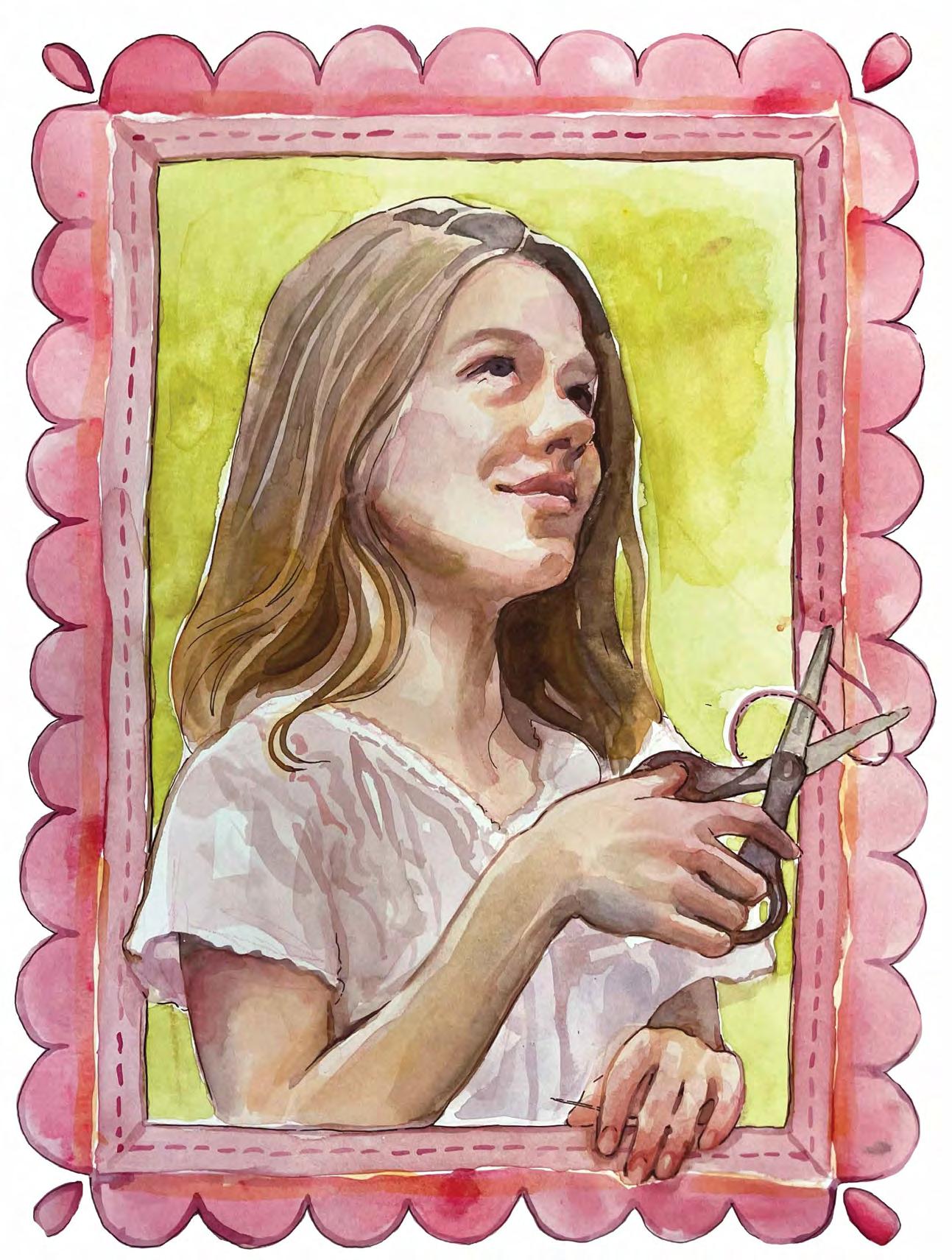
by Tessa Fontaine ‘01
Carter West ‘24 is bent over her canvas. She renders a manuscript page, Sappho’s Fragment 94, in paint, only to obscure it with layers of fabric, lace, and woven textiles, which she begins braiding. Once all the pieces are ordered and woven, she undoes them. Then she braids them again. The big off-white braid across the painting looks like the long-ago washed-up spine of a massive creature. Other fabric drapes off the canvas, where gravity does its own destructive work. Back and forth she goes, creating, destroying. Knowing that in each new version of a piece, nothing is lost. Every memory of what came before is stored inside.
For Carter, destruction is a necessary part of the process. Growing up, she struggled with perfectionism and anxiety, and it has only been through art-making, during which she intentionally ruins a piece and starts over, that Carter is able to face those challenges head-on. She’s known that her life’s purpose was to make art, long before she could articulate it.
At Branson, Carter’s art education culminated in her senior Portfolio class, during which she explored more traditional artistic practices like acrylic painting alongside sewing and stitching, crafts traditionally gendered feminine and thus devalued in the arts world. It is this kind of imagistic opposition that drives much of her work, like a current

project she’s working on in her freshman year at the Rhode Island School of Design (RISD), which contrasts snakes and lace.
When she starts a new project, Carter has only a whisper of an idea; she doesn’t know what it will look like, why she’s interested in it, or what meaning she’ll make from it. It’s not until a piece is finished that the meaning becomes clear. The process illuminates the purpose.
This February, Carter declared Apparel Design as her major, hoping to use the expertise of the instructors at RISD to learn the technical skill set. So far, she’s been engaged in what she calls “feral craftsmanship,” making it up as she goes.
“Art is a super important practice to me. It’s meditative, it helps me engage or disengage my brain when I need it, and it gives me something to do with my hands,” she says.
“[It’s] a release of energy.” Art, Carter says, is how she understands herself.
But for Carter, art’s purpose goes beyond just the joy she takes from creating beautiful pieces. She explains, “with the rise of AI and the devaluation of art that we see right now, it’s particularly important to have an artistic education.” There’s more to her artmaking than just her inner drive. She is using her creative energy to take on the world.
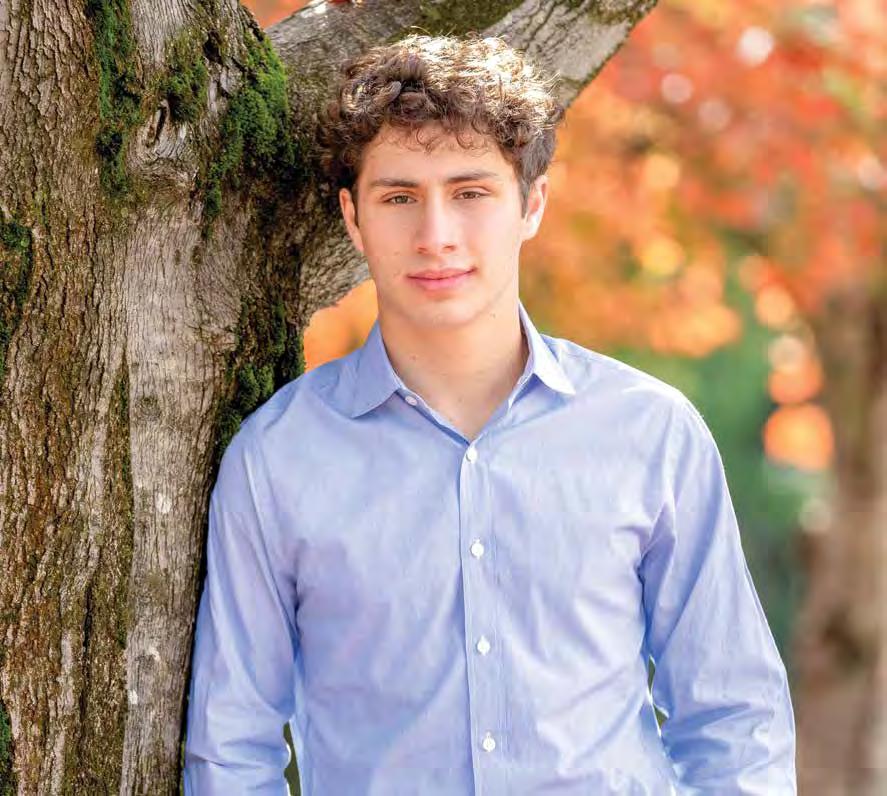
Henry Lien doesn’t remember when he started playing chess—just that he couldn’t stop. By elementary school, he was already obsessed, by 2018 he’d won a state division championship, and in 2020 he started training with Cuban grandmaster Yuniesky Quesada Pérez. For his 7th grade bar mitzvah project, Henry launched a chess program at Venetia Valley, a Title One school near his synagogue. “I wanted to create a project with lasting impact. I was a seventh grader teaching fifth graders—it was definitely a unique situation,” he recalls. That spark became ChessPals, a nonprofit bringing chess to underserved communities. Working through Bay Area Community Resources, Henry expanded the program to all five San Rafael elementary schools, reaching mostly first-generation and Latinx students: “It’s definitely a bilingual experience—I’ve taught dozens of classes purely in Spanish, and others I’ve taught in English and then translated 1:1 afterward for the firstgeneration kids who only understood Spanish.” As a freshman at Branson he realized: “We’re having young high schoolers teach chess to school kids. Why don’t we flip the script and have them teach senior citizens?” This began a new partnership with Vivalon: “One of our teachers was 12 or 13 and was teaching people seven times his age. It was hilarious.” Today, ChessPals operates in California with chapters across the U.S. Alongside Branson alum Stanley Wong ’23, Henry also co-founded the for-profit Checkmate Academy. Between the two, he asserts, “We haven’t done the math, but we think we’re one of the biggest chess providers in California now.” Now a rising sophomore computer science major at Stanford, Henry oversees both chess programs while concurrently serving as investor for a $38 million venture fund. “To be doing all the things I’m doing right now—it’s outrageous,” he laughs. “I just want to do great things, meet cool people, have a crazy multitude of experiences, and make the most interesting stories.”

The night Skylar Lariviere built and slept in an igloo on a snowy mountainside, something clicked. She had recently joined Scouting America—just as the organization opened to girls—and had no idea how life-changing it would be. For her, this camping trip sparked a deep love for the outdoors, teamwork, and service. As one of the first ten female Eagle Scouts in Marin, Skylar wears her sash of merit badges with tremendous pride. Each one tells a story; her proudest patch represents her Eagle Scout service project. “The Eagle Scout is the highest attainable rank in Scouting America, and I believe it serves as a culmination of all my hard work leading up to it,” she explains. “It brings together the lessons, the service, the adventure, and the people I have met along my journey to this award.” For her community service project, she chose to follow her passion for animals, working at Marin Humane to revitalize their garden and build new beds for cats housed in the shelter. “Scouting has grounded me in the notion of service and has taught me what it means to care for and serve others before ourselves, even when it’s hard or inconvenient,” she says. “It changed the way I see the world.” That mindset now extends to Branson, where she’s regularly volunteered as a technology tutor to local senior citizens. From helping one woman design a book cover for publication to using her Mandarin skills to facilitate communication between mother and daughter across the miles, Skylar has learned that empathy and patience can bridge just about anything. “You don’t always know what people are carrying,” she says, “but you can always show up.” Quiet and observant with a sharp sense of humor, Skylar is grounded by her purpose: helping others. “I want to leave things better than I found them.”
Purpose manifests in many ways at Branson, as our students and alumni live our core values every day. Here are a few of their stories:
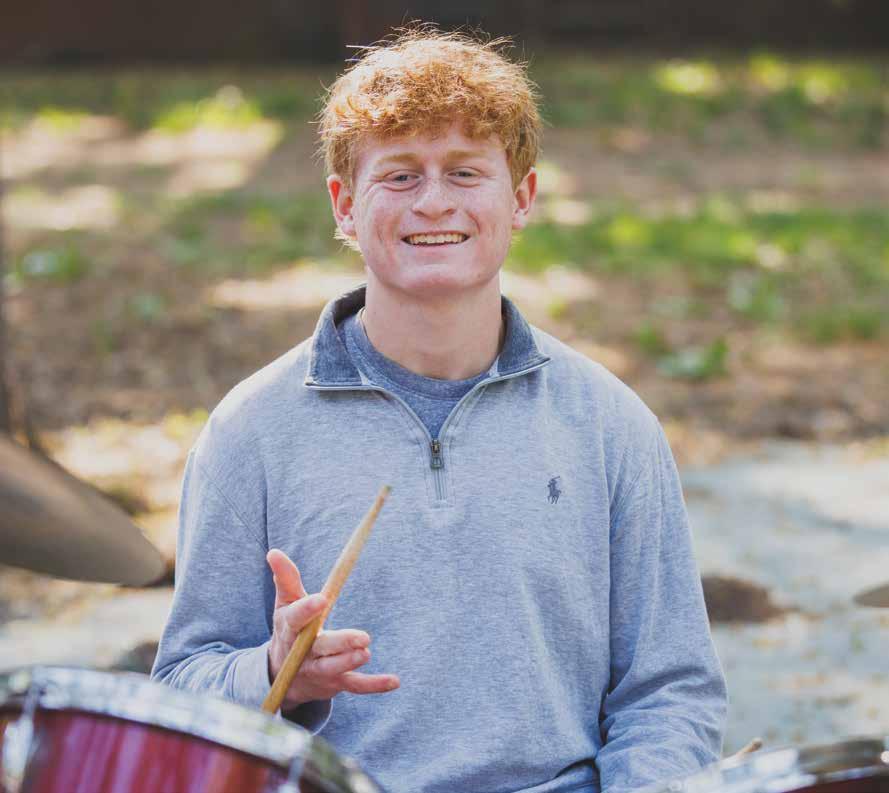
Charismatic, energetic, full of life…these words come to mind when first meeting Cyrus Allen. An avid drummer, an accomplished multi-sport athlete, and a dedicated student, he dives into everything he does with panache and purpose. So, it’s hard to imagine that just eight years ago, his world was dramatically different. Felled by mysterious symptoms after a skiing accident, 10-year-old Cyrus found himself increasingly incapacitated—in pain, unable to eat or read or write, crippled by anxious thoughts, and “trapped in my own frightening world.” Doctors were baffled, and the prognosis looked bleak. Ultimately, a freak coincidence saved his life. Flipping through Outside Magazine, his doctor stumbled on an article which ultimately led to a diagnosis: Pediatric Autoimmune Neuropsychiatric Syndrome (PANS). It was the first encouraging step on his long road to remission and recovery. As his own condition improved, Cyrus turned his misfortune to advocacy. It started simply—as a 7th grader, he FaceTimed with other kids earlier in their treatment journey simply to connect and share experiences. And it’s grown from there; “On top of speaking with patients as a mentor and friend to help them through their recovery, I also speak to parents as living, breathing proof that their children can get better.” He’s also lobbied on Capitol Hill for improved awareness and federal research funding for PANS and other autoimmune conditions. For his Junior Fellowship, Cyrus created a TedxYouth Talk, “A Call for Autoimmune Awareness,” and he’s excited about the recent creation of a new youth-led advocacy group, the National PANDAS/PANS Youth Alliance. “This experience has given me the gift of perspective,” Cyrus reflects. “And yes, it came at a very high cost to myself. But taking these lessons I’ve learned has given me a purpose and allowed me to change lives. Regardless of what could have been, I’ve been blessed in new ways, and I want to bring my best to these new opportunities.”
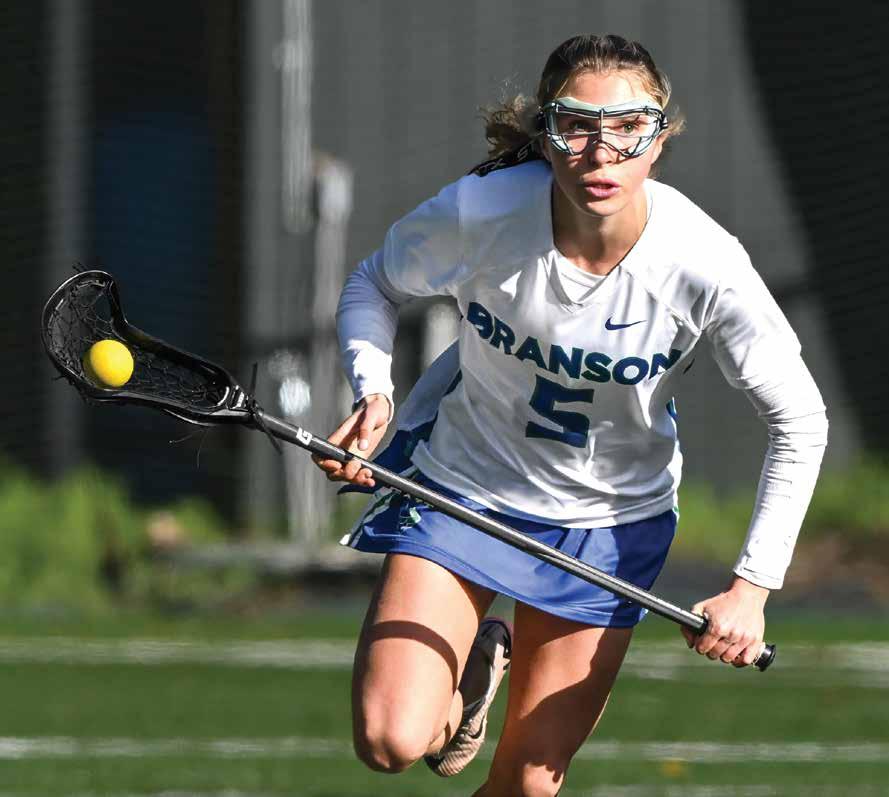
“I’m way too competitive,” Audrey Spaly says with a grin. “I love how in sports, competitiveness is a strength. On the field or the course, I get to let that part of me shine. It’s freeing—I’m not holding anything back.” Though she only joined the Varsity Cross Country team her senior year, Audrey stunned even herself by clinching the Branson team’s win at the CIF State Division 5 Girls’ Championship. “I was so nervous. I hadn’t been racing as well as I knew I could and it was my final race. I saw the other girl coming up behind me and told myself, ‘She’s not passing me.’ I crossed the finish line. Someone said we might have won. I’d hit my time goal. We had won. I just started crying. I felt everything at once.” That same drive fuels her on the lacrosse field, where she has helped to transform a fledgling program into a team that can seriously compete in the MCAL. “When I believe in something, I lead naturally,” Audrey says. It’s all about showing up every day, putting in the work, and setting the tone for the team. Branson girls lacrosse coach Ashton Richards puts it simply: “I’ve coached women’s sports for 35 years—including future Olympians—and Audrey is in my top five. She’s extraordinary. The motor inside that kid is unrivaled.” A three-sport athlete and captain, Audrey doesn’t compete for recognition—she does it because she’s wired to work hard and push herself. “Being a leader on the field has helped me learn how to be a leader in other parts of my life. It’s like muscle memory; in the classroom or in a group project, I’ll speak up a lot. I’m not afraid to say the wrong answer.” This fall, she’ll take that mindset with her to Columbia University where she’ll play on the Women’s Lacrosse team—ready for whatever comes next.
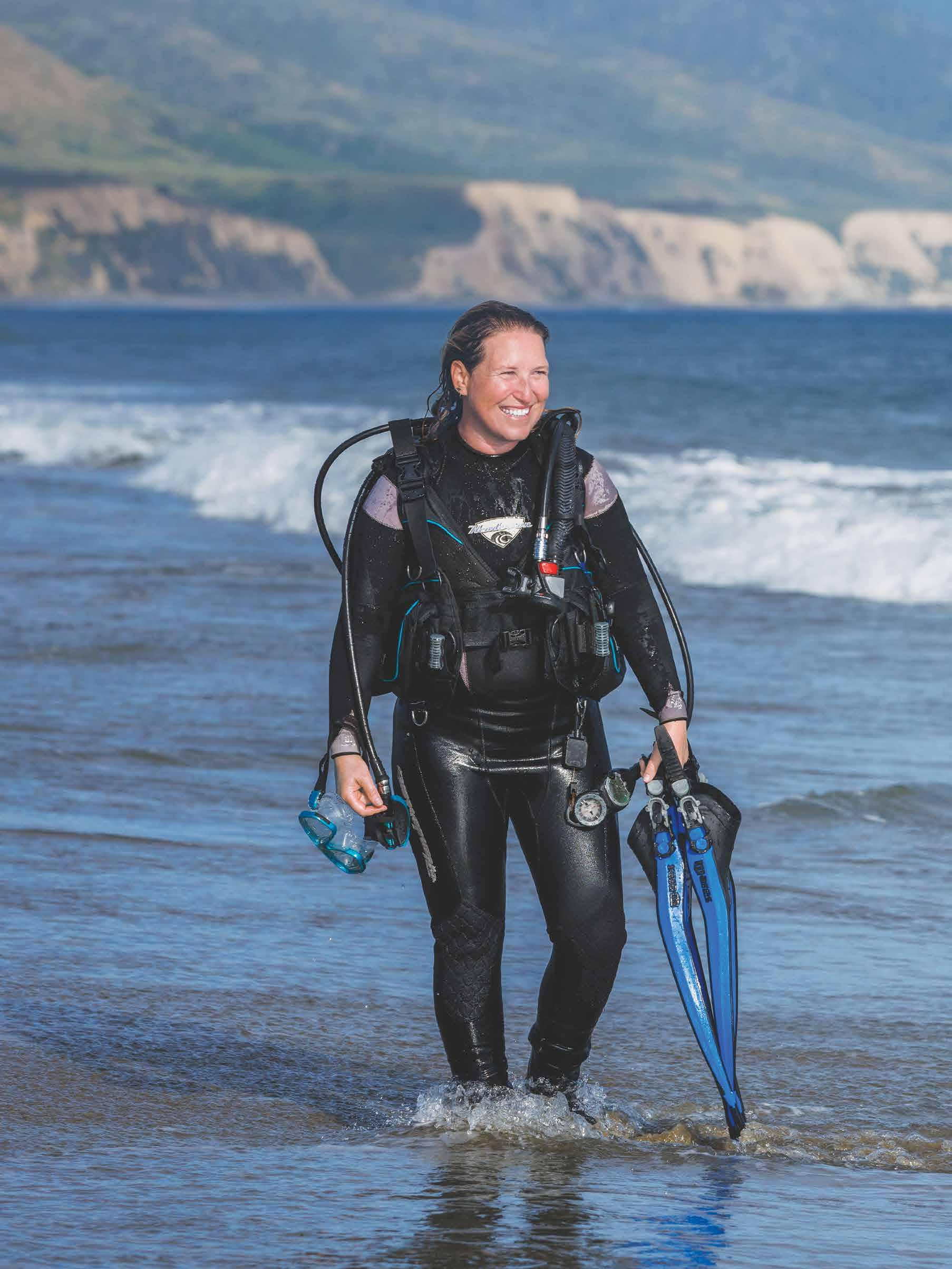

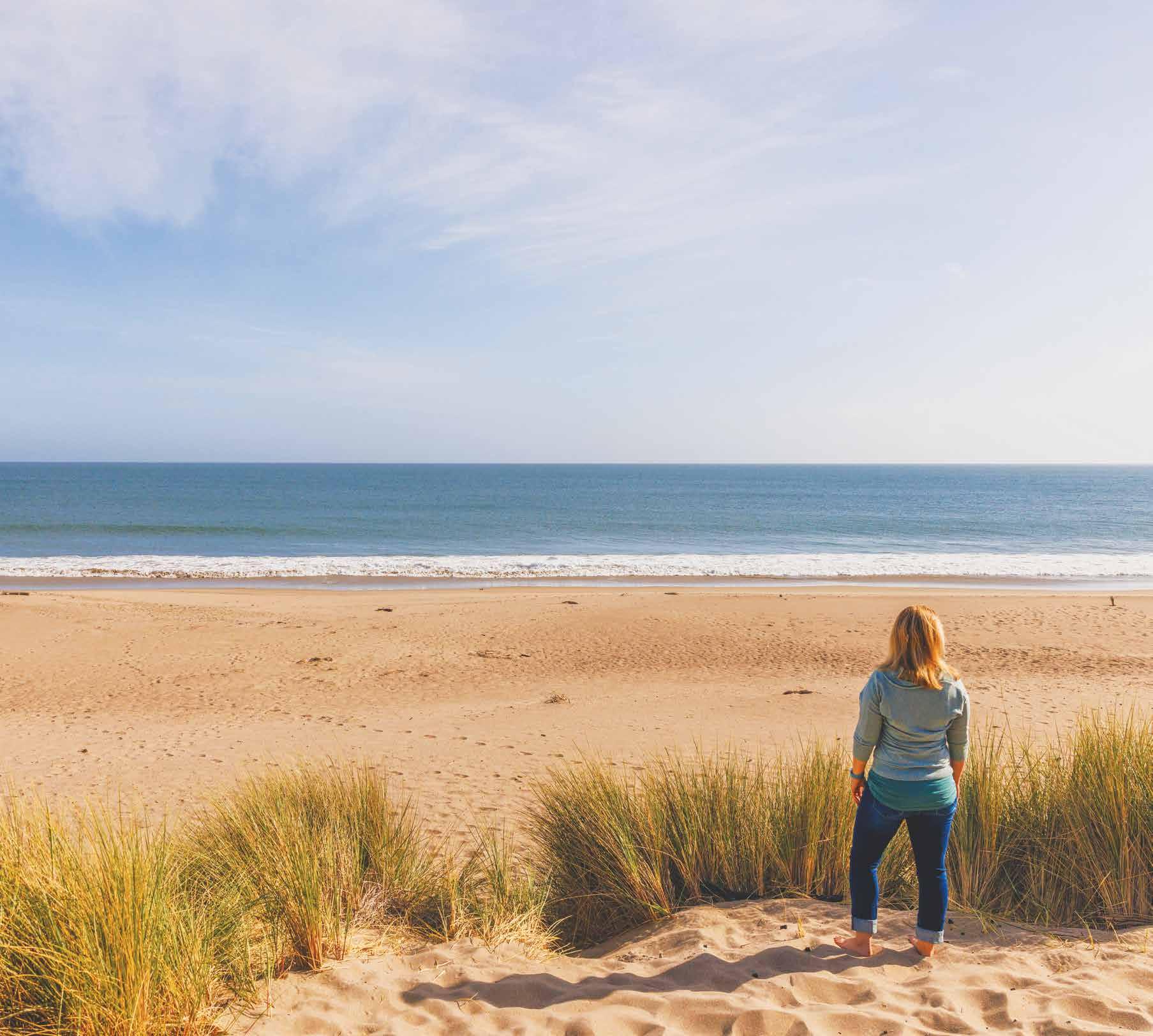
By Julie Doherty Meade ‘94
When
Laure Katz 02 reflects on her career in ocean conservation, she often begins with a story about lobsters.
She had spent the summer of 2001 studying marine biology on a remote island in Turks and Caicos on a Branson Junior Fellowship.
Toward summer’s end, she noticed something unusual. Two aisles in the island’s tiny market had been emptied and restocked with bottles of bleach. Mystified, Laure soon learned that the island’s short but highly profitable lobster season had just opened. In a practice not uncommon in lobster fishing, free divers in Turks and Caicos inject bleach into the craggy rocks on the ocean floor, forcing lobsters from their dens so they can be more easily harvested.
After spending the summer among the fishing community, Laure knew that locals cherished their reef and depended on the ocean for survival. She also knew that they understood the harmful effects of injecting bleach into a delicate marine ecosystem. “They didn’t need more data. They knew things that science doesn’t know,” Laure explains. “They needed an alternative.”
It was a transformative moment for the ocean-obsessed high schooler, who until that time had envisioned a career as a marine biologist. “I am a scientist, and I believe in science deeply,” Laure says.
“But my purpose shifted from wanting to explore and learn to wanting to work with people—to find solutions that are going to actually work for them.”
Today, Laure is a leader in communitybased marine conservation as the vice president at Blue Nature Alliance, a division of Conservation International, where she oversees a broad, multi-national effort to protect ocean ecosystems. The organization’s current goal is to protect 5% of the global seas— an area almost the size of North America and South America.
For Laure, it is the continuation of a lifelong vision for both the oceans she loves and communities that live beside them—a vision that has taken her from East Indonesia to Antarctica, and has its roots in a Marin lagoon and a passion for swimming with sharks.
Laure’s love affair with the ocean has been a constant since early childhood. She grew up swimming in the lagoon behind her Larkspur, California home and playing in the waves along the coast. At age 12, she took a one-day dive course on Australia’s Great Barrier Reef, where she was delighted to be followed by a baby blacktip reef shark. Surfacing, Laure promptly informed her family that she’d found her life’s work.
The next year she completed her scuba diving certification in Monterey Bay and was already an “avid diver” when she started at Branson in 1998. There, she met biology teacher Kathy Soave, an early mentor—and still a friend today. “We would drive down to Point Lobos, or to the coast near Big Sur, and have ourselves a dive day,” says Laure, noting that exploring the ocean with an enthusiastic marine biology teacher is “the most fun way to build out your dive skills.”
Branson was also the beginning of Laure’s experience in scientific research. Under Kathy’s guidance, Laure and a team of students started monitoring tidepools at Duxbury Reef, near Bolinas—work that often required grueling break-of-dawn wakeup times. The program, known as Sustainable Seas, continued long after Laure’s graduation, eventually compiling enough meaningful data for Kathy and her students to publish their findings.
While passionate about diving and research, Laure remained committed to uniting marine protection with practicable solutions for human communities. At Stanford University, in lieu of marine biology studies, she completed undergraduate and graduate degrees in earth systems, an interdisciplinary environmental studies program that blends coursework in science, economics, anthropology, law, and communications. Laure also spent plenty of time in and on the water, sailing a tall ship across the Pacific as part of Stanford at Sea, studying in the Galapagos Islands, and completing a master’s fellowship at the Woods Hole Oceanographic Institute in Massachusetts.
a tall ship or swimming with sharks, it gave her the financial and management skills to build the fund and to help her segue into a leadership role at Conservation International.
Today, Laure is again based in Larkspur, where she oversees Blue Nature Alliance’s partnerships with 113 groups across the world, “from the poles to the tropics to the high seas, and in all five ocean basins.” Her vision for ocean protection is mirrored in Conservation International’s approach, which she describes as “dedicated to the conservation of our natural world, but with an understanding that nature and people are connected.”
• • •
Along the jigsaw coastline of West Papua, Indonesia, more than 2,500 reefs and small islands give shelter to an astonishing diversity of coral and marine life. Here, the expansive Bird’s Head Seascape is a refuge for birds and rays, nesting ground for sea turtles, and home to over 1,800 species of reef fish.
Arriving there in 2008 after graduate school, Laure reports that Papua is where her “actual education” took place. As part of Conservation International’s project in the Bird’s Head Seascape, Laure spent four years in the field studying the environmental challenges and “working directly with indigenous communities that had a vision of protecting areas of the ocean that they had tenure rights to.”
After building a coalition of support, she then spent another five years on the island creating the Blue Abadi Fund, a long-term endowment that would provide resources to local conservation programs, protecting this vital seascape in perpetuity. “To start my career learning from communities in the epicenter of all marine life, and then being able to stand by their side while they protected huge areas of the ocean—that has been the most enriching and impactful program that I’ve ever been a part of,” Laure says.
The challenges of setting up a large, complex endowment led Laure to complete a global MBA at the University of Virginia’s Darden Business School. Though she admits that business school was less thrilling than sailing
Laure talks about her work with gratitude and humility — qualities that have been vital to her success. She is practical, warm-hearted, and down-to-earth. “The thing that has made me most successful is deep listening: approaching the work not with science, but with human empathy and curiosity,” Laure says. “Taking the time to listen and form real relationships with people is where the magic of the right solutions emerges.”
In many of the communities she collaborates with today, Laure sees the same challenges that faced the lobster fisheries in Turks and Caicos. Finding balanced solutions, which promote both human welfare and ocean health, is her life’s purpose—and something she intends to continue, with enthusiasm, into the future.
“Being able to work with communities on every part of this planet has been the absolute greatest privilege of my career,” Laure continues. “I have learned from people in Papua and in Kiribati and in Kenya. Last year I was in Rapa Nui and the year before I was in the Arctic with Inuit. There are so many incredible champions around the world doing brave and brilliant work.”
That said, there is one outstanding item on Laure’s to-do list. She’s overdue for a return visit to Bird’s Head Seascape, where she’s eager to go diving with her husband and two young children. In what is an almost irresistible enticement, she’s heard that the waters are currently teeming with sharks.
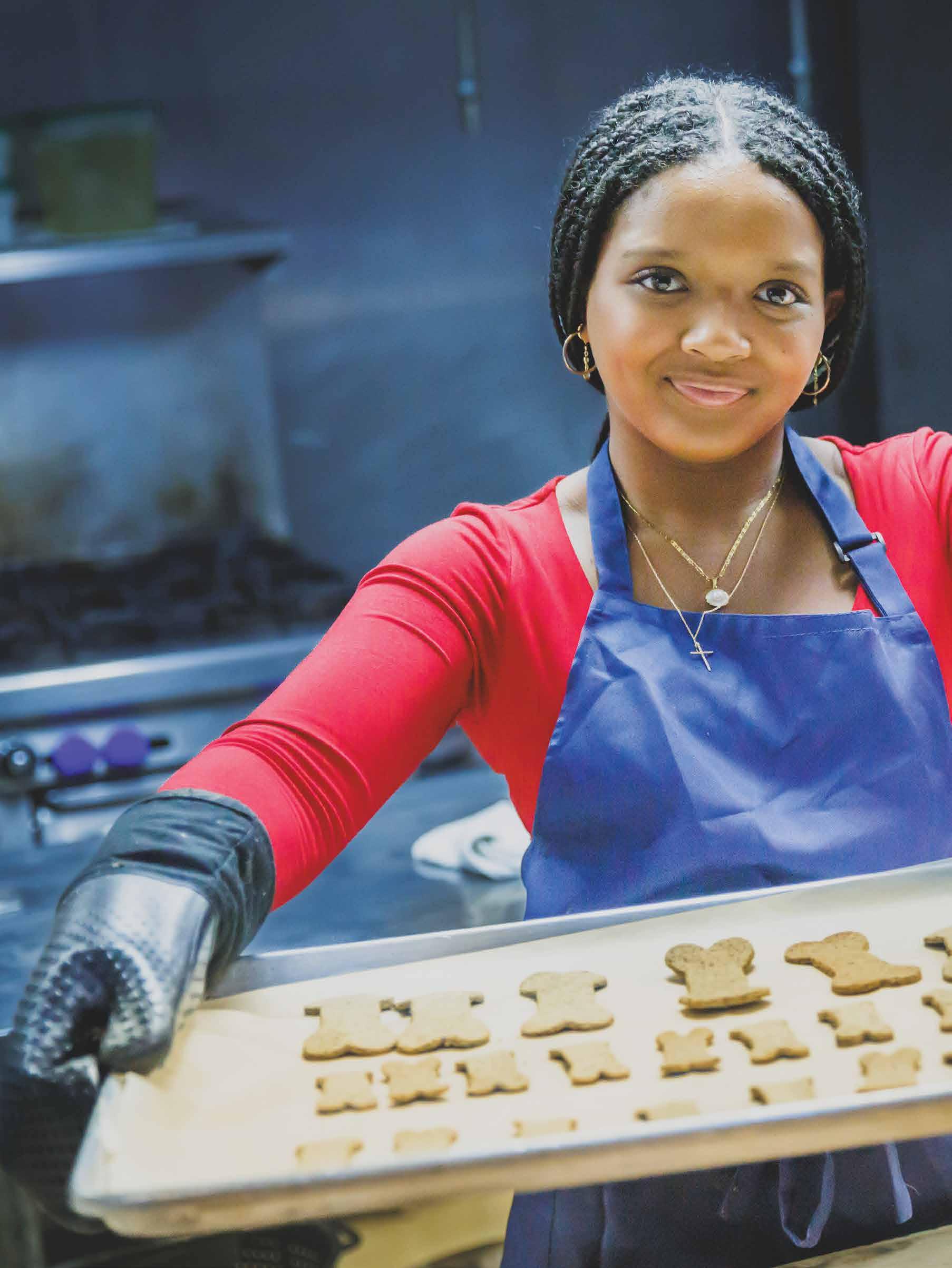
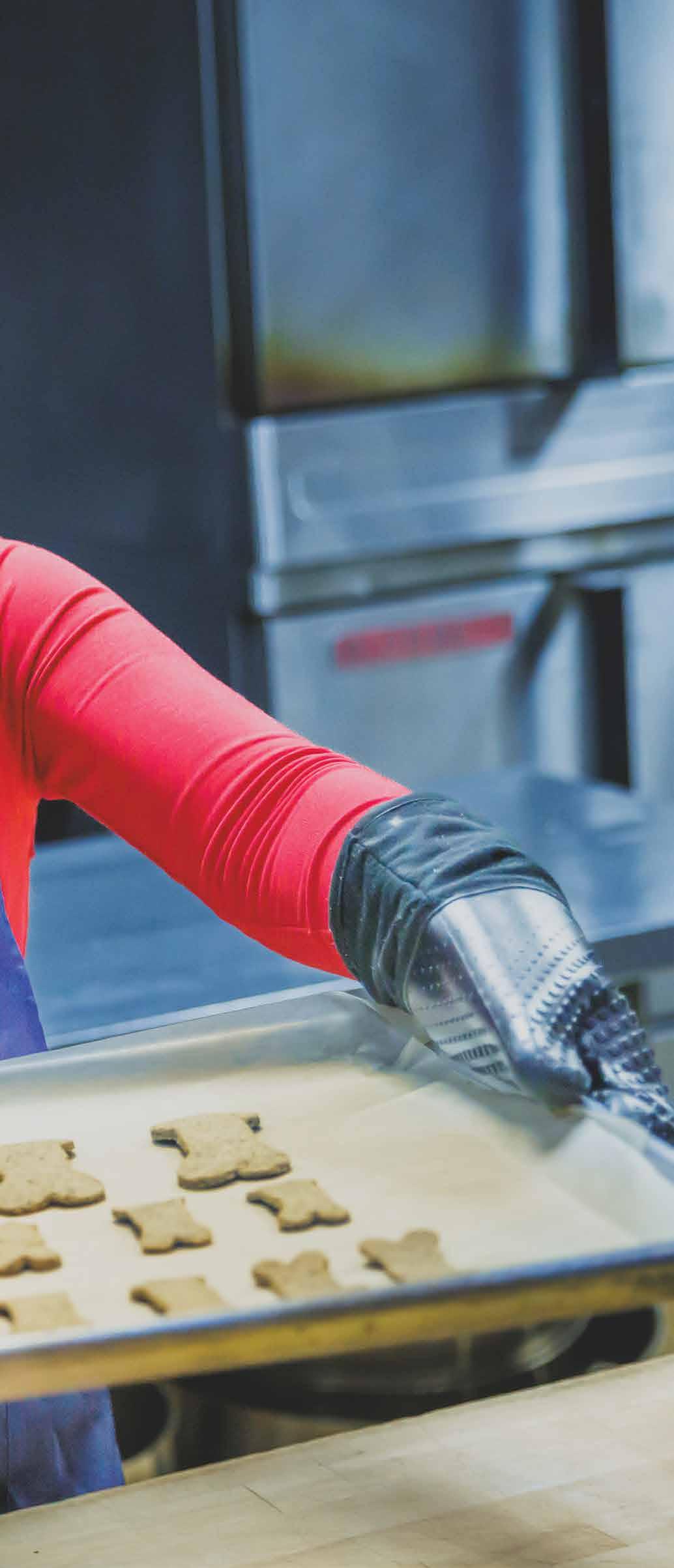
by Sara Braun ‘16 Branson’s Young Entrepreneurs
For her tenth birthday, Jasmine ThomasGainey ‘28 received presents that likely wouldn’t be found on any other child’s wishlist: a food dehydrator, a bag sealer, and baking molds. But it was exactly what she wanted. A couple of months earlier, Jasmine had asked her parents if she could start a dog treat business. It was an idea that combined her two passions: baking and dogs. In response to their daughter’s query, Jasmine’s parents challenged her to create a business plan. Not only did she accept that challenge, she also created three original recipes. And so Doggy Dog Treats by Jazzy was born. The goal was simple: bake and sell healthy dog treats made with simple ingredients and no artificial flavors or preservatives.
She began making the treats at home with her parents and selling them on Etsy in 2020, but demand quickly grew. Now, she’s a licensed business owner and works out of a commercial kitchen on Treasure Island. Her products are sold both online and in various pet stores across Marin County.
For years, Jasmine shied away from talking about her business with peers. But recently, she has embraced her dual roles as both student and business owner. “I [am starting to] talk about it more. People see my work, and they [say] ‘Oh, this is really cool, she’s dedicated to what she’s doing,” she explains.
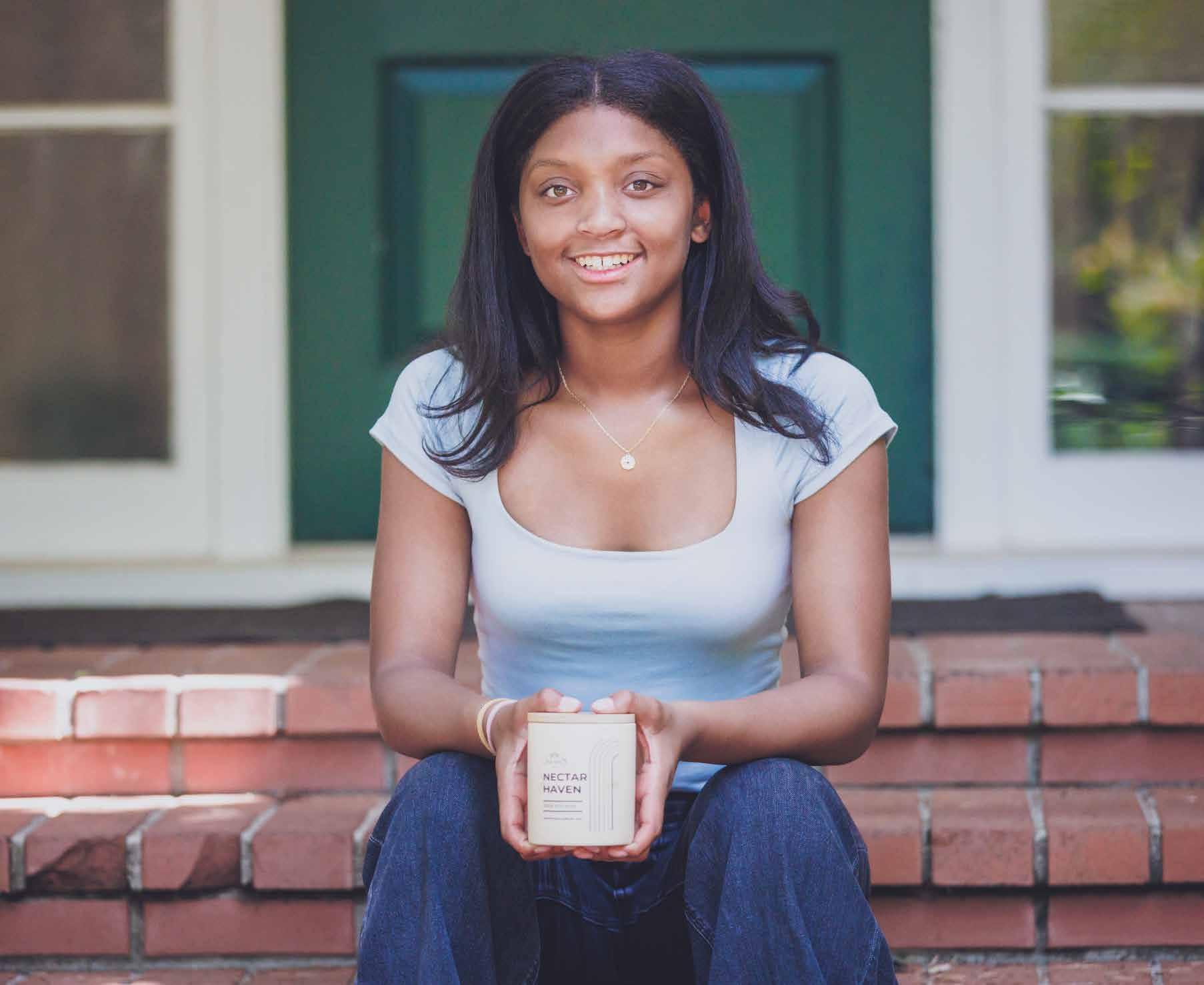
“ People want to see me succeed. So it pushes me even further to be able to get to where I want to be.”
2020 was also the year that Juliette Caldwell-Little ‘28 found her entrepreneurial spark with the creation of her own company, Juju’s Candles. At the height of the pandemic, she began crafting and selling soy wax candles. Her goal was to bring some comfort and light to people’s homes in a time when they were largely stuck inside.
Over the past five years, the business has grown, and Juliette has sold thousands of candles. One thing, however, has stayed constant: she still makes all of the candles herself in her family’s garage. But now, Juliette is able to sell in-person at events like San Francisco’s Juneteenth Parade and the Black Joy Parade in Oakland. Customers can order candles online, in signature scents such as Sweet Leaves, which Juliette describes as “woodsy, with some sweetness to it,” or Citrus Zest. They can also request custom candles for special events,
such as baby showers, birthdays, or weddings. One of her specialties is a mixtape candle, where customers can send in a playlist to go along with a candle, and she’ll make a QR code for the label. They’re especially popular for Valentine’s Day.
Since Juliette began Juju’s Candles when she was only in elementary school, her parents played a role in helping spread the word to friends and neighbors, as well as teaching her how to manage the business’s money. Now, she brings the skills she’s learned with her to Branson: financial literacy, problem solving, and customer satisfaction. They are also skills that she hopes to utilize as a doctor one day.
Juliette is the first to admit that starting a business hasn’t been without its challenges, especially when it comes to time management.
“I try to make candles in the summer when I have most of my free time,” she says. With a focus on marketing the brand on social media this summer, Juliette hopes to expand Juju’s Candles into major retailers like Target or Bath & Body Works. “I definitely want to keep it going for as long as I can,” she says.
Jasmine and Juliette are two of the many Branson students who have utilized their creativity and innovative thinking to become successful entrepreneurs. Branson students can find their calling anywhere you can think of—even in their own kitchen or garage. Some, like Jasmine and Juliette, hone their entrepreneurial spirit at a young age. For others, their time spent in the classroom has led them to create tools that address the real-life problems they encounter in their day-to-day lives.
• • •
It was in Percival Barretto-Ko’s Entrepreneurship class that Katie Warrin ‘26 realized her business savvy. “It opened my eyes up to how I wanted to pursue business,” she remembers. She went on to start the Entrepreneurship Club at Branson, with Mr. Barretto-Ko serving as an advisor. Katie wanted her friends and classmates to have an opportunity to learn the skills and concepts that she did, and to tap into their own entrepreneurial spirit. “It’s been really nice to use what I learned to teach some of the other people at the school and maybe get them interested in taking the class themselves,” she says.
Recently, the club participated in the MIT Entrepreneurship Club competition. Katie and her group submitted a proposal for sustainable energy, in which algae carbon capture would be used to power San Francisco.
Like Katie, Peter Hudson ‘25 developed an interest in problem solving in the Entrepreneurship class. “That class definitely gets you thinking outside of the box, and I think that’s a good skill to have, both in the classroom and out of it,” he says. He found it useful to look at problems from various perspectives and not accept only one right answer. He learned that there are endless ways to make change.
Peter decided to make change by creating the first-ever job fair at Branson. After pitching his idea to the administration, they granted him approval to hold the fair on campus. He scouted local employers around Marin, going door-to-door and handing out flyers to gauge interest in hiring Branson students for the summer. “I took on the heavy lifting of getting the businesses,” he recalls. He had a very clear vision for what he wanted the job fair to look like: instead of the usual internships, he wanted to recruit local retailers, restaurants, and camps.
Peter’s persistence paid off, as employers like the Marin County Fair and restaurants in Tiburon and Sausalito gathered in the Gym to meet students. “I was a little bit nervous on the day, but I think people got jobs, and that made me happy,” he says.
• • •
Several years earlier, Amrit Baveja ‘21 also sought to fill a gap with a new invention. But it was his own personal challenges that inspired him to create a scheduling app while at Branson. “I [have] ADHD. I [can be] all over the place and have a very hard time staying on track of things. And I looked at the six-day schedule rotation, and I was like, ‘Oh my God, I’m going to miss all my classes because it’s too hard to keep track,” he recalls. What began as a useful tool to help him stay organized became a “pretty big deal on campus,” he remembers. “I’d always been a pretty shy person, and I think seeing that kind of validation, being able to kind of help people in that way, did give me a little more encouragement to pursue other projects that I might not have, had that experience not happened.”
It was Amrit’s second project that proved just how much his entrepreneurship could help his community. In 2020, alongside his friend Beck Lorsch, he created MarinTrace, a non-profit COVID-19 contact-tracing app and management platform for schools in the Bay Area. Amrit’s role involved designing algorithms, building the core software, and securing contracts for the app. He worked closely with healthcare providers, the Marin County Office of Education, and other stakeholders so that the app could facilitate the re-opening of schools amid the pandemic. “I had seen the impact [that the COVID-19 lockdown] was having on my
friends. And personally, I wasn’t really happy with staying home,” he says. “I felt like a lot of important things in my life were missing.”
Amrit first piloted the program with 30 Branson students and spent the entire summer between his junior and senior year working on improving the app. “We thought a lot about the implementation [in an effort] to create a system that was secure [and] abided by the different regulatory standards,” he remembers. As the pandemic evolved, so did MarinTrace, as he updated the app to include important markers like vaccination status.
Amrit attributes much of MarinTrace’s success to the support he received from the Branson community. His ingenuity has carried him from Branson to beyond, and he has taken the lessons he has learned through his previous entrepreneurial ventures into his time at Stanford, where he just completed his third year studying computer science.
“You’re relying on your gut a lot [with startups], which I think is good. But the more you can ground that in quantitative details, the better,” he suggests. “Keep collecting data, know when it’s time to pivot, when it’s time to change your outlook. It’s okay that it happens.” • • •
Branson students are never just one thing. They’re multi-hyphenates in the truest sense: students, athletes, artists, activists, and even entrepreneurs. And in whatever they do, they are driven by a shared sense of purpose. Jasmine, Katie, Peter, Juliette, and Amrit took on the title of entrepreneur in order to fill voids they saw in the world around them. They’ve faced pushback and adversity, especially because of their age.
Jasmine recalls going to farmers markets over the years with her family to sell her dog treats, where she encountered many customers who assumed that the business was her parents’. When they realized it’s Jasmine who is running the show, “it’s kind of this shock [that comes on their face],” she says. But shock gives way to encouragement, and like each of the others, she’s been lifted up by friends, family, and even strangers, to persist. “These people want to see me succeed. So it pushes me even further to be able to get to where I want to be.”
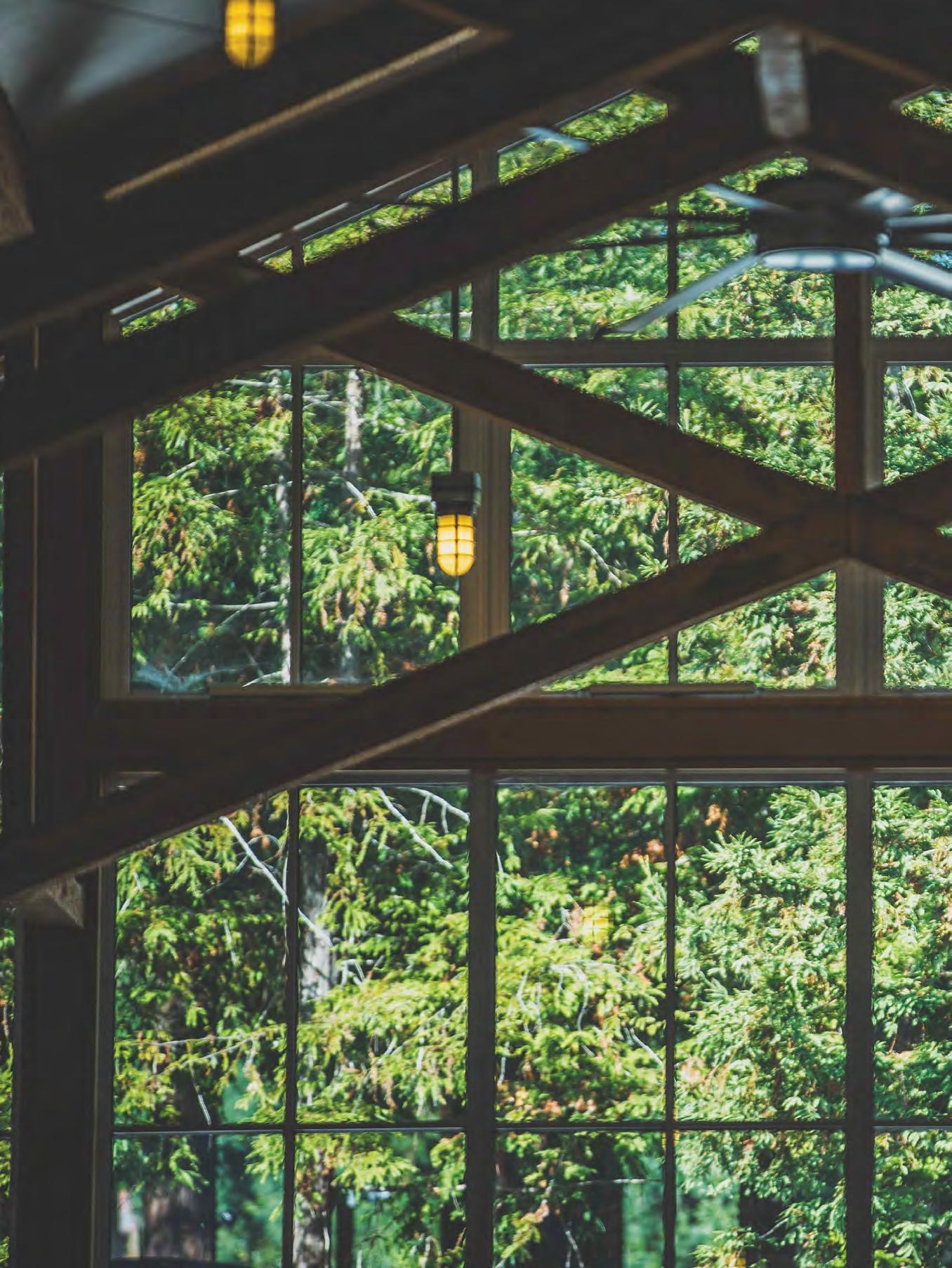
Christina Mazzola
Head of School
James Zimmerman
Chief Advancement Officer
Jennifer Owen-Blackmon
Director of Communications
Olivia Flemming
Assistant Director of Communications
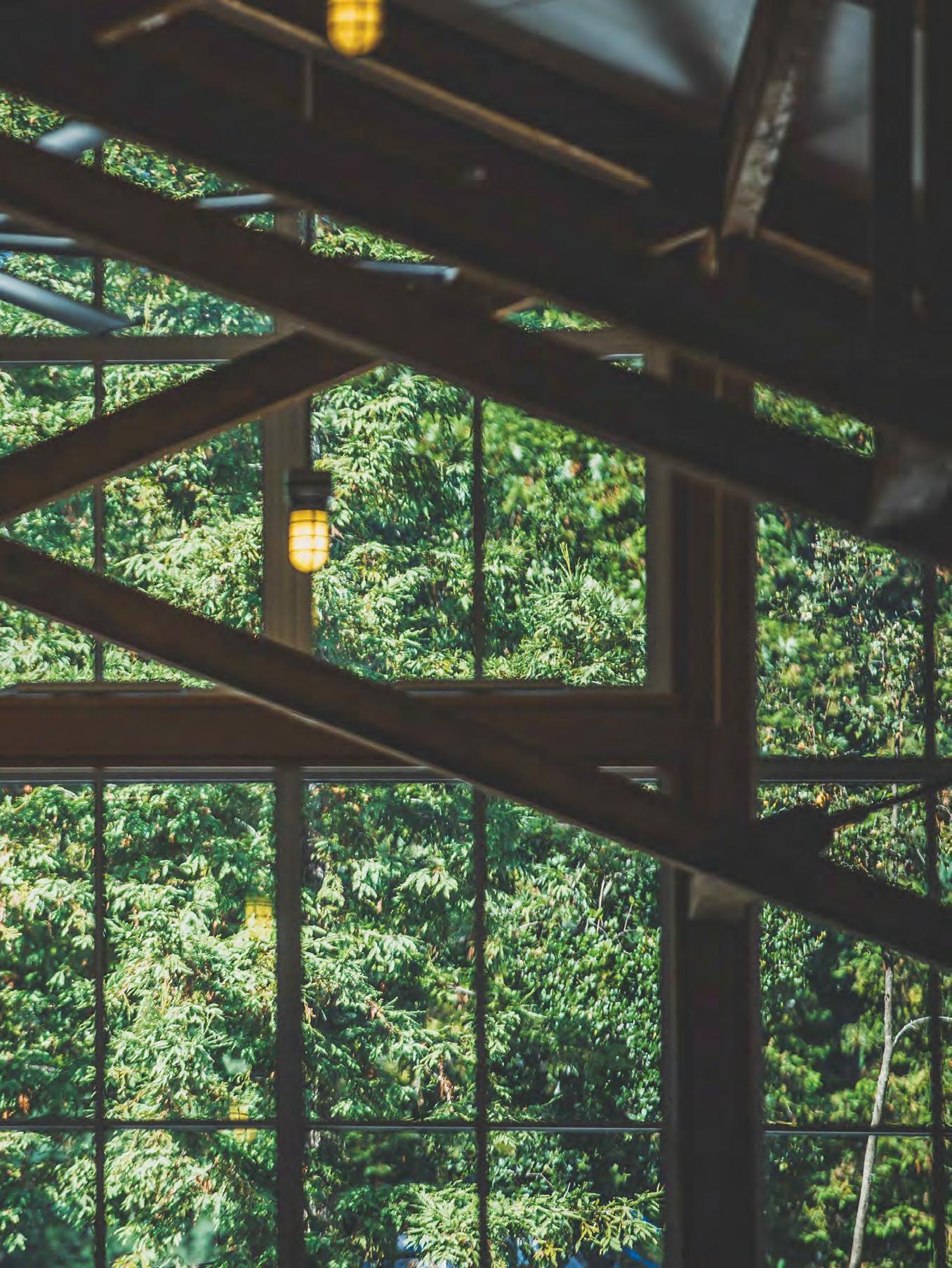
DESIGN
Dallas Duncan Design
WRITING
Sara Braun ’16 is a multimedia journalist based in New York City. Her work has previously appeared in Glamour, Betches, and Observer. Currently, she covers business trends and work culture for Fortune Pages 46-49
Susan Ditz ’68 is a Nevada-based journalist who has written for the San Jose Mercury News, Silicon Valley Business Journal, San Francisco Business Times, and was founding Managing Editor of Edible Silicon Valley. She previously directed marketing communications at Menlo School and the San Francisco Zoo. Pages 28-33
Tessa Fontaine ‘01, PhD, is the author of The Electric Woman: a Memoir in Death-Defying Acts and The Red Grove, a novel. She founded and runs The Accountability Workshops and teaches in the graduate creative writing program at Warren Wilson College. Pages 38-39
Andre Gray ‘05 is the chief activation/creative officer at Havas Lynx New York. His campaigns for JBL, Nissan, Ralph Lauren, Uber, and PayPal have won international awards including Cannes Lions, D&AD, One Show, and Clio Sport; he’s also served as juror for the Cannes Lions and One Show awards. He was named to Adweek’s “Creative Top 100.” Pages 16-19
Julie Doherty Meade ‘94 is a writer, editor, and guidebook author who has covered travel, art,
music, and culture for a range of media and publications, including New York Magazine, Billboard, and Hyperallergic. She splits time between Mexico City and Coatepec, Veracruz, in southern Mexico. Pages 42-45
Julia Flynn Siler ‘78 is a New York Times bestselling nonfiction author and journalist who’s been a visiting scholar in Oxford University’s Centre for Life-Writing this spring. Her most recent book, The White Devil’s Daughters: The Women Who Fought Slavery in San Francisco’s Chinatown, was a New York Times Editors’ Choice and a California Book Award finalist. Pages 6-11
Guy Raz P’27,’29 is the host and creator of several of the most well-known podcasts including How I Built This, Wow in the World, and The Great Creators. He previously spent 15 years as a TV and radio reporter for CNN and NPR where he covered war, peace, and everything in between from more than 45 countries. He is currently a Branson parent. Pages 34-37
Jessica Werner Zack ‘87, P’28 is an awardwinning cultural journalist who writes about the arts for the San Francisco Chronicle and other publications. She is currently a Branson parent. Pages 12-15
Bill Cotter is the Director of Programming at Students Shoulder-to-Shoulder where he creates programs for students to learn about ethical leadership while partnering with nonprofits around the world. Previously, Bill was an international educator in China, Mexico, and Peru. Pages 22, 26-27
Greg Jungferman is an award-winning sports photographer whose work is featured in Sports Illustrated, the San Francisco Chronicle, CBS Sports, MSN, MaxPreps, and SBLive. Page 41 (AS)
Steven Meckler is a commercial photographer living in Tucson, Arizona. His love of photography is grounded in the medium’s unique storytelling ability. Page 28
Kate Owen ‘06 is an award-winning photographer based in New York City whose
clients include Vogue, The New York Times, J.Crew, Banana Republic, Nike, and Fujifilm. Kate seeks out moments of unexpected joy in the pictures she makes. Her work often reveals a tongue-incheek sense of humor, and she hopes you can join her in the fun with a sly smile. Page 16
Eric Segura is a talented visual storyteller based in Costa Rica whose career spans the vibrant realm of music festivals, the refined artistry of gastronomy, and the captivating allure of lifestyle photography. His documentary photos have been featured in Condé Nast, NatGeo Travel, Billboard, Vox, and El País (Spain). Cover; Pages 2-3, 24-25
Michael Spengler was born in Japan, raised in Germany, and is now based in San Diego. He has shot commercial, creative, and editorial projects on three continents and 12 countries. He enjoys photographing people not because of their fame but because they are interesting, have something to say, or contribute to the world. Page 32
Ian Tuttle ‘99 is an award-winning commercial and editorial photographer focusing on real people at work, at play, and at ease. Based in San Francisco, Ian works with clients like CamelBak, Zoom, Cartier, and Google. Pages 34-36
Brian Wedge is a Marin and Hawaii-based, award-winning photojournalist, creative director and visual storyteller who collaborates with editorial, commercial, and education clients around the globe. His work has appeared in print and online with Patagonia, Lululemon, National Geographic, The New York Times, Stanford, and Yale, among others. Pages 4-5, 33, 40 (SL), 41 (CA), 42-44, 46-48, 50-51
Carter West ‘24 is a rising sophomore at the Rhode Island School of Design (RISD), where she is studying Apparel Design and the Theory and History of Art and Design. She is a multidisciplinary artist and works as a paint color consultant and a commissioned painter. Pages 38-39
Alison Yin is an award-winning photographer based in the East Bay who specializes in capturing people and events. She started her career as a photojournalist working at various publications around the country before landing in Oakland where she was immediately drawn to its community and inclusivity. Pages 6-8, 10, 11, 31
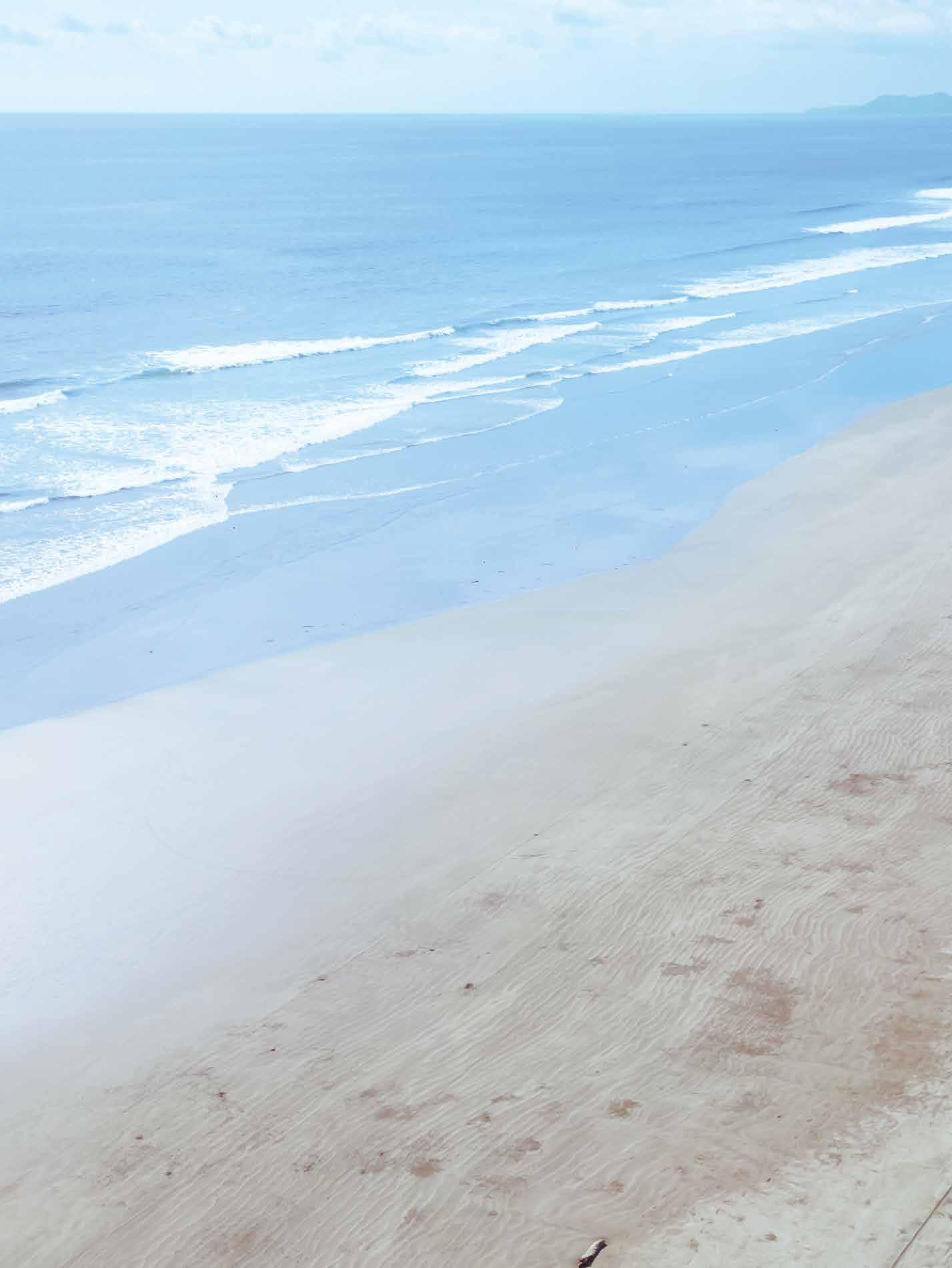
P.O. Box 887
39 Fernhill Ave, Ross, CA 94957
communications@branson.org